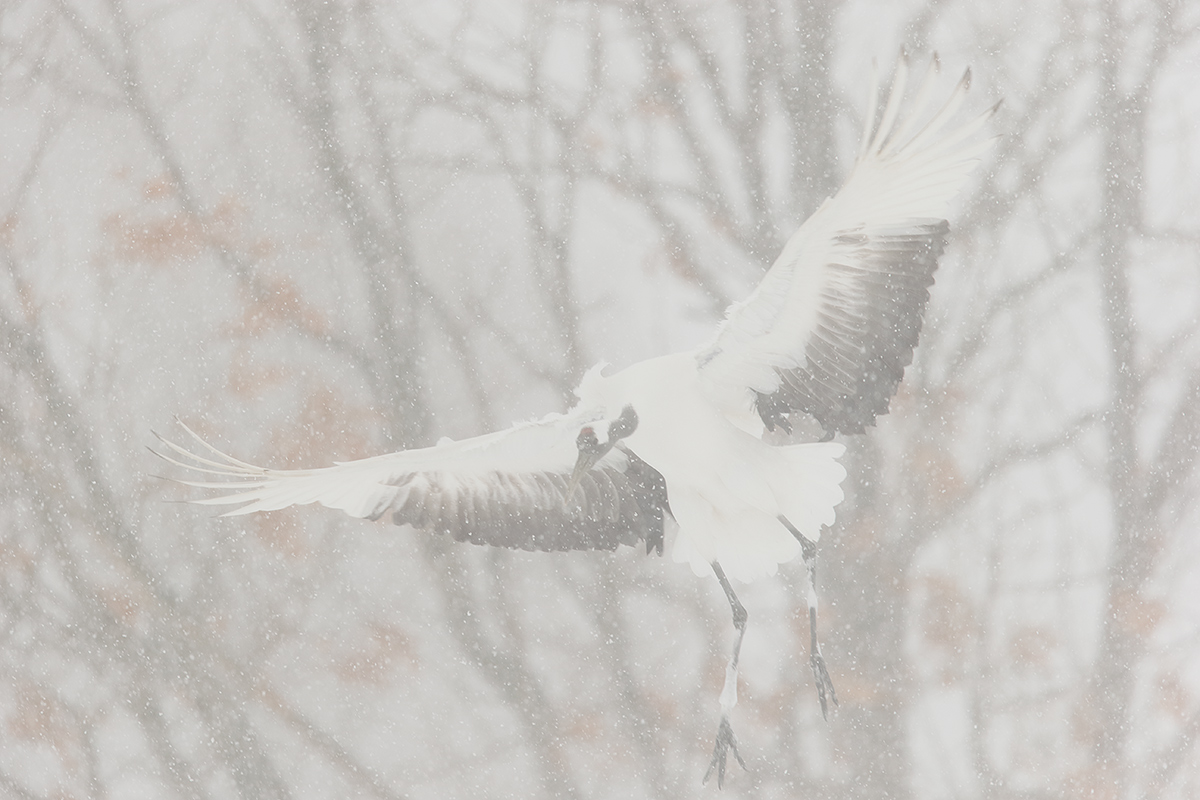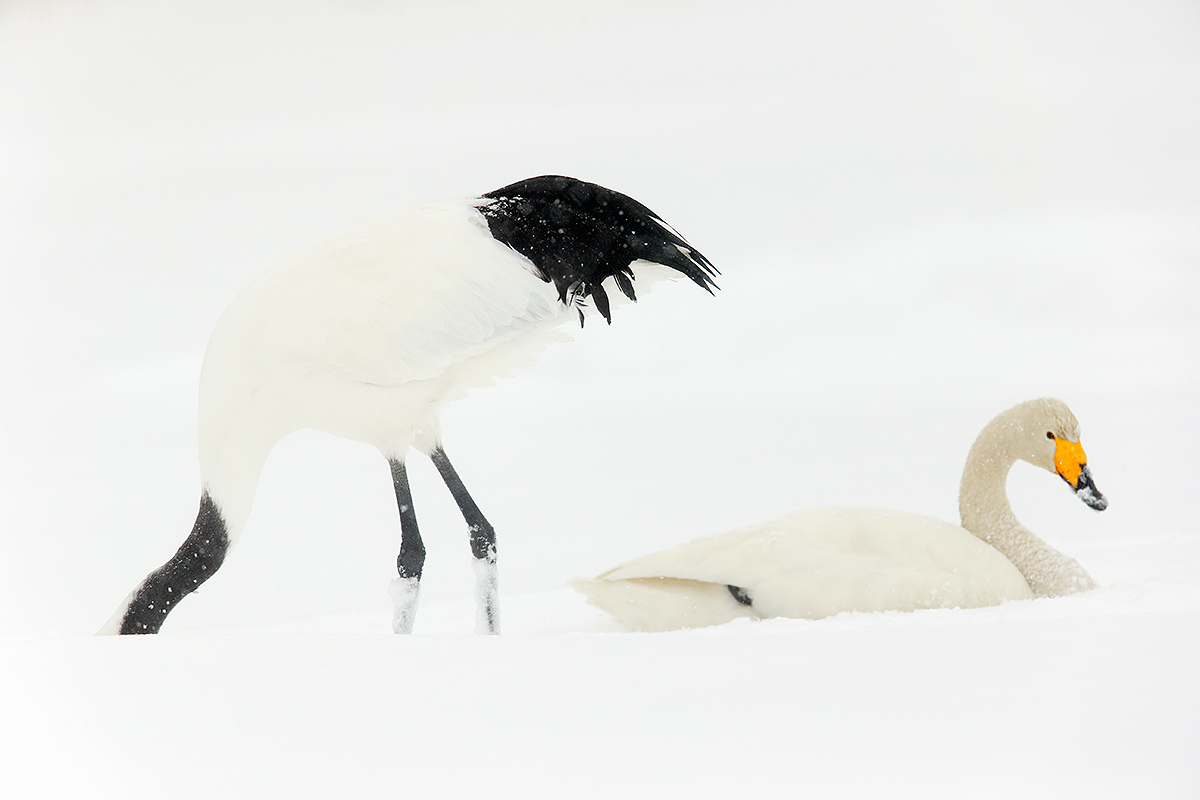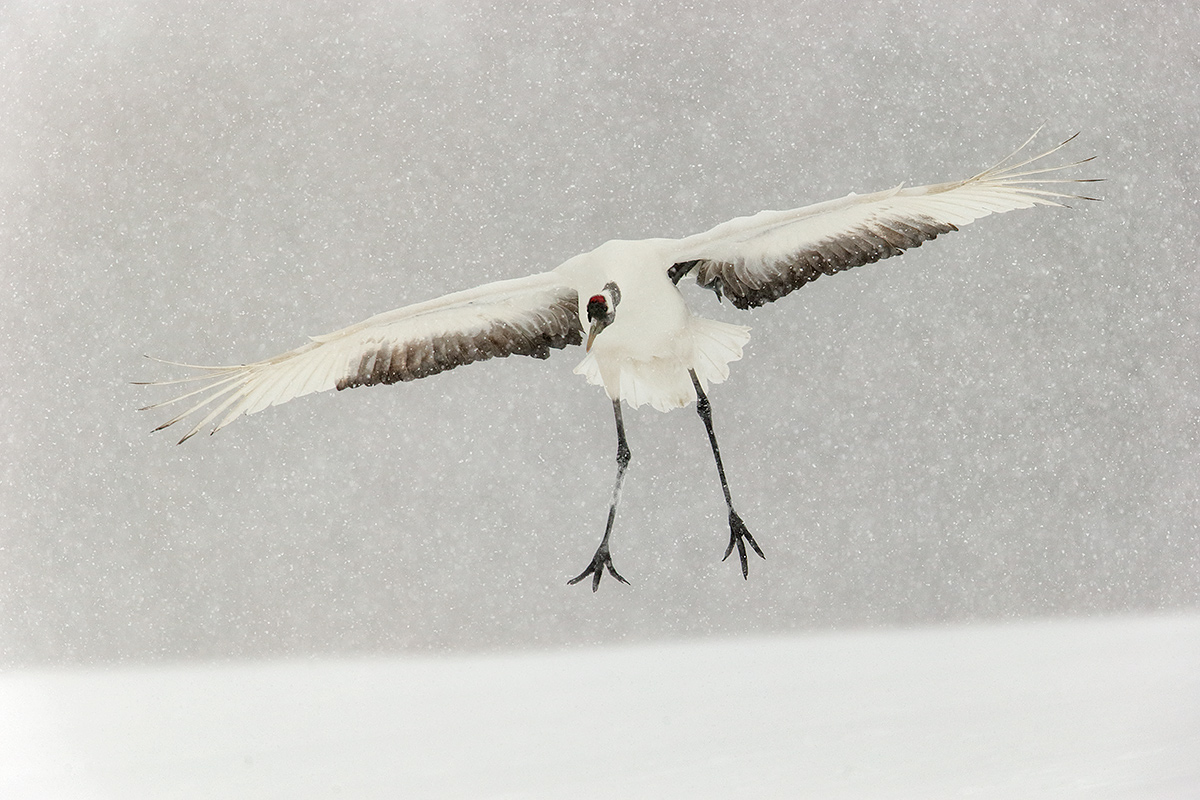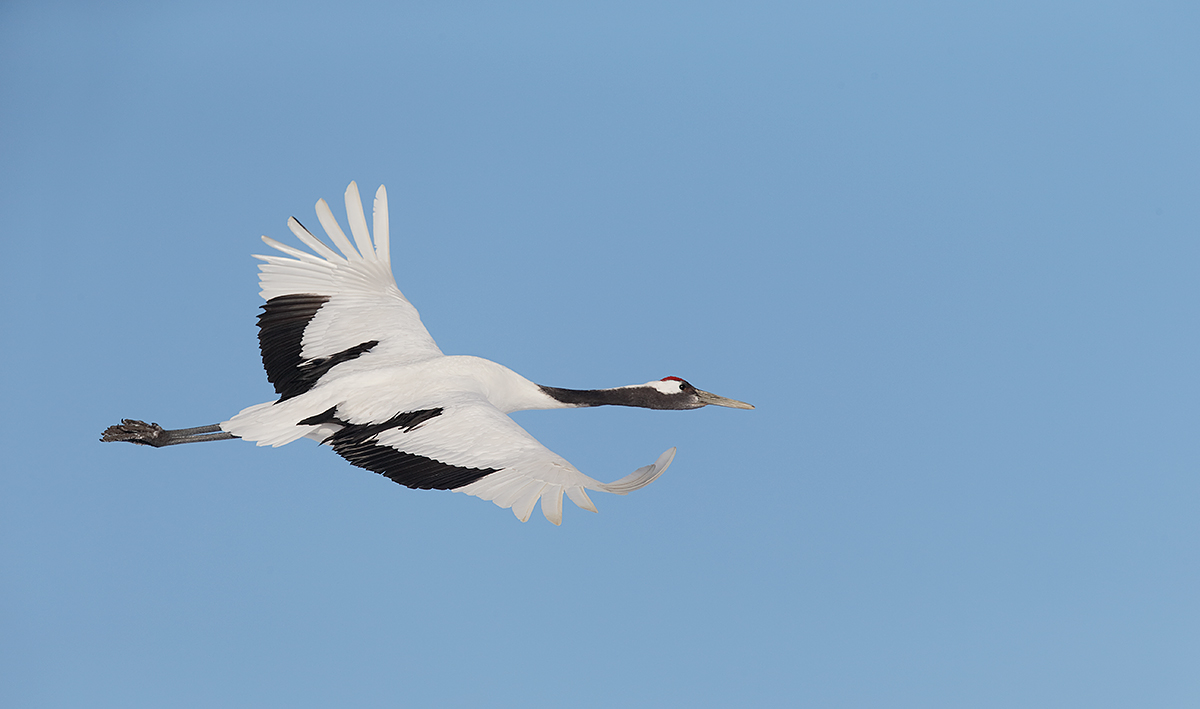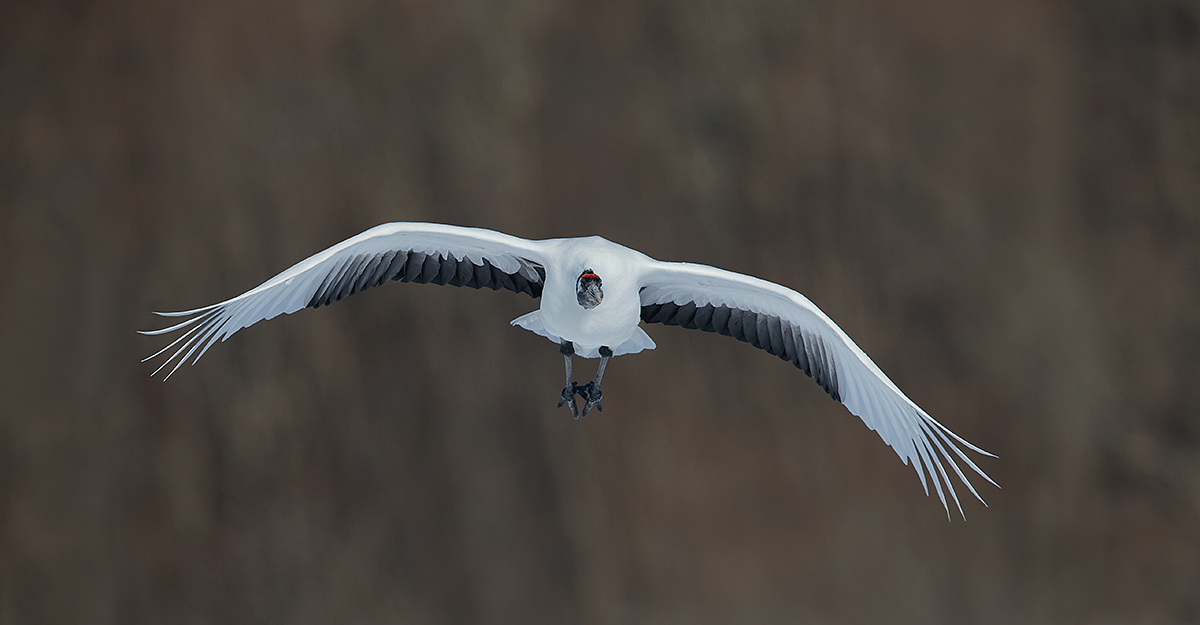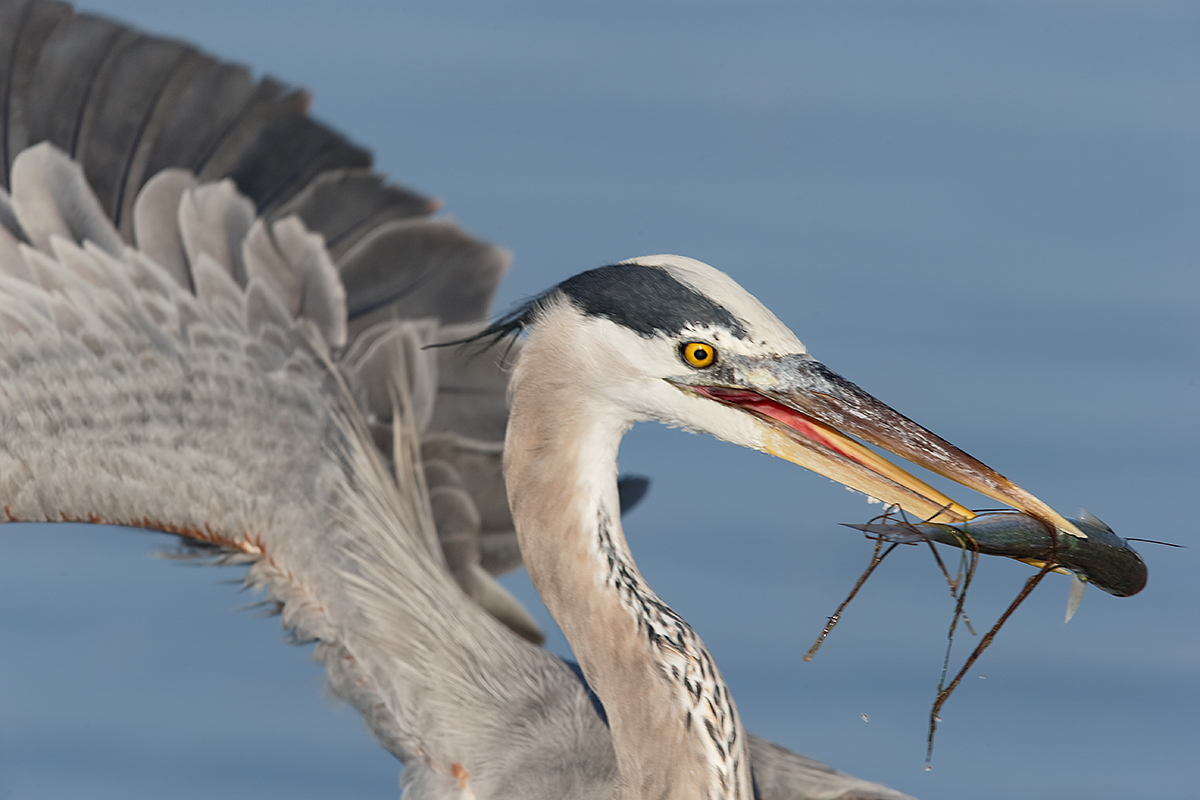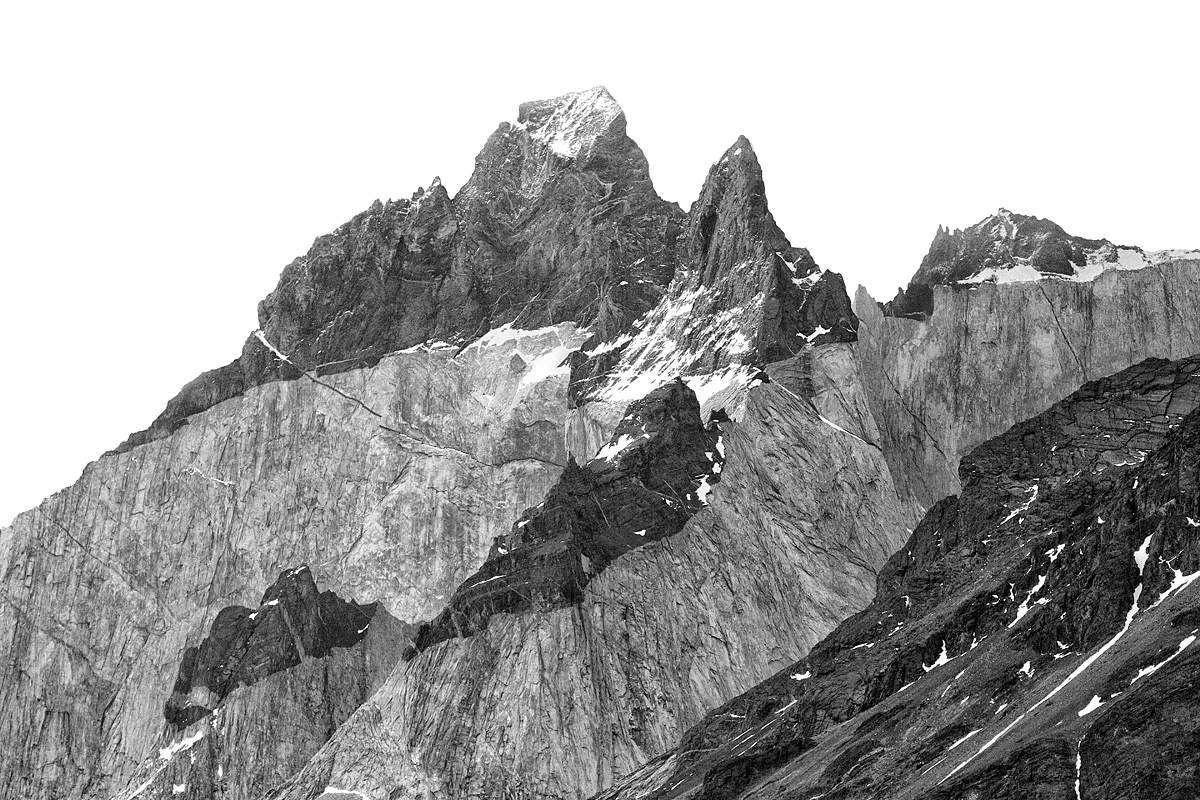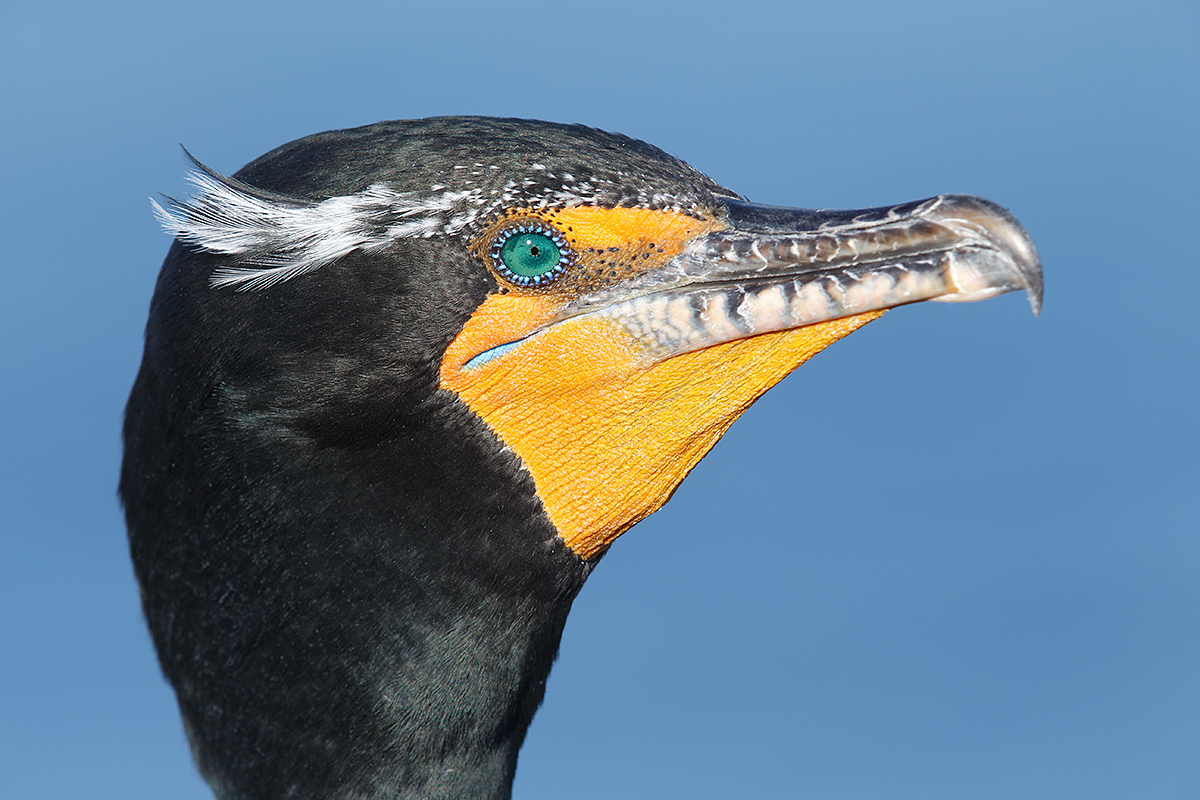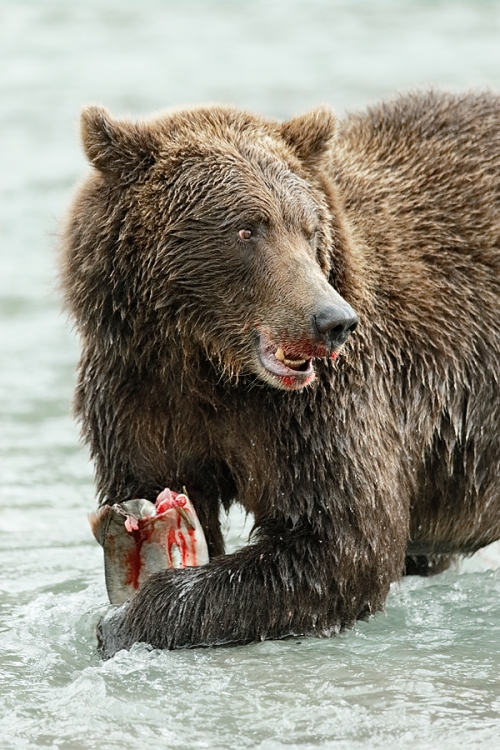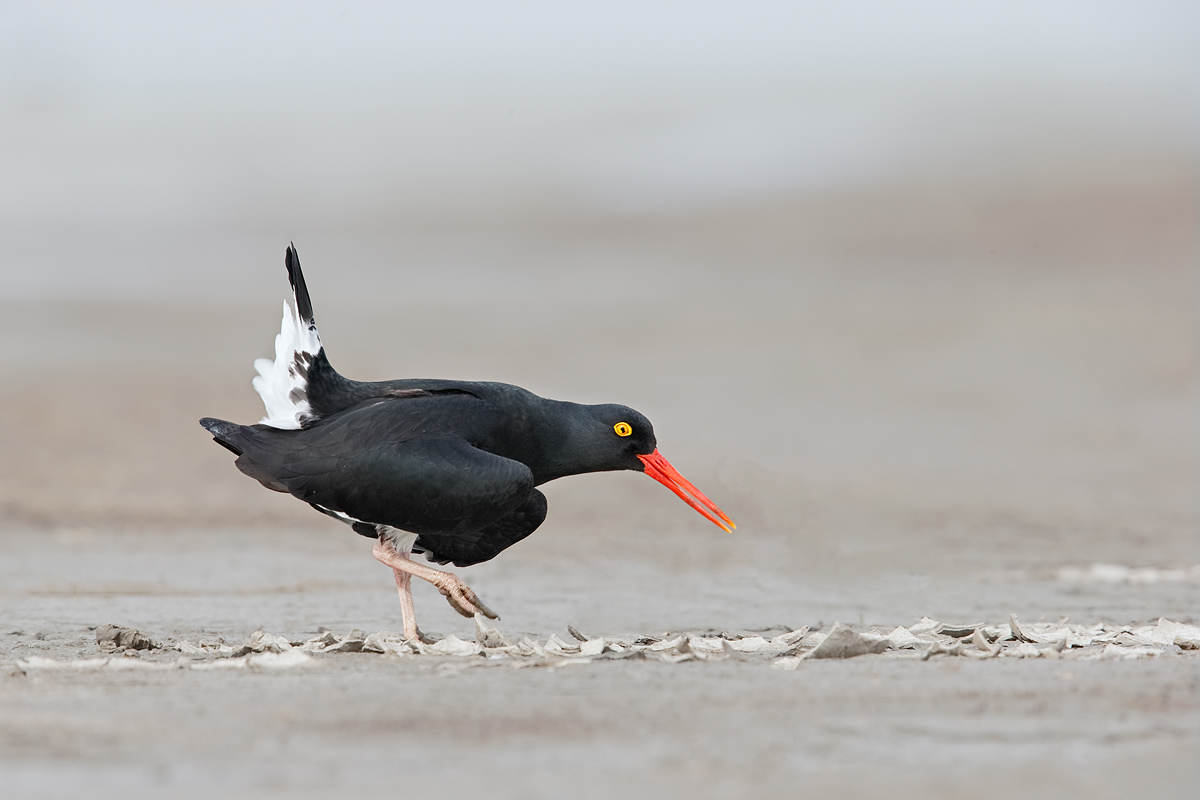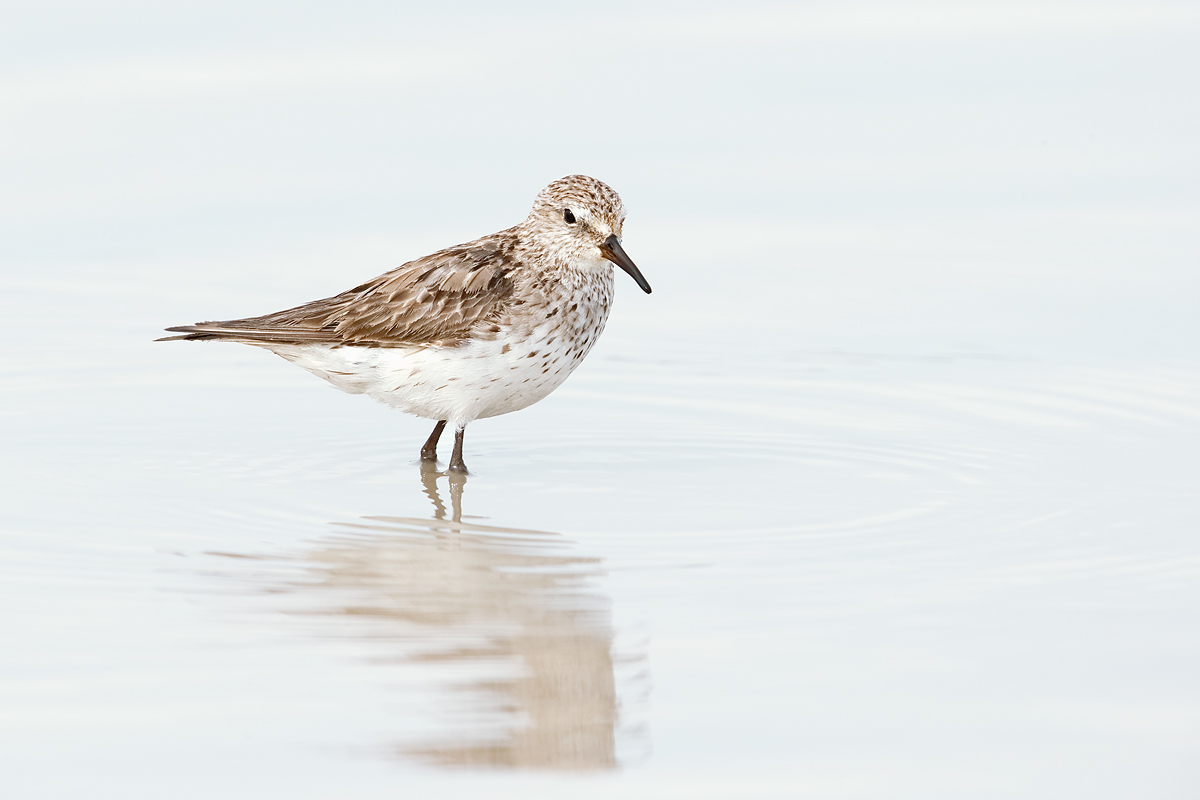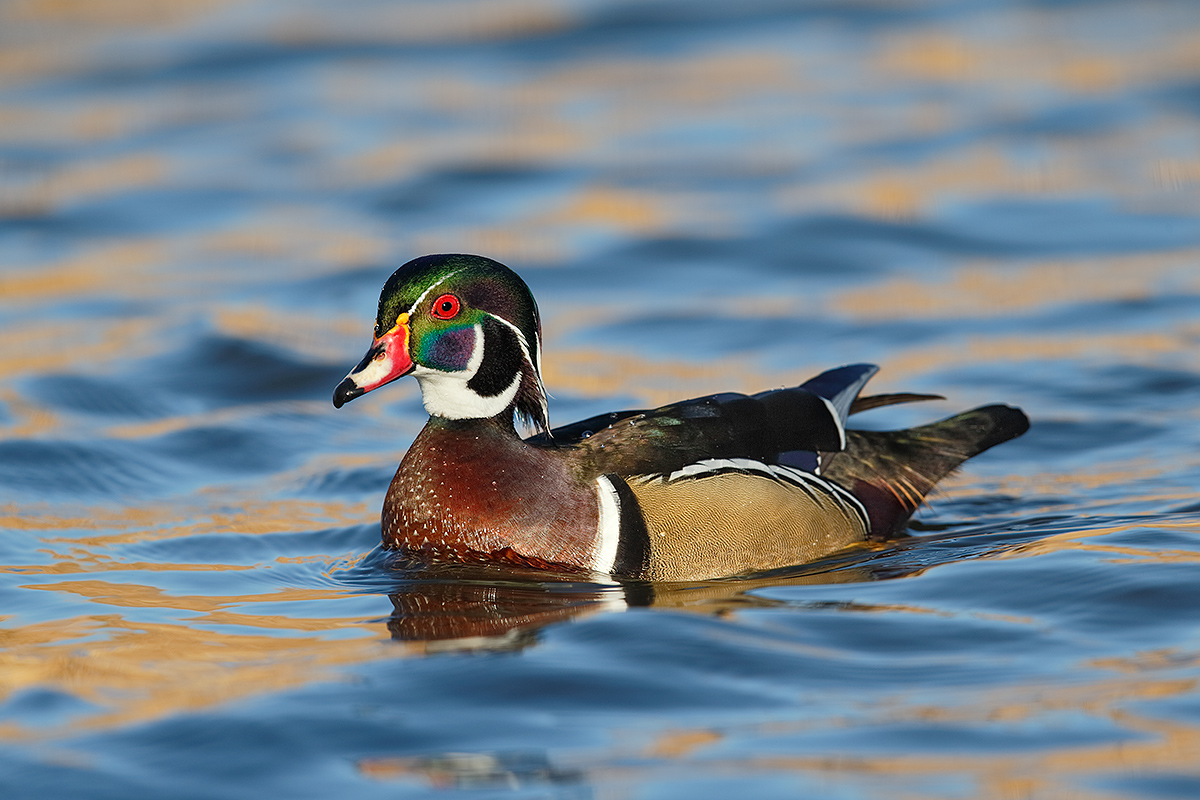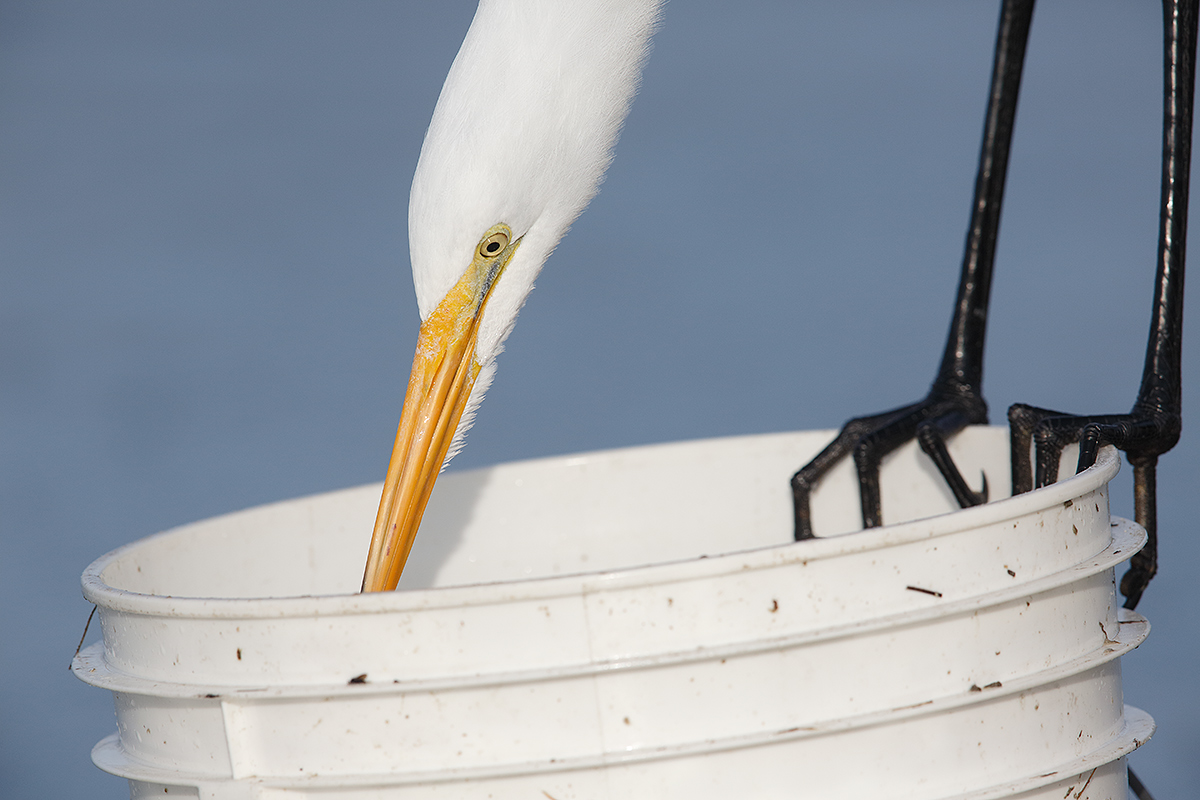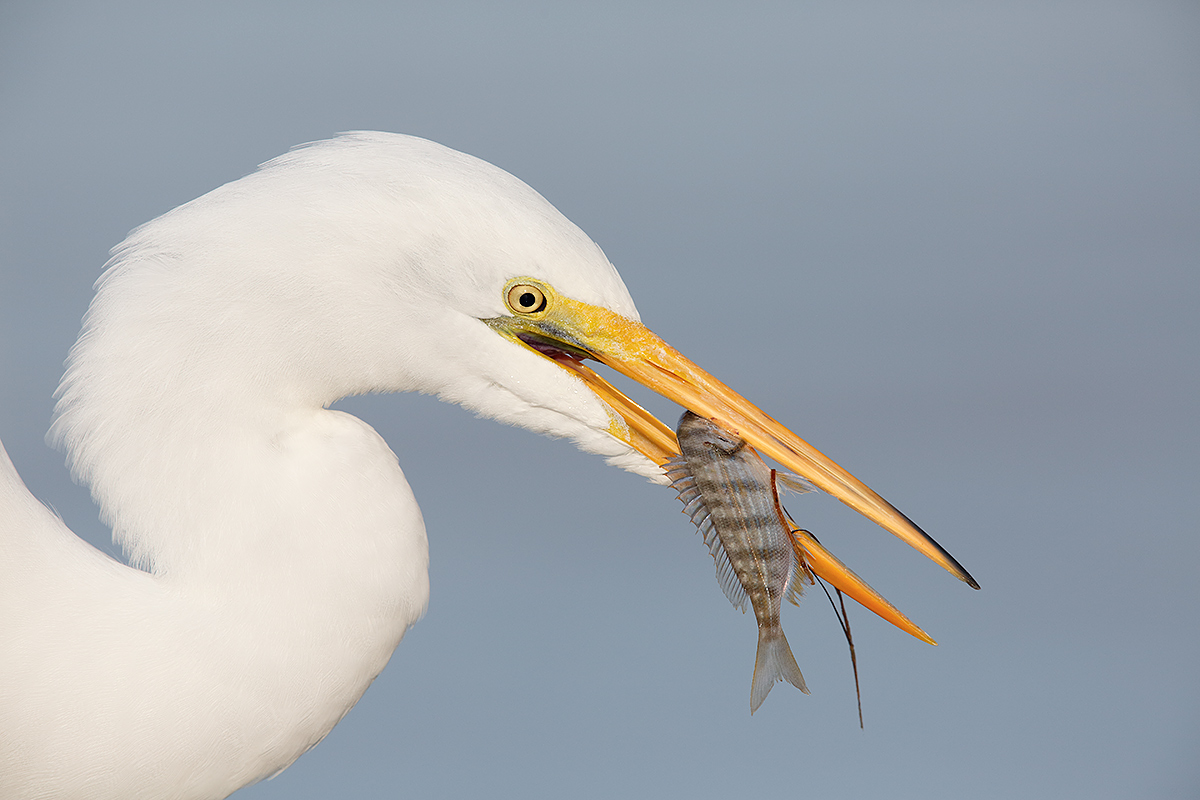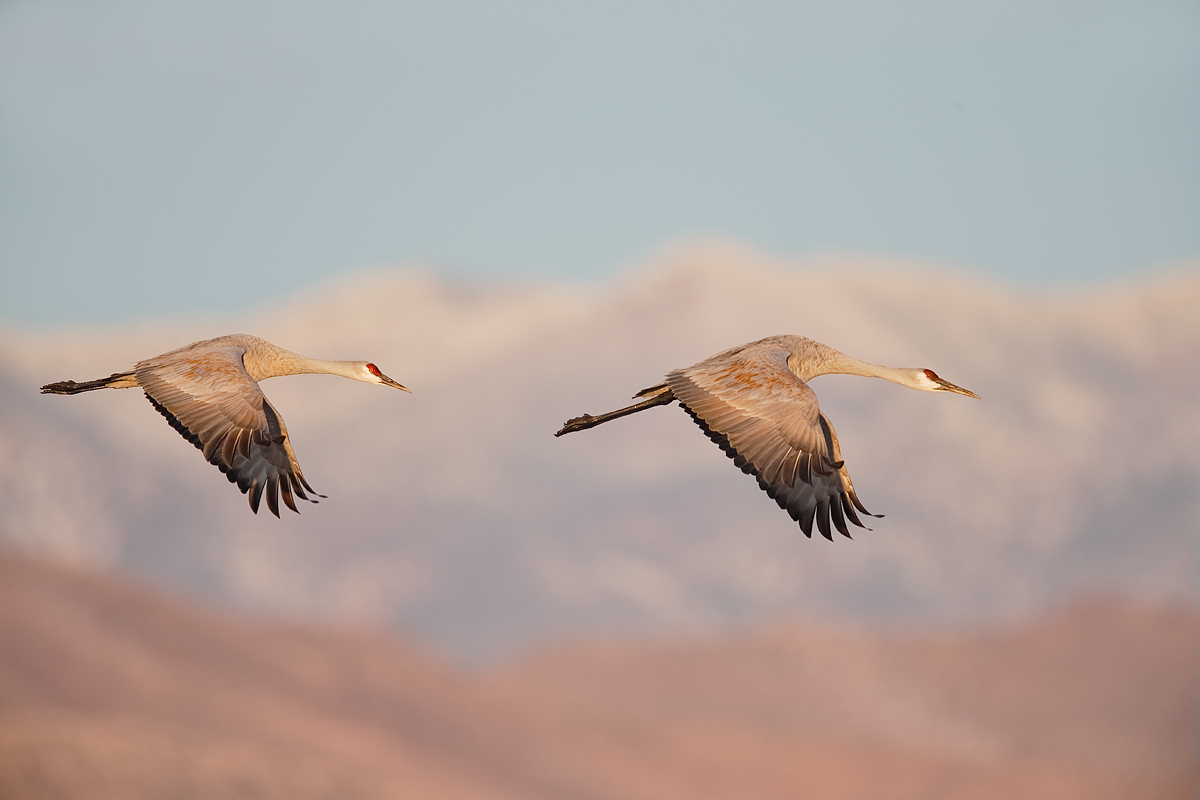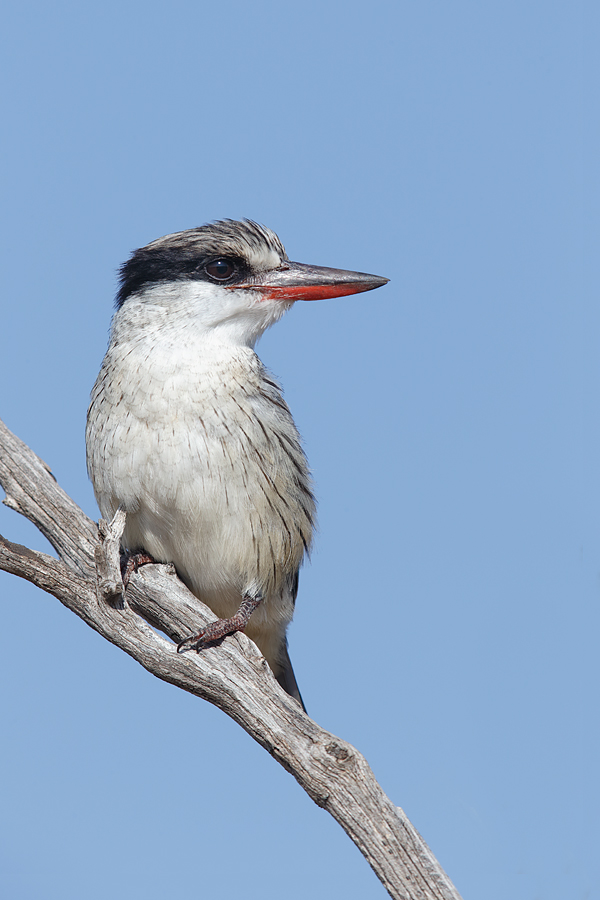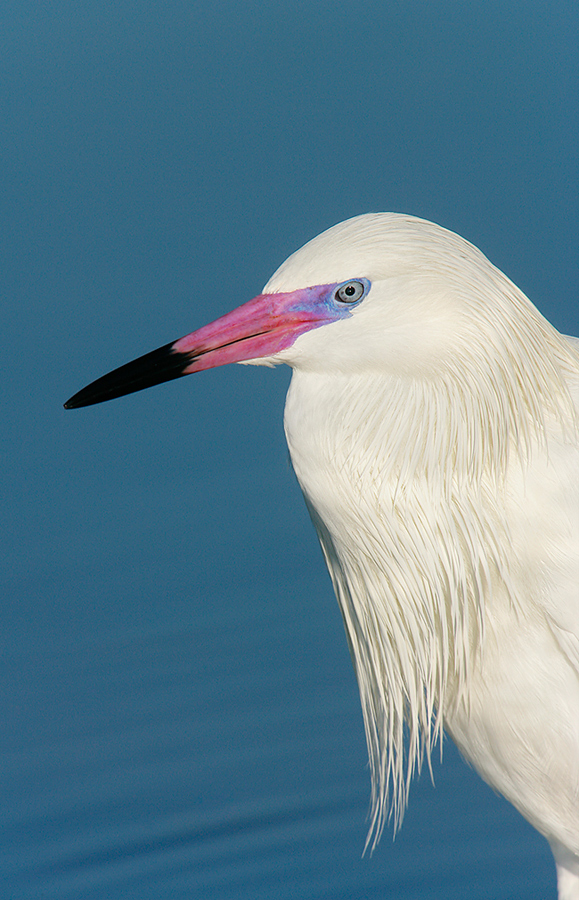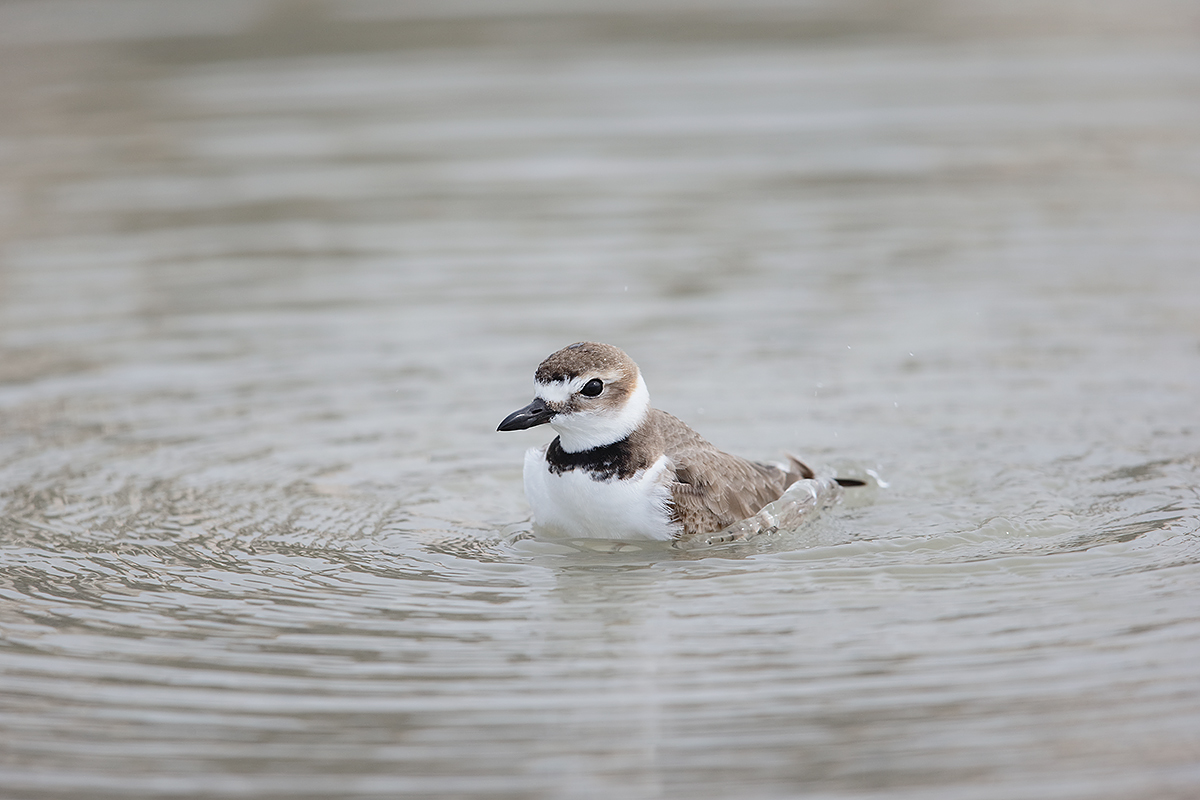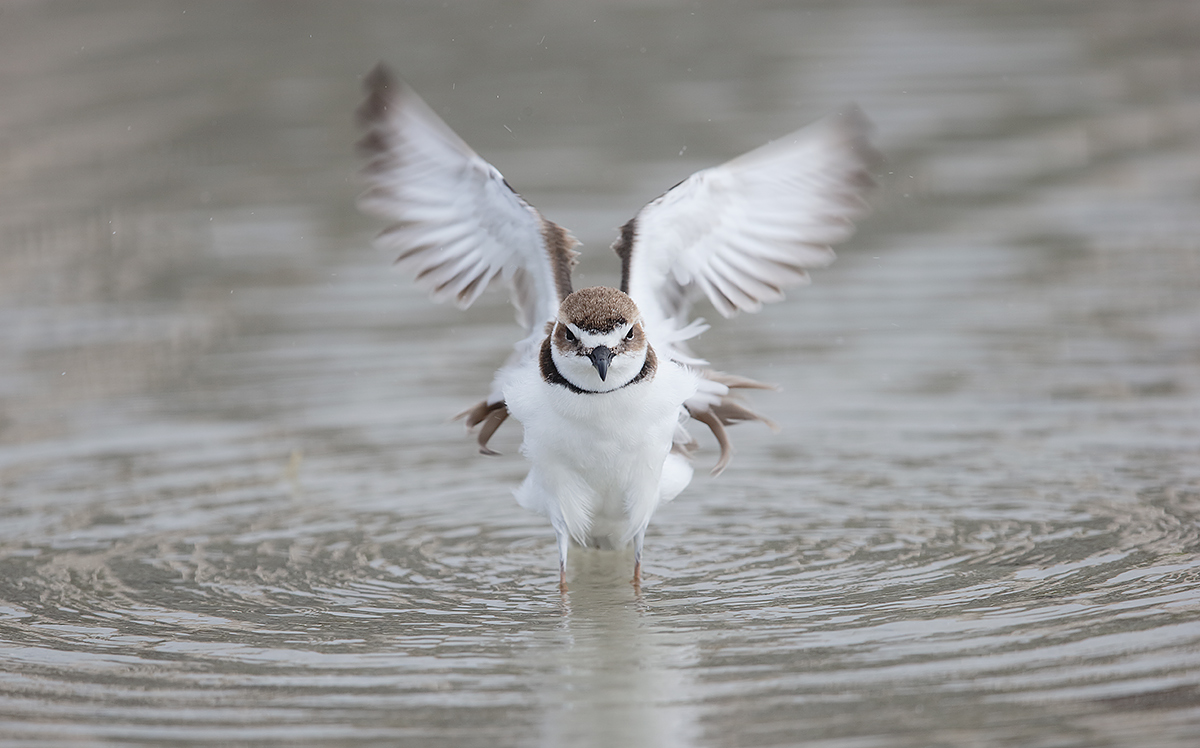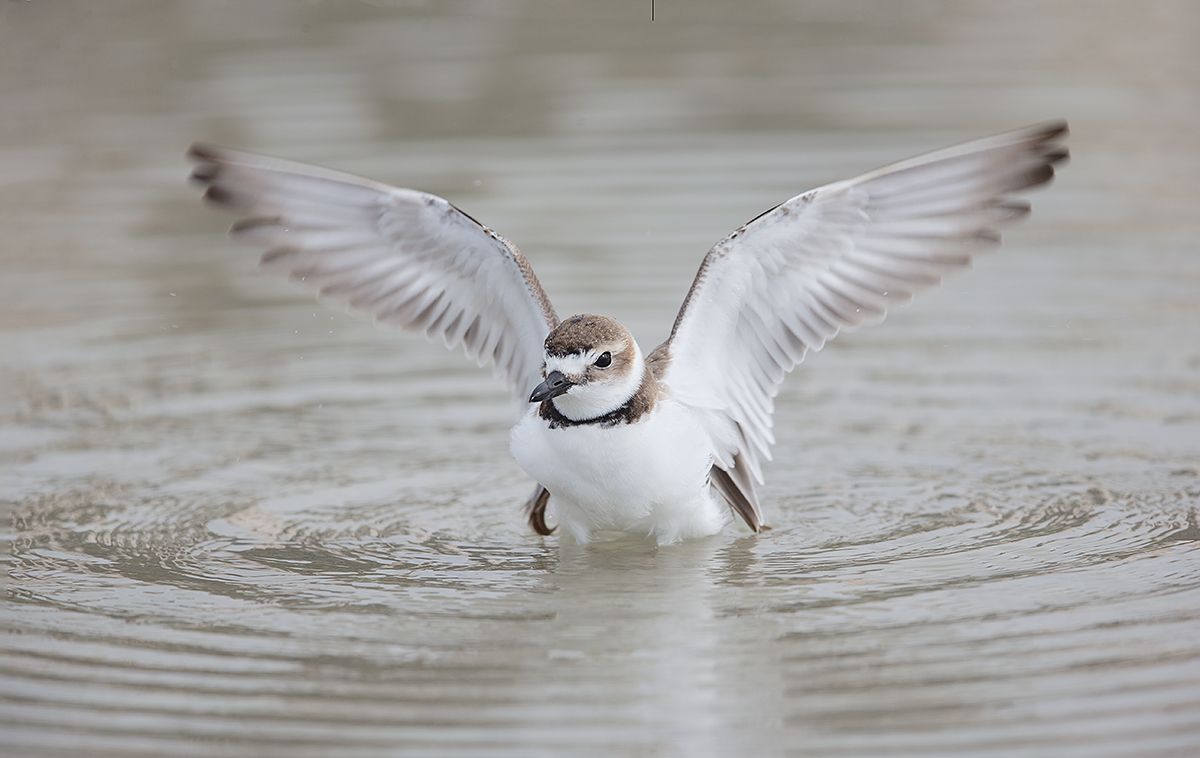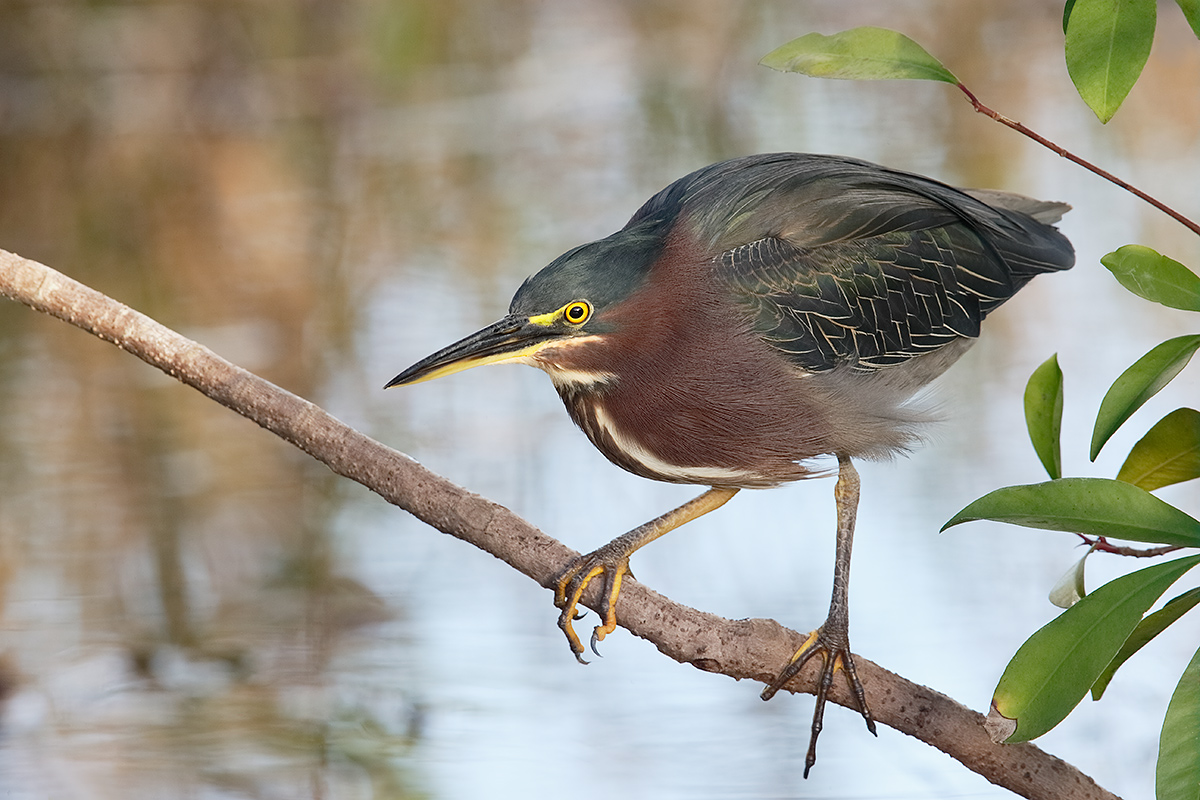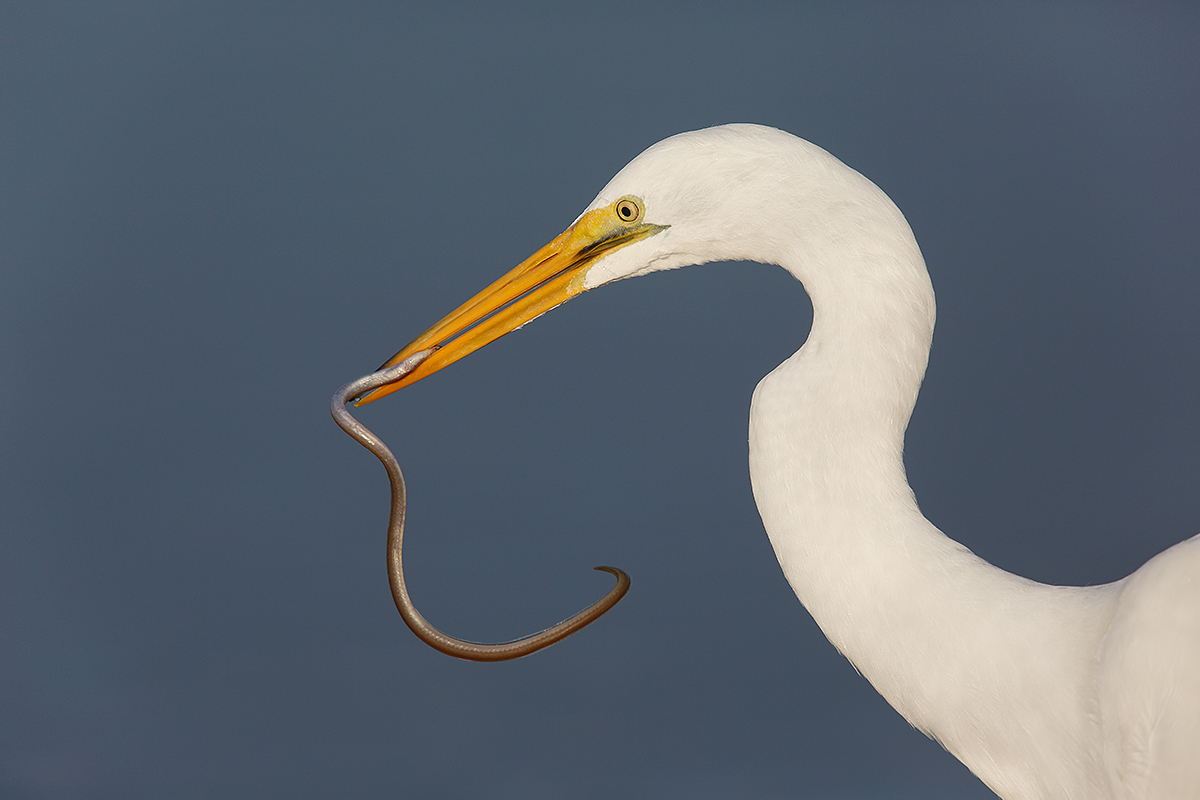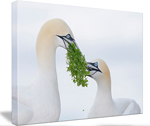February 20th, 2014 And The Streak Continues…
I began working on this post at about 6:30am Japan time on Wednesday after I finished yesterday’s blog post. That works out to 4:30pm on Tuesday in Florida and New York. We will be having breakfast at 8:00am.
This post marks 83 straight days with a new educational blog post, a record by far that should be extended for at least another day or so, or not. Or more…. It appears that our lodge has great internet. To show your appreciation for my efforts here, we ask that use our B&H and Amazon affiliate links for all of your B&H and Amazon purchases. Please check the availability of all photographic accessories in the BIRDS AS ART Online Store. We sell only what I use and depend on. We will not sell you junk. We know what you need to make creating great images easy and fun. And we are always glad to answer your gear questions via e-mail.
You can find the following items in the store: Gitzo tripods, Mongoose M3.6 and Wimberley heads, plates, low feet, and accessories, flash brackets, , Delkin e-film Pro Compact Flash Cards, LensCoat products, and our unique line-up of educational materials including ABP I & II, Digital Basics, Site and Set-up e-Guides, Canon and Nikon Camera Users and AF e-Guides, and MP-4 Photoshop video tutorials among others.
We would of course appreciate you using our B&H and Amazon affiliate links for all of your B&H and Amazon major gear, video, electronic, household, and personal purchases. For the photographic stuff mentioned in the paragraph above we would of course greatly appreciate your business. Here is a huge thank you to the many who have been using our links on a regular basis and visiting the BAA Online store as well.
Today’s blog post took 2 hours to prepare. Enjoy.
Keep It…
Yesterday I posted the image above and asked, “Keep or delete?”
My answer: “Keep it!” See below for the image optimization and the final result.
Related Questions
Is the image above over-exposed?
No, not at all; it is properly exposed. The histogram is well to the right with the bulk of the data in the 5th or rightmost histogram box. There are no blinkies and there were no RGB values above 235 when I brought the image into Photoshop. In fact, I actually lightened the image a bit during the RAW conversion in DPP. Yes, lightened.
Can you age the bird in the photo?
I learned from our guide, Makoto, that birds with red crowns and the primaries outlined in black are 2-year old birds.
|
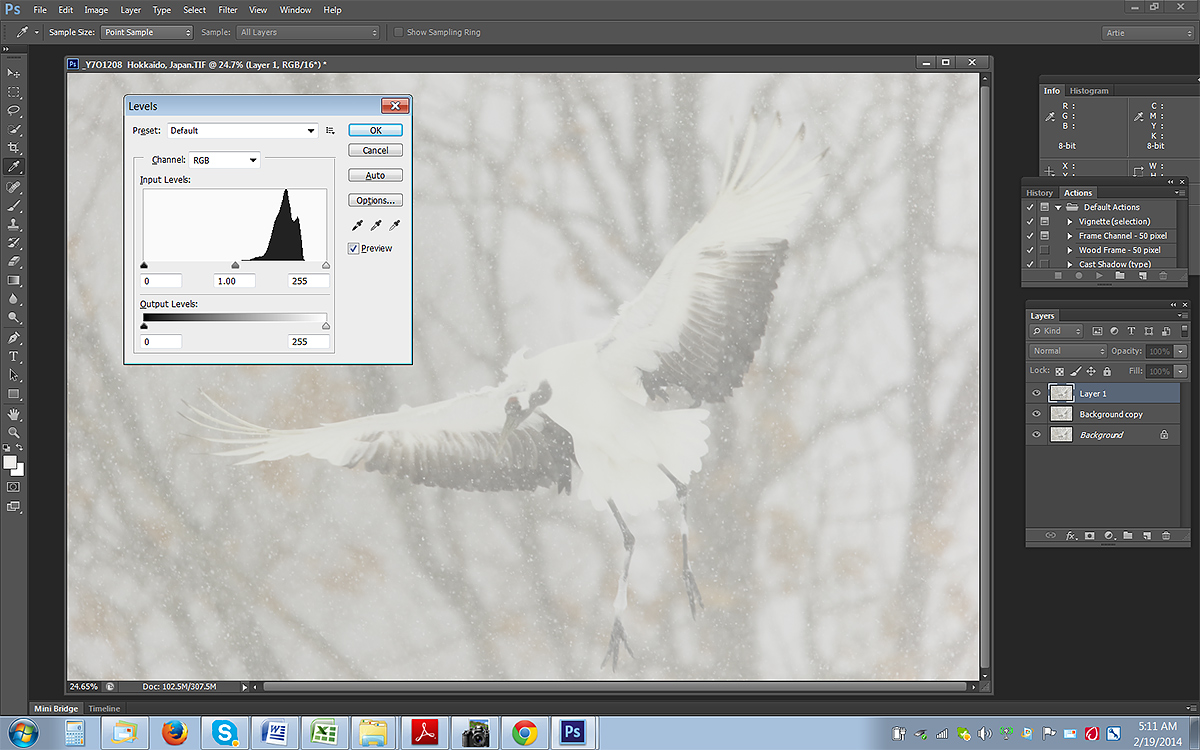
|
|
This is the “Before” screen capture with the Levels dialogue box open.
|
Levels
The key to bringing both snow and fog images that are properly exposed back to life is to set the white and black points using a Levels adjustment. Most folks simply do not realize that properly exposed digital files made in the aforementioned conditions hold such great potential–do see the optimized image below.
|
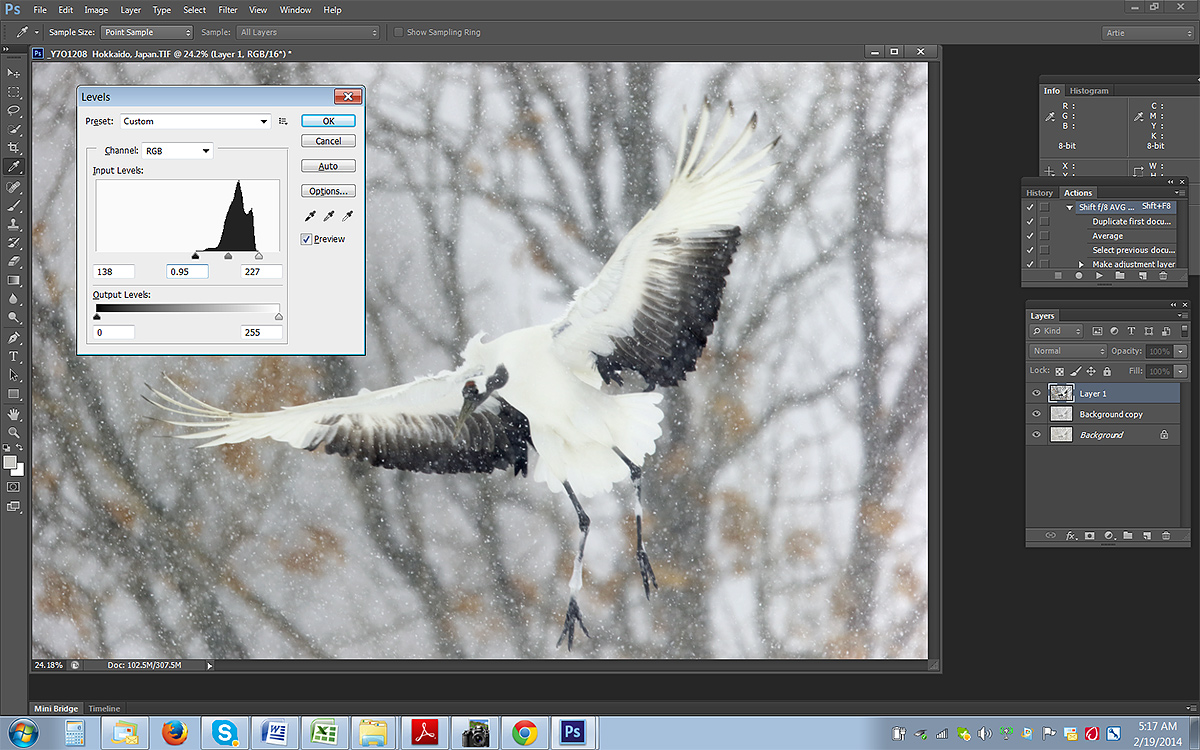
|
|
This is the “After” screen capture with the Levels dialogue box open.
|
The Levels Technique
Grab the Highlight slider, the tiny white triangle on the right, with your cursor. Hold down the ALT key. Move the slider to the left until the first blinkies appear. Then back off slowly until they disappear. Next grab the Shadow slider, the small black triangle on the left, hold down the ALT key, and move the slider to the right until the first splotches appear and then back off slowly until they disappear. You have now set the white and black points. Lastly, you might opt to move the middle tone slider, the grey triangle, a bit to the right to taste to deepen the middle and black tones a bit.
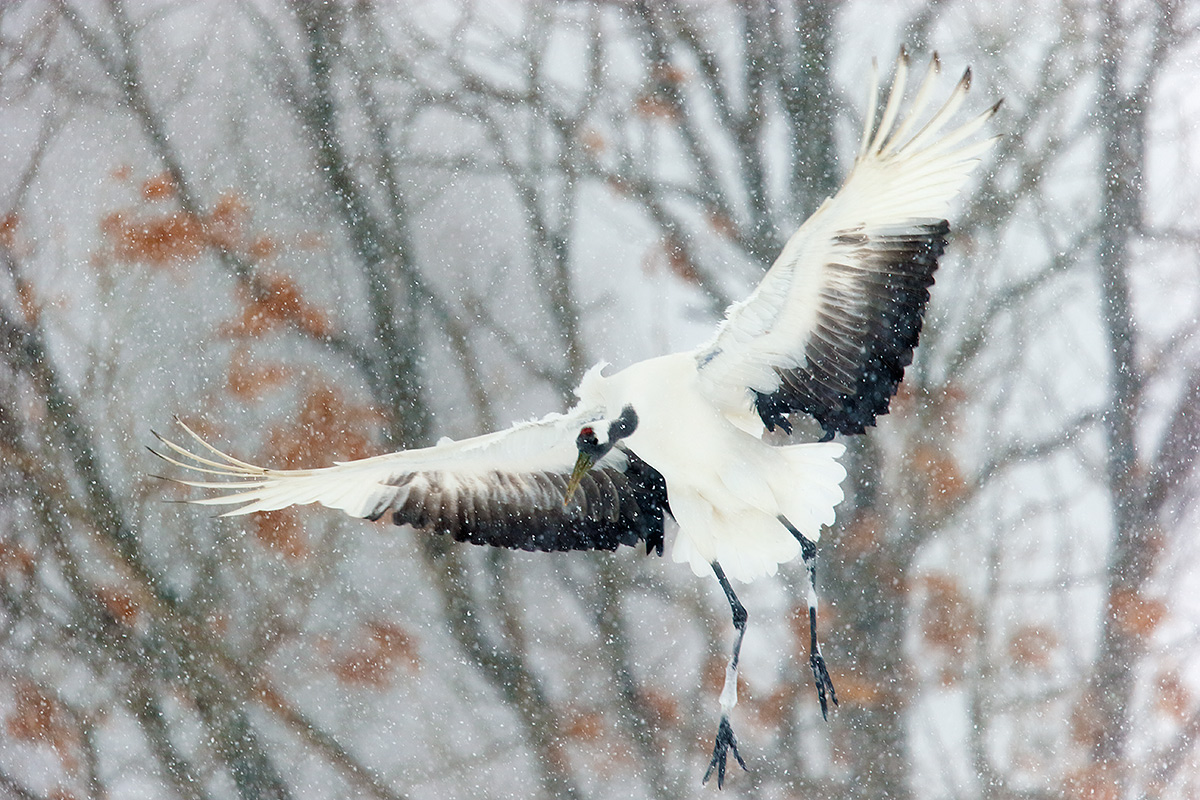
|
|
This is the optimized image.
|
The Optimized Image
Once I set the white and blacks points as described above, I used an Average Blur color correction, upped the Vibrance about 50 points to bring the leaves to life, and ran a contrast mask on the face to sharpen it. All including the Levels adjustments are as described in my Digital Basics File. as detailed in my Digital Basics File, an instructional PDF that is sent via e-mail. Digital Basics includes my complete digital workflow, dozens of great Photoshop tips, the use of Contrast Masks, several different ways of expanding canvas, all of my time-saving Keyboard Shortcuts, Quick Masking, Layer Masking, and NIK Color Efex Pro basics, my killer image clean-up techniques, Digital Eye Doctor, and lots more.
Learn the details of advanced Quick Masking techniques in APTATS I. Mention this blog post and apply a $5 discount with phone orders only. Learn advanced Layer Masking Techniques in APTATS II. Mention this blog post and apply a $5 discount with phone orders only. by the pair, APTATS I and APTATS II and we will be glad to apply at $15 discount with phone orders only.
|
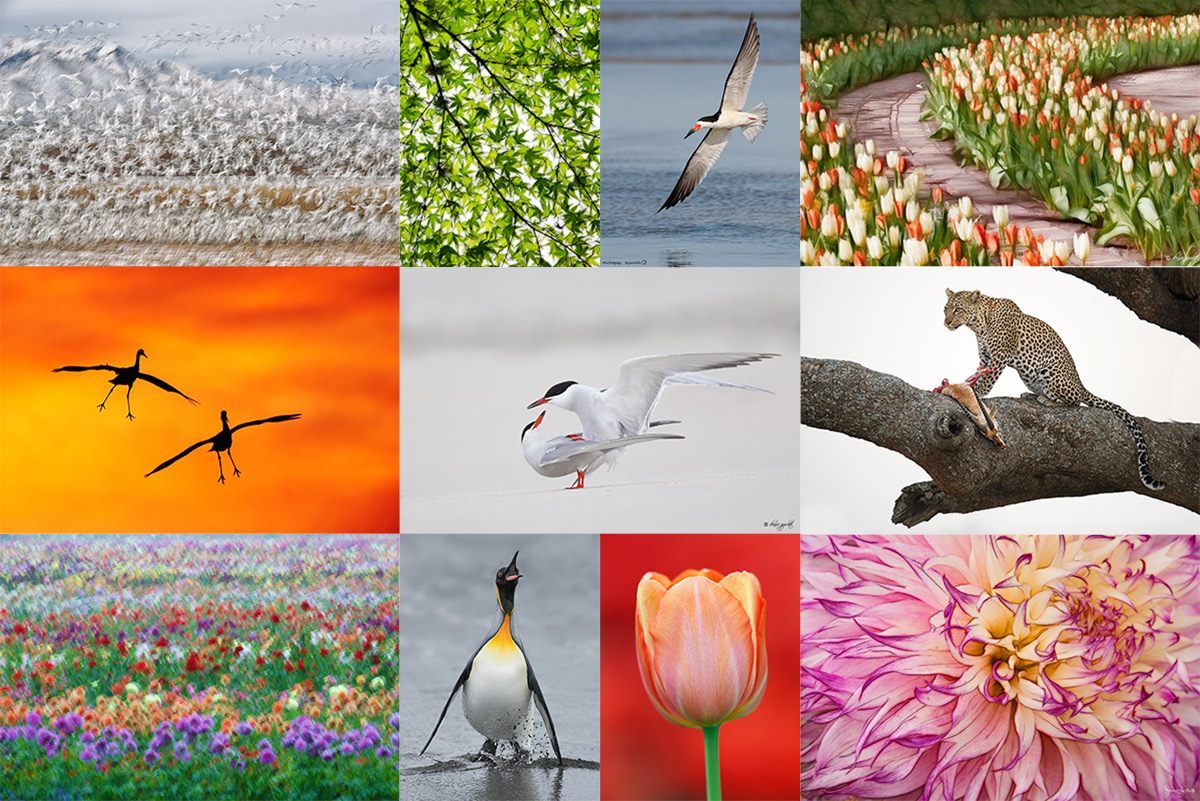
|
|
If you’d like to learn from the two folks who created the images in the composite above do consider one of the trips below. Denise Ippolito’s images: Japanese leaf painting, skimmer in flight, curved Keukenhof paths with tulips, copulating terns, & pink dahlia. Artie’s images: Snow Geese snowstorm blur, crane landing silhouettes, Leopard with prey in tree, King Penguin, & vertical tulip.
|
A Creative Adventure/BIRDS AS ART Instructional Photo-Tours (IPTs)/Two great leaders: Arthur Morris & Denise Ippolito.
Arthur Morris/BIRDS AS ART www.BIRDSASART-blog.com for the latest images, info, & education
Denise Ippolito/A Creative Adventure www.deniseippolito.com: get yourself out of the box!
Denise’s e-books: Bloomin’ Ideas, A Guide to Filters & Effects, The Softer Side of Macro, & more. Free Monthly Creative MiniMag: www.deniseippolito.com/magazine
Nickerson Baby Beach-nesting Birds IPT, Long Island, NY: 3-Full Days/July 22-24, 2014: $1199.
Black Skimmers, Common Terns with chicks, American Oystercatcher & Piping Plover families; breeding behaviors including courtship feeding, display flight and combat, and copulations. Gulls and shorebirds.
UK Puffins IPT. Early July, 2014.
Details TBA. Please e-mail to be placed on the interested list.
Tanzania Serengeti Summer Safari: Leave US: August 9—return: August 24, 2014: $12,999.
Co-leaders: Arthur Morris & Todd Gustafson. Wildebeest/The Great Migration, cats, elephant, giraffe, zebra, birds & more. Please e-mail for brochure.
Swan Island Dahlia Farm IPT, Canby, OR, September 8-12, 2014: 5 FULL DAYS: $1699.
Leader: Denise Ippolito. 40 acres with 350+dazzling varieties of dahlias in a plethora of colors, shapes and sizes. Sharpen your technical skills and boost your creative juices. Daily assignments, image sharing, and Photoshop sessions.
Bosque del Apache 2014 A Creative Adventure/BIRDS AS ART “Creative Photography Instructional Photo-Tour.” (IPT). NOV 24-25, 2014. 2-FULL DAYS: $729.
Leaders: Denise Ippolito & Arthur Morris. Introductory Slide program: 7:00pm on Sunday 11/23. This IPT is perfect for folks who want to learn to think outside the box, to create new and different images. Learn to unleash your creative juices at the wondrous Bosque del Apache, NWR in San Antonio, NM.
Bosque del Apache 2014 BIRDS AS ART/A Creative Adventure Instructional Photo-Tour (IPT). NOV 29-DEC 3, 2014. Totaling 4 FULL-DAYS: $1449
Leaders: Arthur Morris and Denise Ippolito. Introductory Slide program: 7:00pm on Sunday 11/29. Tens of thousand of Snow Geese, 10,000 Sandhill Cranes, ducks, amazing sunrises, sunsets, and blast-offs. Live, eat, and breathe photography with two of the world’s premier photographic educators at one of their very favorite photography locations on the planet.
Antarctica/The Extended Expedition Voyage: Antarctic Peninsula, South Georgia and Falkland Islands: December 13, 2014 to January 10, 2015.
Please e-mail for details.
BAA offers a wide range of books, e-Guides, and educational materials and photographic accessories at the lowest prices around—25+ years of experience, and the best advice you can get. We will not sell you junk. Access the BAA Store here or call us at 1-863-692-0906.
Questions? Please e-mail us at birdsasart@verizon.net or photographybydenise221@gmail.com.
Support the BAA Blog. Support the BAA Bulletins: Shop B&H here!
We want and need to keep providing you with the latest free information, photography and Photoshop lessons, and all manner of related information. Show your appreciation by making your purchases immediately after clicking on any of our B&H or Amazon Affiliate links in this blog post. Remember, B&H ain’t just photography!


 


Amazon
Everyone buys something from Amazon, be it a big lens or deodorant. Support the blog by starting your search by clicking on the logo-link below. No purchase is too small to be appreciated; they all add up. Why make it a habit? Because I make it a habit of bringing you new images and information on an almost daily basis.
Typos
In all blog posts and Bulletins, feel free to e-mail or to leave a comment regarding any typos, wrong words, misspellings, omissions, or grammatical errors. Just be right. 🙂
IPT Info
Many of our great trips are filling up. See especially info on the Holland, Nickerson Beach, and Bosque IPTs. Two great leaders on most trips ensure that you will receive individual attention, have all of your questions answered, and learn a ton including how to think like a pro, see the situation, and get the right exposure every time. In addition you will have fun, and make lots of great images. Click here for IPT details and general information.
February 19th, 2014 And The Streak Continues…
I began working on this and the next post at about 4:30am Japan time on Wednesday. That works out to 2:30pm on Tuesday in Florida and New York. Why up so early with nothing to do? We were supposed to leave at 5:30am this morning to photograph the swans and then continue on to Rausu to do the sea eagles. But the roads to both Kussharo and Rausu are closed because of the wonderful snow storm. 🙂
This post marks 82 straight days with a new educational blog post, a record by far that should be extended for at least another day or so, or not. Or more…. It appears that our lodge has great internet. To show your appreciation for my efforts here, we ask that use our B&H and Amazon affiliate links for all of your B&H and Amazon purchases. Please check the availability of all photographic accessories in the BIRDS AS ART Online Store. We sell only what I use and depend on. We will not sell you junk. We know what you need to make creating great images easy and fun. And we are always glad to answer your gear questions via e-mail.
You can find the following items in the store: Gitzo tripods, Mongoose M3.6 and Wimberley heads, plates, low feet, and accessories, flash brackets, , Delkin e-film Pro Compact Flash Cards, LensCoat products, and our unique line-up of educational materials including ABP I & II, Digital Basics, Site and Set-up e-Guides, Canon and Nikon Camera Users and AF e-Guides, and MP-4 Photoshop video tutorials among others.
We would of course appreciate you using our B&H and Amazon affiliate links for all of your B&H and Amazon major gear, video, electronic, household, and personal purchases. For the photographic stuff mentioned in the paragraph above we would of course greatly appreciate your business. Here is a huge thank you to the many who have been using our links on a regular basis and visiting the BAA Online store as well.
Today’s blog post took 1 1/2 hours to prepare. Enjoy.
Keep or Delete?
It’s a simple question: keep or delete? It was one that is made at least hundreds, sometimes thousands of times each day as we sort through our images. Would you keep or delete the image above? Be sure to let us know why. If the former, how would you go about optimizing it?
Related Questions
Is the image above over-exposed?
Can you age the bird in the photo?
The Answers
I will be back tomorrow with all the answers.
Holland 2014 7 1/2-Day/8-Night: A Creative Adventure/BIRDS AS ART/Tulips & A Touch of Holland IPT. April 17-April 24, 2014: $4995 Limit: 12/Openings: 5
Act soon: this trip is a go and is filling quickly.
Join Denise Ippolito, Flower Queen and the author of “Bloomin’ Ideas,” and Arthur Morris, Canon Explorer of Light Emeritus and one of the planet’s premier photographic educators for a great trip to Holland in mid-April 2014. Day 1 of the IPT will be April 17, 2014. We will have a short afternoon get-together and then our first photographic session at the justly-famed Keukenhof. Most days we will return to the hotel for lunch, image sharing and a break. On Day 8, April 24, we will enjoy both morning and afternoon photography sessions.
The primary subjects will be tulips and orchids at Keukenhof and the spectacularly amazing tulip, hyacinth, and daffodil bulb fields around Lisse. In addition we will spend one full day in Amsterdam. There will be optional visits the Van Gogh Museum in the morning and the Anne Frank House in the afternoon; there will be plenty of time for street photography as well. And some great food. On another day we will have a wonderful early dinner at Kinderdijk and then head out with our gear to photograph the windmills and possibly some birds for those who bring their longs lenses. We will spend an afternoon in the lovely Dutch town of Edam where we will do some street photography and enjoy a superb dinner. All lodging, ground transportation, entry fees, and meals (from dinner on Day 1 through dinner on Day 7) are included. For those who will be bringing a big lens we will likely have an optional bird photography afternoon or two.
Click here for additional info or to register.
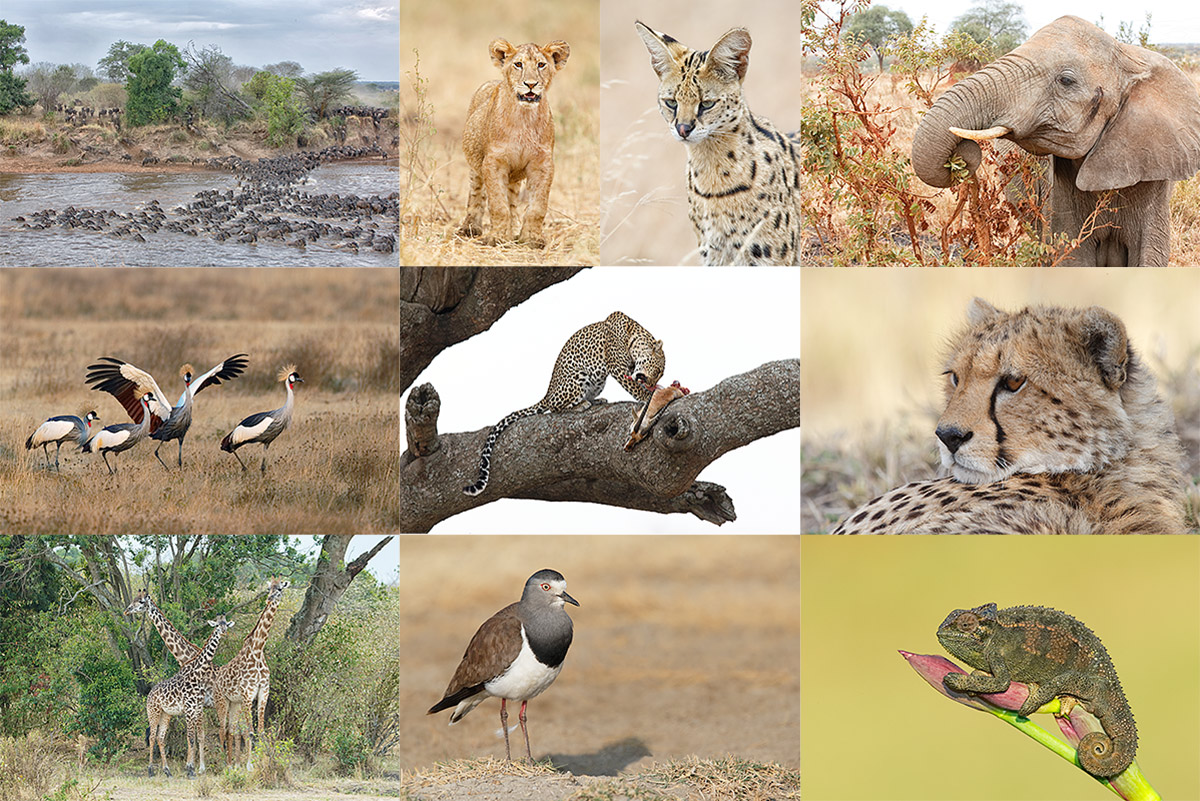
|
|
Join me for the 2014 Tanzania Summer Safari!
|
2014 Tanzania Summer Safari, 14-day African Adventure/leave the US on August 9. Fly home on August 24: $12,999.
Co-leaders Todd Gustafson & Arthur Morris. The limit is 12. Three photographers/van; you get your own row of seats. Our trip is a bit more expensive than the average safari for good reason. It is the best. We have the best driver guides with a total of decades of experience. They have been trained over the years by Todd and by me to drive with photography in mind. We have the best and most knowledgeable leaders. We stay in the best lodges and camps. We hope that you will join us for what will be Todd’s 35th African safari, and my 8th.
If you are seriously interested please e-mail me; I will be glad to send you the illustrated PDF with the complete itinerary and deposit info.
What else makes this expedition unique?
•Pre-trip consultation and camera equipment advice
•Award-winning photographers as your guides
•A seamless itinerary visiting the right locations at the best time of year
•Hands-on photography instruction in the field
•Specially designed three roof-hatch photo safari vehicles
•Proprietary materials for preparation, including free copy of “A Photographer’s Guide to Photographing in East Africa.”
•Post-safari image critiques
All-inclusive (double-occupancy) except for your flights to and from Kilamajaro Airport, bar drinks, soda & water (except at the Intimate Tented Camp where everything is free for our entire stay), tips for drivers and camp staff, personal items, and trip insurance.
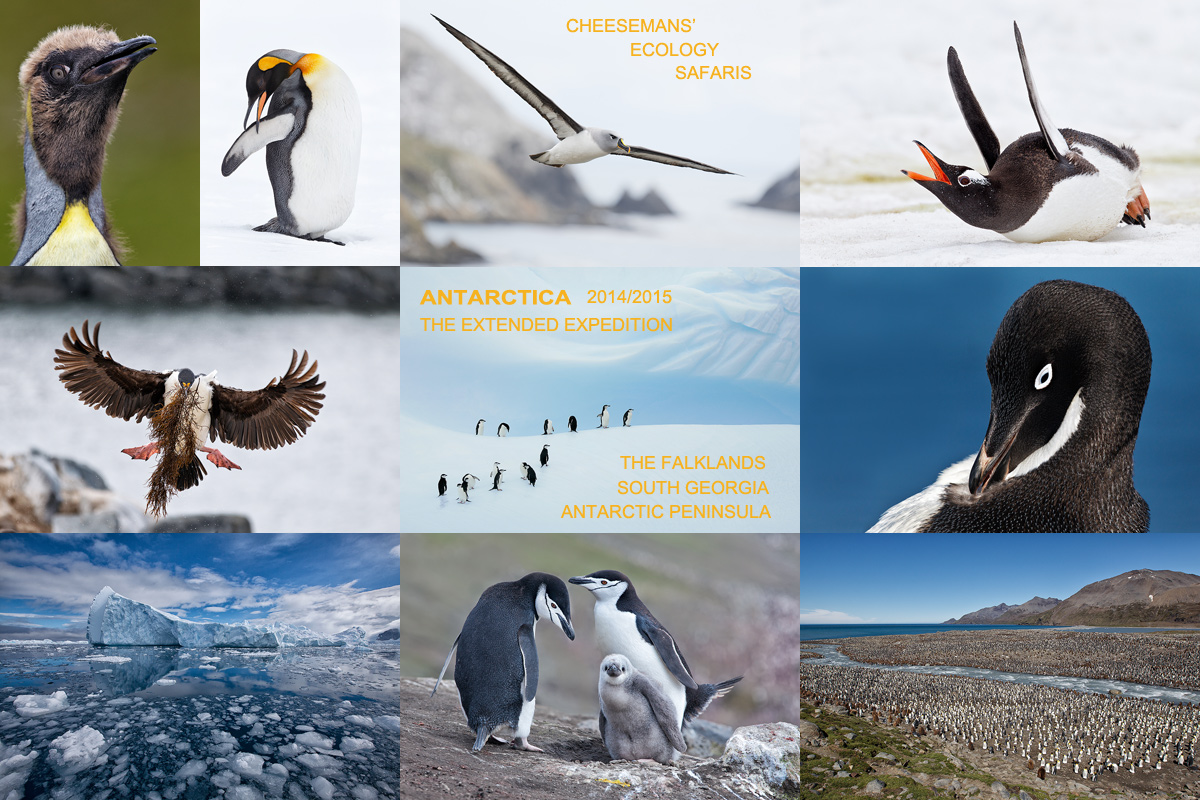
|
|
Breathe deeply, bite the bullet, and live life to its fullest; we all get only one ride on the merry-go-round… Join me on this great trip.
Click on the image to enjoy a larger version.
|
The Southern Ocean…
If you would like to explore the possibility of joining me on the Cheesemans’ Ecology Safaris Antarctica/The Extended Expedition Voyage< trip: Antarctic Peninsula, South Georgia and Falkland Islands: December 13, 2014 to January 10, 2015, click here for additional information and then shoot me an e-mail.
The DPP RAW Conversion Guide
To learn why I use Canon’s Digital Photo Professional (DPP) to convert every image that I work on, click here.
Support the BAA Blog. Support the BAA Bulletins: Shop B&H here!
We want and need to keep providing you with the latest free information, photography and Photoshop lessons, and all manner of related information. Show your appreciation by making your purchases immediately after clicking on any of our B&H or Amazon Affiliate links in this blog post. Remember, B&H ain’t just photography!


 


Amazon
Everyone buys something from Amazon, be it a big lens or deodorant. Support the blog by starting your search by clicking on the logo-link below. No purchase is too small to be appreciated; they all add up. Why make it a habit? Because I make it a habit of bringing you new images and information on an almost daily basis.
Typos
In all blog posts and Bulletins, feel free to e-mail or to leave a comment regarding any typos, wrong words, misspellings, omissions, or grammatical errors. Just be right. 🙂
IPT Info
Many of our great trips are filling up. See especially info on the South Florida, Holland, and Nickerson Beach IPTs. Two great leaders on most trips ensure that you will receive individual attention, have all of your questions answered, and learn a ton including how to think like a pro, see the situation, and get the right exposure every time. In addition you will have fun, and make lots of great images. Click here for IPT details and general information.
February 18th, 2014 And The Streak Continues…
Today was our toughest day photography-wise with bright sun and northwest winds. We photographed the raptors in flight at the Akan Crane center fish feeding and did fairly well at the Itoh sanctuary in the late afternoon.
This post marks 81 straight days with a new educational blog post, a record by far that should be extended for at least another day or so, or not. Or more…. It appears that our lodge has great internet. To show your appreciation for my efforts here, we ask that use our B&H and Amazon affiliate links for all of your B&H and Amazon purchases. Please check the availability of all photographic accessories in the BIRDS AS ART Online Store. We sell only what I use and depend on. We will not sell you junk. We know what you need to make creating great images easy and fun. And we are always glad to answer your gear questions via e-mail.
You can find the following items in the store: Gitzo tripods, Mongoose M3.6 and Wimberley heads, plates, low feet, and accessories, flash brackets, , Delkin e-film Pro Compact Flash Cards, LensCoat products, and our unique line-up of educational materials including ABP I & II, Digital Basics, Site and Set-up e-Guides, Canon and Nikon Camera Users and AF e-Guides, and MP-4 Photoshop video tutorials among others.
We would of course appreciate you using our B&H and Amazon affiliate links for all of your B&H and Amazon major gear, video, electronic, household, and personal purchases. For the photographic stuff mentioned in the paragraph above we would of course greatly appreciate your business. Here is a huge thank you to the many who have been using our links on a regular basis and visiting the BAA Online store as well.
Today’s blog post took 2 1/2 hours to prepare. Enjoy. As I am unsure of our travel and lodging plans for the next few days the streak is in dire jeopardy.
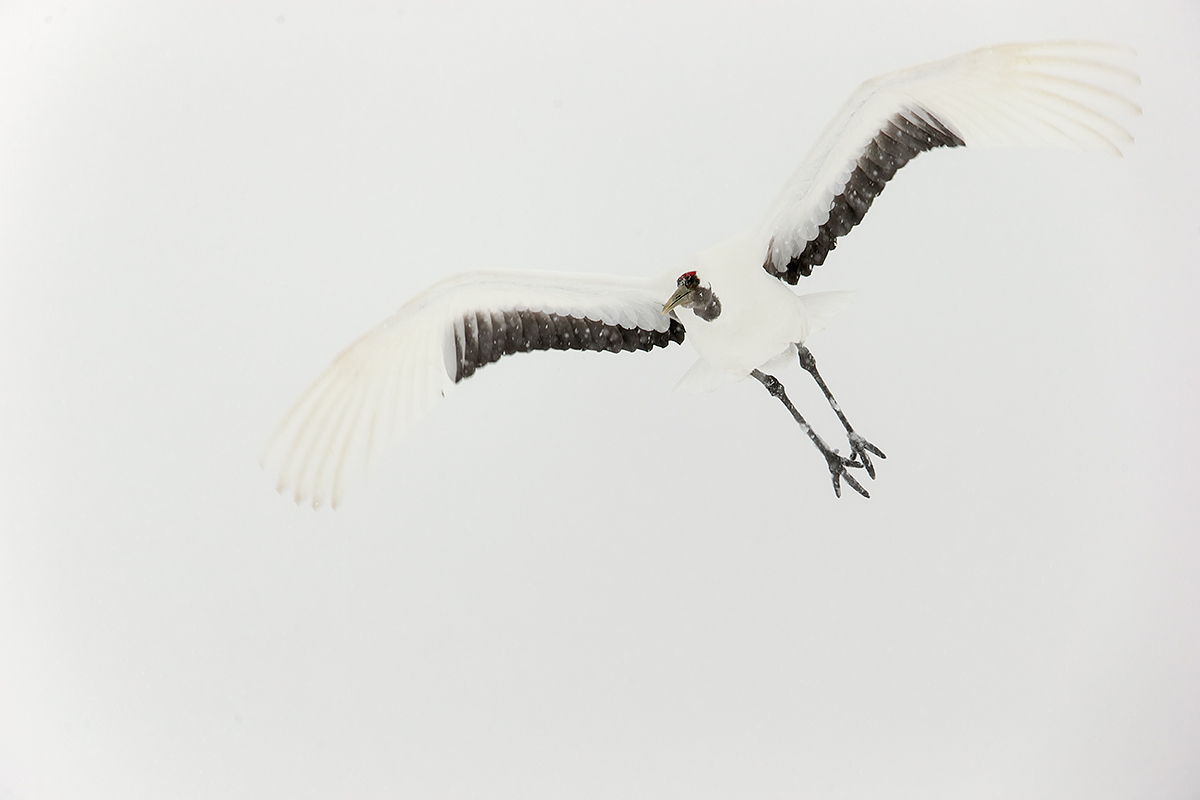
|
|
This Red-crowned Crane flight image was created at 1:42pm during the Day 4 blizzard on the Japan in Winter IPT with the Gitzo 3532 LS carbon fiber tripod, the Mongoose M3.6 head, the Canon EF 600mm f/4L IS II USM lens, the Canon 1.4x EF Extender III (Teleconverter), and the Canon EOS-1D X. ISO 400. Evaluative metering +2 1/3 stops off the white sky: 1/640 sec. at f/5.6 in Manual mode. Color temperature: Custom Pre-set.
The sensor above the Central sensor/AI Servo/Surround Rear Focus AF just caught the black secondaries of the bird’s right wing as framed was active at the moment of exposure. Click here to see the latest version of the Rear Focus Tutorial. Click on the image to see a larger version.
Image #1: Angel Flight
|
More Cold Wet Blizzard Images
Despite the white out conditions and the difficulty of autofocusing accurately through the heavy snow I kept 104 images on the first edit. My rules are as follows: on the first edit, if you are not sure, keep it; on the second edit, if you are not sure, delete it; on the third go through, if you do not love it, delete it. These are four of my favorites.
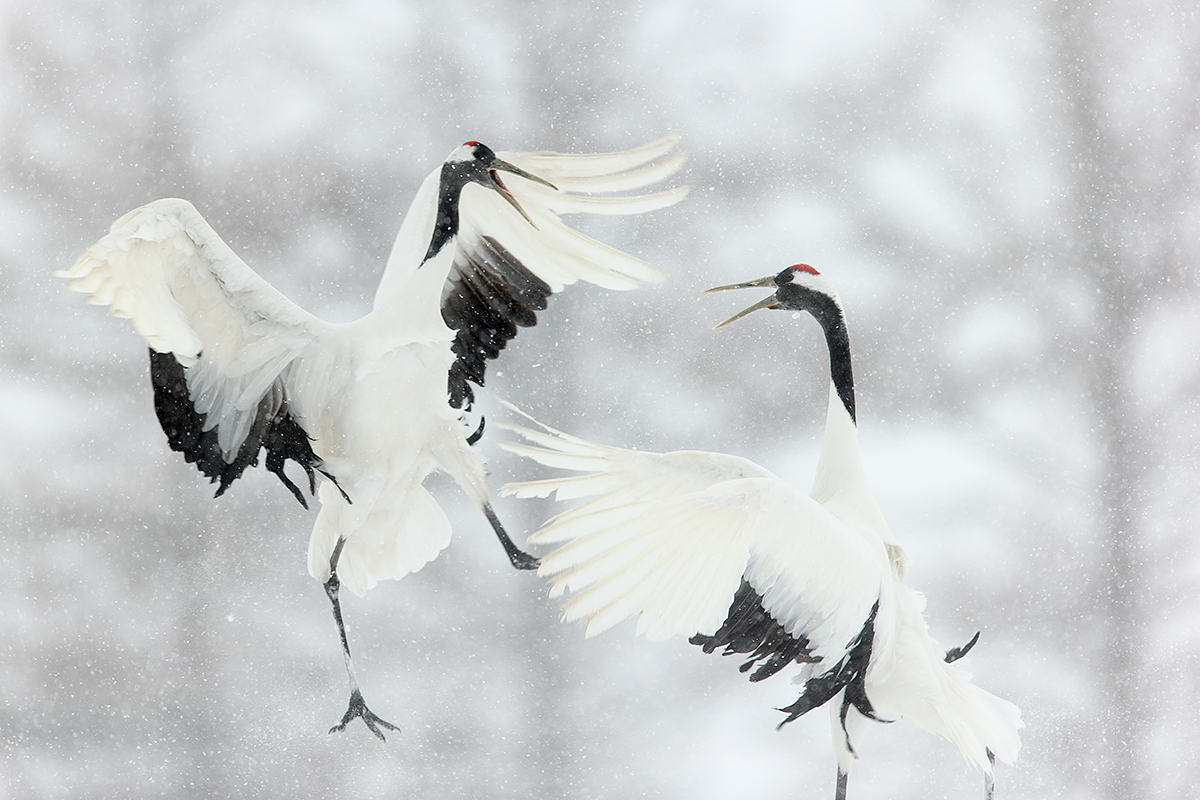
|
|
These tussling Red-crowned Cranes were photographed at 1:56pm during the Day 4 blizzard on the Japan in Winter IPT with the Gitzo 3532 LS carbon fiber tripod, the Mongoose M3.6 head, the Canon EF 600mm f/4L IS II USM lens and the Canon EOS-1D X. ISO 400. Evaluative metering +2 stops off the white sky: 1/1000 sec. at f/4 in Manual mode. Color temperature: 7000K.
Central sensor/AI Servo/Surround Rear Focus AF just caught the black secondaries of the left hand bird’s left wing as framed was active at the moment of exposure. Click here to see the latest version of the Rear Focus Tutorial. Click on the image to see a larger version.
Image #2: Tussling Cranes
|
On a Scale of Zero to Ten
On a scale of zero to ten, with zero being not bothersome at all and ten being terribly bothersome–an instant delete, what are your thoughts on the fact that I cut off the feet of the right hand crane? Please refer to the Tussling Cranes image.
Juxtapositions
I am always on the lookout for interesting juxtapositions, way to include two pleasingly arranged subjects in the same frame. What are your thoughts on this image and the arrangement of the Whooper Swan and the crane?
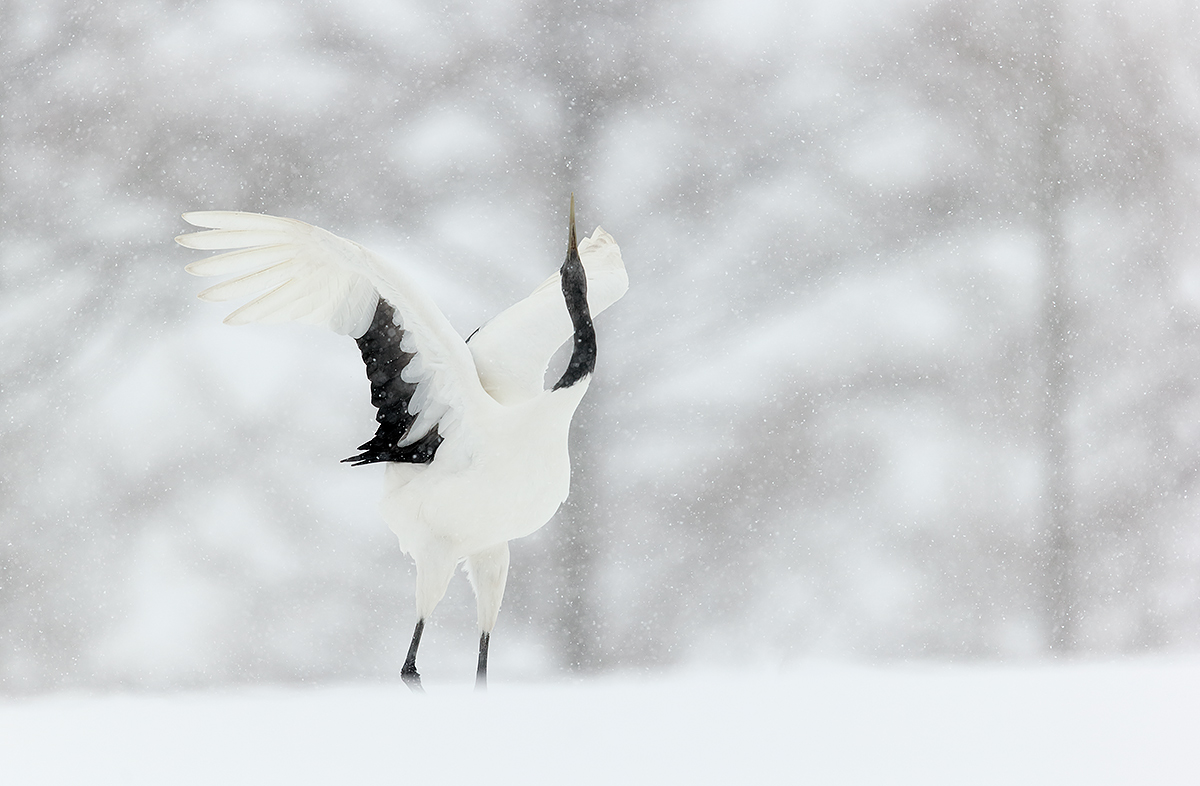
|
|
This displaying Red-crowned Crane image was created at 2:56pm during the Day 4 blizzard on the Japan in Winter IPT with the Gitzo 3532 LS carbon fiber tripod, the Mongoose M3.6 head, the Canon EF 600mm f/4L IS II USM lens and the Canon EOS-1D X. ISO 400. Evaluative metering +2 stops off the white sky: 1/1000 sec. at f/4 in Manual mode. Color temperature: 7000K.
Central sensor/AI Servo/Surround Rear Focus AF just caught the black at the rear base of the neck active at the moment of exposure. Click here to see the latest version of the Rear Focus Tutorial. Click on the image to see a larger version.
Image #4: Displaying Crane
|
On a Scale of Zero to Ten
On a scale of zero to ten, with zero being not bothersome at all and ten being terribly bothersome, i.e., an image wrecker, what are your thoughts on the tree coming out of the cranes head? Please refer to the Displaying Crane image.
You Favorite
Take a moment to leave a comment and let us know which of the four images above is your favorite, and be sure to let us know why.
|

|
|
If you’d like to learn from the two folks who created the images in the composite above do consider one of the trips below. Denise Ippolito’s images: Japanese leaf painting, skimmer in flight, curved Keukenhof paths with tulips, copulating terns, & pink dahlia. Artie’s images: Snow Geese snowstorm blur, crane landing silhouettes, Leopard with prey in tree, King Penguin, & vertical tulip. Note: Denise alone will be leading the Torres del Paine workshop.
|
A Creative Adventure/BIRDS AS ART Instructional Photo-Tours (IPTs)/Two great leaders: Arthur Morris & Denise Ippolito.
Arthur Morris/BIRDS AS ART www.BIRDSASART-blog.com for the latest images, info, & education
Denise Ippolito/A Creative Adventure www.deniseippolito.com: get yourself out of the box!
Denise’s e-books: Bloomin’ Ideas, A Guide to Filters & Effects, The Softer Side of Macro, & more. Free Monthly Creative MiniMag: www.deniseippolito.com/magazine
Nickerson Baby Beach-nesting Birds IPT, Long Island, NY: 3-Full Days/July 22-24, 2014: $1199.
Black Skimmers, Common Terns with chicks, American Oystercatcher & Piping Plover families; breeding behaviors including courtship feeding, display flight and combat, and copulations. Gulls and shorebirds.
UK Puffins IPT. Early July, 2014.
Details TBA. Please e-mail to be placed on the interested list.
Tanzania Serengeti Summer Safari: Leave US: August 9—return: August 24, 2014: $12,999.
Co-leaders: Arthur Morris & Todd Gustafson. Wildebeest/The Great Migration, cats, elephant, giraffe, zebra, birds & more. Please e-mail for brochure.
Swan Island Dahlia Farm IPT, Canby, OR, September 8-12, 2014: 5 FULL DAYS: $1699.
Leader: Denise Ippolito. 40 acres with 350+dazzling varieties of dahlias in a plethora of colors, shapes and sizes. Sharpen your technical skills and boost your creative juices. Daily assignments, image sharing, and Photoshop sessions.
Bosque del Apache 2014 A Creative Adventure/BIRDS AS ART “Creative Photography Instructional Photo-Tour.” (IPT). NOV 24-25, 2014. 2-FULL DAYS: $729.
Leaders: Denise Ippolito & Arthur Morris. Introductory Slide program: 7:00pm on Sunday 11/23. This IPT is perfect for folks who want to learn to think outside the box, to create new and different images. Learn to unleash your creative juices at the wondrous Bosque del Apache, NWR in San Antonio, NM.
Bosque del Apache 2014 BIRDS AS ART/A Creative Adventure Instructional Photo-Tour (IPT). NOV 29-DEC 3, 2014. Totaling 4 FULL-DAYS: $1449
Leaders: Arthur Morris and Denise Ippolito. Introductory Slide program: 7:00pm on Sunday 11/29. Tens of thousand of Snow Geese, 10,000 Sandhill Cranes, ducks, amazing sunrises, sunsets, and blast-offs. Live, eat, and breathe photography with two of the world’s premier photographic educators at one of their very favorite photography locations on the planet.
Antarctica/The Extended Expedition Voyage: Antarctic Peninsula, South Georgia and Falkland Islands: December 13, 2014 to January 10, 2015.
Please e-mail for details.
BAA offers a wide range of books, e-Guides, and educational materials and photographic accessories at the lowest prices around—25+ years of experience, and the best advice you can get. We will not sell you junk. Access the BAA Store here or call us at 1-863-692-0906.
Questions? Please e-mail us at birdsasart@verizon.net or photographybydenise221@gmail.com.
Support the BAA Blog. Support the BAA Bulletins: Shop B&H here!
We want and need to keep providing you with the latest free information, photography and Photoshop lessons, and all manner of related information. Show your appreciation by making your purchases immediately after clicking on any of our B&H or Amazon Affiliate links in this blog post. Remember, B&H ain’t just photography!


 


Amazon
Everyone buys something from Amazon, be it a big lens or deodorant. Support the blog by starting your search by clicking on the logo-link below. No purchase is too small to be appreciated; they all add up. Why make it a habit? Because I make it a habit of bringing you new images and information on an almost daily basis.
Typos
In all blog posts and Bulletins, feel free to e-mail or to leave a comment regarding any typos, wrong words, misspellings, omissions, or grammatical errors. Just be right. 🙂
IPT Info
Many of our great trips are filling up. See especially info on the Holland, Nickerson Beach, and Bosque IPTs. Two great leaders on most trips ensure that you will receive individual attention, have all of your questions answered, and learn a ton including how to think like a pro, see the situation, and get the right exposure every time. In addition you will have fun, and make lots of great images. Click here for IPT details and general information.
February 17th, 2014 And The Streak Continues…
After a morning of tree and scenic photography with too much sun, we returned to Tsurui-Ito Tancho Sanctuary in hopes of clouds as the wind direction was perfect. We got off to another slow start but the action developed quickly and stayed hot for several hours. How good was it? Denise Ippolito created 2,345 images in five hours.
This post marks 80 straight days with a new educational blog post, a record by far that should be extended for at least another day or so, or not. Or more…. It appears that our lodge has great internet. To show your appreciation for my efforts here, we ask that use our B&H and Amazon affiliate links for all of your B&H and Amazon purchases. Please check the availability of all photographic accessories in the BIRDS AS ART Online Store. We sell only what I use and depend on. We will not sell you junk. We know what you need to make creating great images easy and fun. And we are always glad to answer your gear questions via e-mail.
You can find the following items in the store: Gitzo tripods, Mongoose M3.6 and Wimberley heads, plates, low feet, and accessories, flash brackets, , Delkin e-film Pro Compact Flash Cards, LensCoat products, and our unique line-up of educational materials including ABP I & II, Digital Basics, Site and Set-up e-Guides, Canon and Nikon Camera Users and AF e-Guides, and MP-4 Photoshop video tutorials among others.
We would of course appreciate you using our B&H and Amazon affiliate links for all of your B&H and Amazon major gear, video, electronic, household, and personal purchases. For the photographic stuff mentioned in the paragraph above we would of course greatly appreciate your business. Here is a huge thank you to the many who have been using our links on a regular basis and visiting the BAA Online store as well.
Today’s blog post took 2 1/2 hours to prepare. Enjoy. With more snow tomorrow we are sleeping in with breakfast at 8am,
|
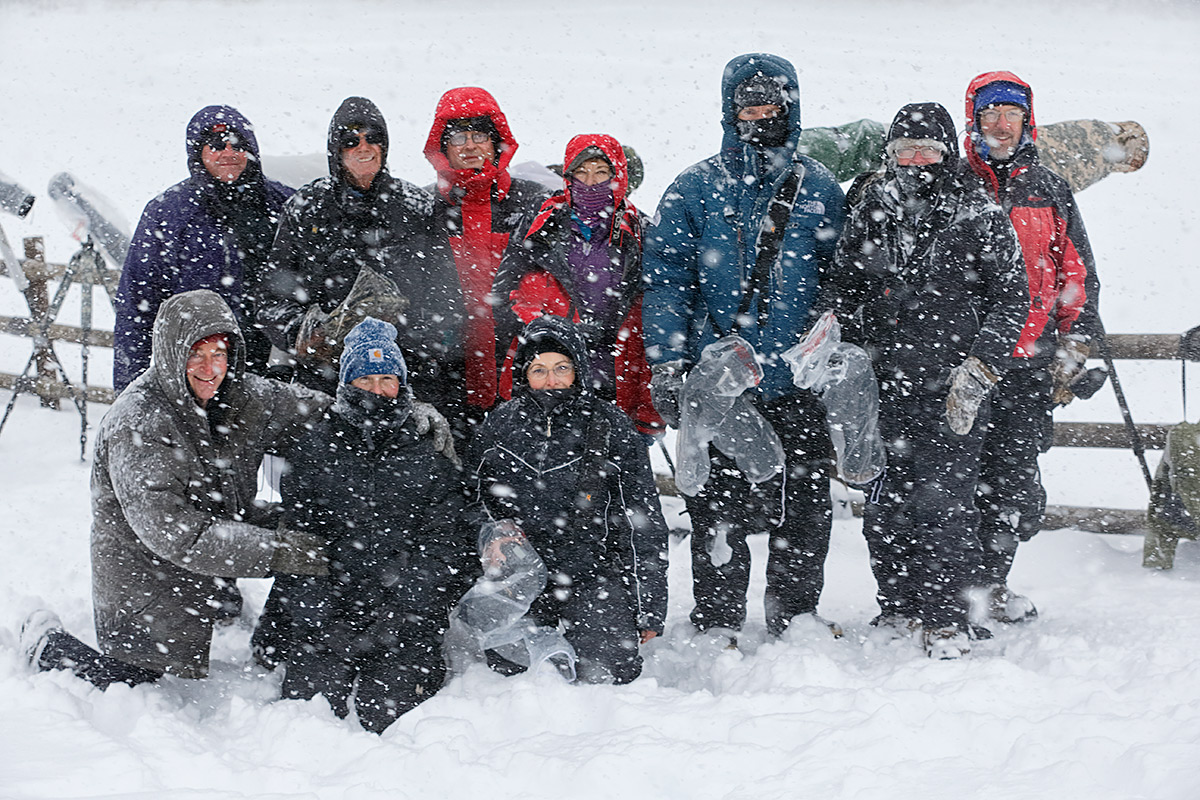
|
|
The group and the leaders in the early morning remnants of the blizzard. From back left to right clockwise: Lex Franks, Malcolm MacKenzie, Srdjan Mitrovic, Debbie Franks, Paul McKenzie, Pat & Alan Lillich, Zorica Kovacevic, Denise Ippolito, and yours truly.
|
The Blizzard
Be careful what you wish for; you just may get it. We awoke on February 16 to ten inches of soft snow with a stiff northwest wind blowing the stuff sideways. We were all dressed and ready to leave when our guide announced that all roads were closed. We enjoyed a leisurely breakfast and then got dressed again to leave at 8:30 only to learn that our guide had gone scouting and “would be back in a while.” In the meantime the snow continued to pile up.
Finally at about 10:30am we got dressed for a third time and drove the 5 minutes to the Tsurui-Ito Tancho Sanctuary. There were three very distant cranes that were visible at times through the white out. The cameras could not focus. We hung around for several hours and the storm subsided just a bit. Red-crowned Cranes began to arrive in numbers. With the continued heavy snow getting autofocus to lock on was difficult. Properly exposed, the images on the rear LCDs looked just like the whiteout. But fun we had.
For hours. By about 3:30 most of us quit soaking wet and shivering cold. Paul and Alan & Pat stayed on and enjoyed another great hour.
|
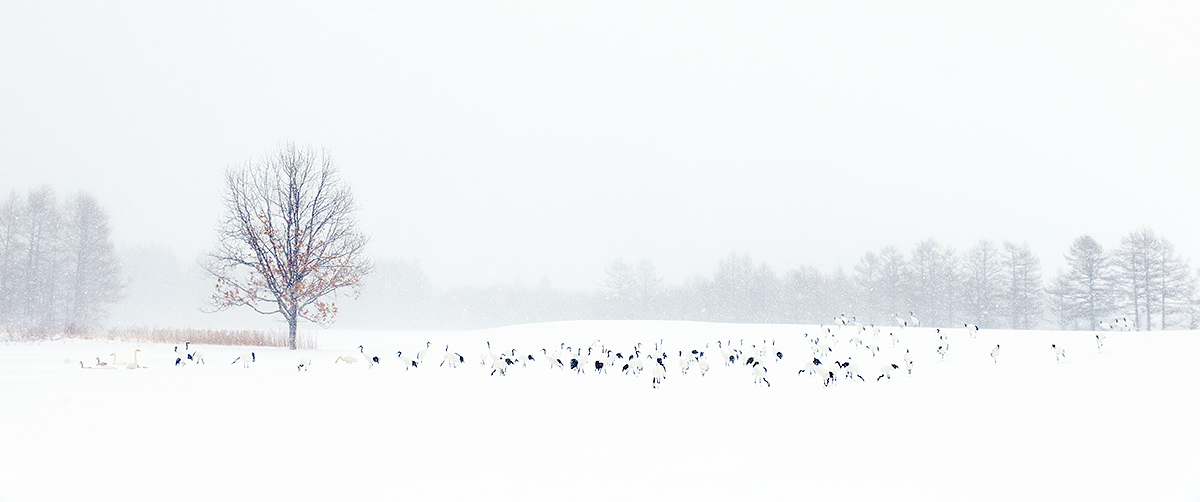
|
|
This image was created on Day 4 of the Japan in Winter IPT with the Canon EF 24-70mm f/2.8L II USM lens (hand held at 45mm) and the Canon EOS 5D Mark III. ISO 800. Evaluative metering +2 1/3 stops at 1:03pm: 1/500 sec. at f/8 in Manual mode. AWB.
Central sensor/AI Servo/Surround Rear Focus AF on the nearest crane and re-compose. Click here to see the latest version of the Rear Focus Tutorial. Be sure to click on the image to enjoy the larger version.
|
The Pano
For the image above I created the lazy man’s pano, using a wide angle lens and then cropping. Absolutely perfect technique would have called for using the tripod-mounted 70-200 f/2.8L IS II, creating six or seven verticals, and stitching them together in Photoshop.
White on White
Again, the properly exposed RAW file for the image above looked completely washed out. Many in the group could not believe that creating a work of art from the RAW file would be quick and easy. I will share the image optimization technique with you here soon.
Was it Worth It?
In your opinion, was it worth it staying out in the blizzard?
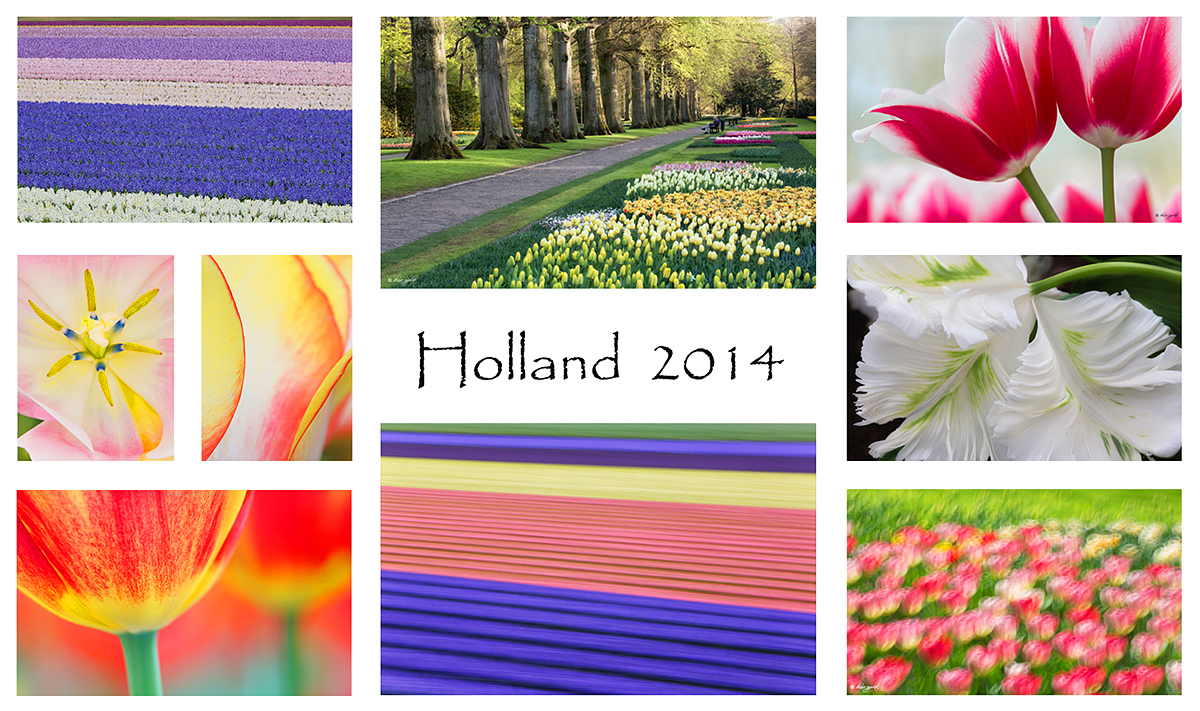
|
|
Images copyright 2012: Denise Ippoltio & Arthur Morris. Card design by Denise Ippolito. Click on the image to enjoy a spectacular larger version.
|
Holland 2014 7 1/2-Day/8-Night: A Creative Adventure/BIRDS AS ART/Tulips & A Touch of Holland IPT. April 17-April 24, 2014: $4995 Limit: 12/Openings: 5
Act soon: this trip is a go and is filling quickly.
Join Denise Ippolito, Flower Queen and the author of “Bloomin’ Ideas,” and Arthur Morris, Canon Explorer of Light Emeritus and one of the planet’s premier photographic educators for a great trip to Holland in mid-April 2014. Day 1 of the IPT will be April 17, 2014. We will have a short afternoon get-together and then our first photographic session at the justly-famed Keukenhof. Most days we will return to the hotel for lunch, image sharing and a break. On Day 8, April 24, we will enjoy both morning and afternoon photography sessions.
The primary subjects will be tulips and orchids at Keukenhof and the spectacularly amazing tulip, hyacinth, and daffodil bulb fields around Lisse. In addition we will spend one full day in Amsterdam. There will be optional visits the Van Gogh Museum in the morning and the Anne Frank House in the afternoon; there will be plenty of time for street photography as well. And some great food. On another day we will have a wonderful early dinner at Kinderdijk and then head out with our gear to photograph the windmills and possibly some birds for those who bring their longs lenses. We will spend an afternoon in the lovely Dutch town of Edam where we will do some street photography and enjoy a superb dinner. All lodging, ground transportation, entry fees, and meals (from dinner on Day 1 through dinner on Day 7) are included. For those who will be bringing a big lens we will likely have an optional bird photography afternoon or two.
Click here for additional info or to register.

|
|
Join me for the 2014 Tanzania Summer Safari!
|
2014 Tanzania Summer Safari, 14-day African Adventure/leave the US on August 9. Fly home on August 24: $12,999.
Co-leaders Todd Gustafson & Arthur Morris. The limit is 12. Three photographers/van; you get your own row of seats. Our trip is a bit more expensive than the average safari for good reason. It is the best. We have the best driver guides with a total of decades of experience. They have been trained over the years by Todd and by me to drive with photography in mind. We have the best and most knowledgeable leaders. We stay in the best lodges and camps. We hope that you will join us for what will be Todd’s 35th African safari, and my 8th.
If you are seriously interested please e-mail me; I will be glad to send you the illustrated PDF with the complete itinerary and deposit info.
What else makes this expedition unique?
•Pre-trip consultation and camera equipment advice
•Award-winning photographers as your guides
•A seamless itinerary visiting the right locations at the best time of year
•Hands-on photography instruction in the field
•Specially designed three roof-hatch photo safari vehicles
•Proprietary materials for preparation, including free copy of “A Photographer’s Guide to Photographing in East Africa.”
•Post-safari image critiques
All-inclusive (double-occupancy) except for your flights to and from Kilamajaro Airport, bar drinks, soda & water (except at the Intimate Tented Camp where everything is free for our entire stay), tips for drivers and camp staff, personal items, and trip insurance.

|
|
Breathe deeply, bite the bullet, and live life to its fullest; we all get only one ride on the merry-go-round… Join me on this great trip.
Click on the image to enjoy a larger version.
|
The Southern Ocean…
If you would like to explore the possibility of joining me on the Cheesemans’ Ecology Safaris Antarctica/The Extended Expedition Voyage< trip: Antarctic Peninsula, South Georgia and Falkland Islands: December 13, 2014 to January 10, 2015, click here for additional information and then shoot me an e-mail.
The DPP RAW Conversion Guide
To learn why I use Canon’s Digital Photo Professional (DPP) to convert every image that I work on, click here.
Support the BAA Blog. Support the BAA Bulletins: Shop B&H here!
We want and need to keep providing you with the latest free information, photography and Photoshop lessons, and all manner of related information. Show your appreciation by making your purchases immediately after clicking on any of our B&H or Amazon Affiliate links in this blog post. Remember, B&H ain’t just photography!


 


Amazon
Everyone buys something from Amazon, be it a big lens or deodorant. Support the blog by starting your search by clicking on the logo-link below. No purchase is too small to be appreciated; they all add up. Why make it a habit? Because I make it a habit of bringing you new images and information on an almost daily basis.
Typos
In all blog posts and Bulletins, feel free to e-mail or to leave a comment regarding any typos, wrong words, misspellings, omissions, or grammatical errors. Just be right. 🙂
IPT Info
Many of our great trips are filling up. See especially info on the South Florida, Holland, and Nickerson Beach IPTs. Two great leaders on most trips ensure that you will receive individual attention, have all of your questions answered, and learn a ton including how to think like a pro, see the situation, and get the right exposure every time. In addition you will have fun, and make lots of great images. Click here for IPT details and general information.
February 16th, 2014 And The Streak Continues…
After a slow start with a 10-inch white-out blizzard we enjoyed a fabulous afternoon of Red-crowned Crane photography with the snow still falling. We photographed at the sanctuary just minutes from the lodge where we are staying. Despite the fact that I took a nap after most of us quit early, wet and cold, I am beat. It is time for bed: 8:01 pm here in Japan as I am about to hit “Publish”.
This post marks 79 straight days with a new educational blog post, a record by far that should be extended for at least another day or so, or not. Or more…. It appears that our lodge has great internet. To show your appreciation for my efforts here, we ask that use our B&H and Amazon affiliate links for all of your B&H and Amazon purchases. Please check the availability of all photographic accessories in the BIRDS AS ART Online Store. We sell only what I use and depend on. We will not sell you junk. We know what you need to make creating great images easy and fun. And we are always glad to answer your gear questions via e-mail.
You can find the following items in the store: Gitzo tripods, Mongoose M3.6 and Wimberley heads, plates, low feet, and accessories, flash brackets, , Delkin e-film Pro Compact Flash Cards, LensCoat products, and our unique line-up of educational materials including ABP I & II, Digital Basics, Site and Set-up e-Guides, Canon and Nikon Camera Users and AF e-Guides, and MP-4 Photoshop video tutorials among others.
We would of course appreciate you using our B&H and Amazon affiliate links for all of your B&H and Amazon major gear, video, electronic, household, and personal purchases. For the photographic stuff mentioned in the paragraph above we would of course greatly appreciate your business. Here is a huge thank you to the many who have been using our links on a regular basis and visiting the BAA Online store as well.
Today’s blog post took 2 1/2 hours to prepare. It’s late, and I gotta get up soon. No rest for the weary.
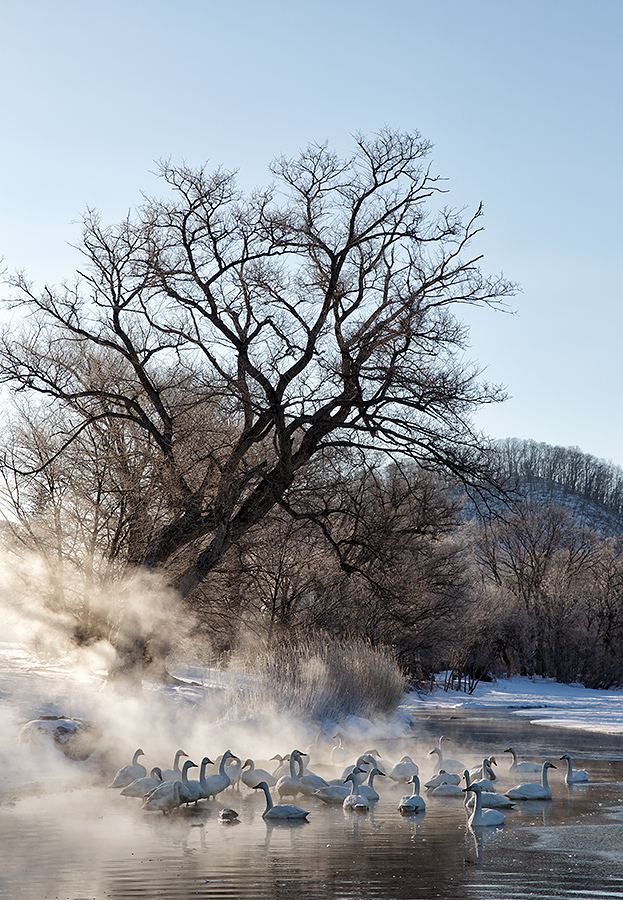
|
|
This image was created on Day 3 of the Japan in Winter IPT with the Canon EF 24-70mm f/2.8L II USM lens (hand held at 70mm) and the Canon EOS 5D Mark III. ISO 400. Evaluative metering +1/3 stop at 7:46am: 1/640 sec. at f/11 in Av mode. Color temperature: AWB.
Central sensor/AI Servo/Surround Rear Focus AF on the nearest swan in the lower right and re-compose. Click here to see the latest version of the Rear Focus Tutorial. Click on the image to see a larger version.
Image #1: Whooper Swans in Morning Mist
|
Canon EF 24-70mm f/2.8L II USM Lens: Early Impressions
While I am anything but a sharpness fanatic and often claim the inability to see differences in fine detail I can say that the new 24-70 is noticeably sharper than the Canon EF 24-105mm f/4L IS USM lens that it replaced. Edge to edge sharpness especially is improved, that without the benefit of IS. As the two lenses weigh about the same and are roughly the same size, keeping the new lens in one of the large pockets of my Xtrahand Vest (as I always did with the 24-105mm) is a snap.
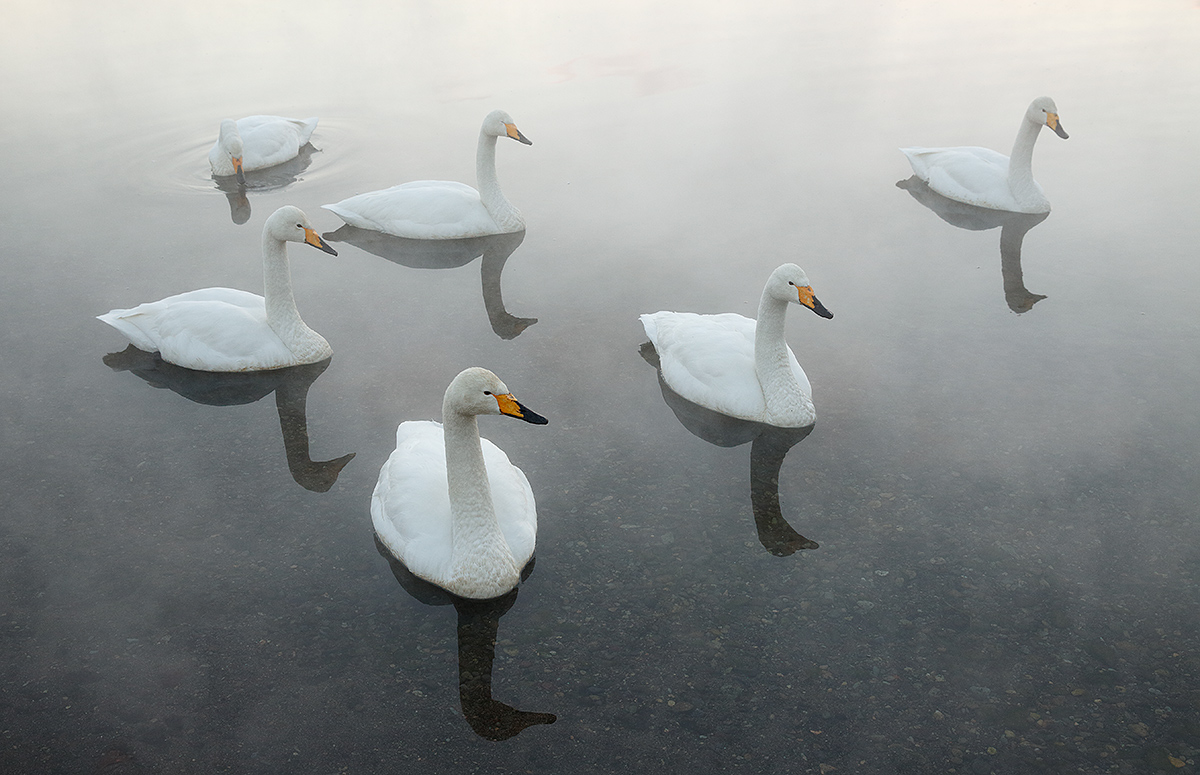
|
|
This image was also created on Day 3 of the Japan in Winter IPT with the Canon EF 24-70mm f/2.8L II USM lens (hand held at 39mm) and the Canon EOS 5D Mark III. ISO 800. Evaluative metering +1 stop at 4:48pm: 1/80 sec. at f/6.3 in Av mode. Color temperature: 10,000K.
One sensor down and one sensor to the left of the Central sensor/AI Servo/Surround Rear Focus AF on the face of the nearest swan active at the moment of exposure. Click here to see the latest version of the Rear Focus Tutorial. Click on the image to see a larger version.
Image #2: A Half-dozen Whooper Swans
|
Whooper Swan Images
Visiting Lake Kusharo with its tame wintering Whooper Swans gave me a chance to put the new short zoom lens to the test. Thanks to our guide, Makota Ando and co-leader Paul Mckenzie for sharing two of their favorite off-the-beaten path swan spots with the group. For the image above Paul coached the group: “Look for pleasing arrangements of the swans and make to avoid all merges.” I listened.
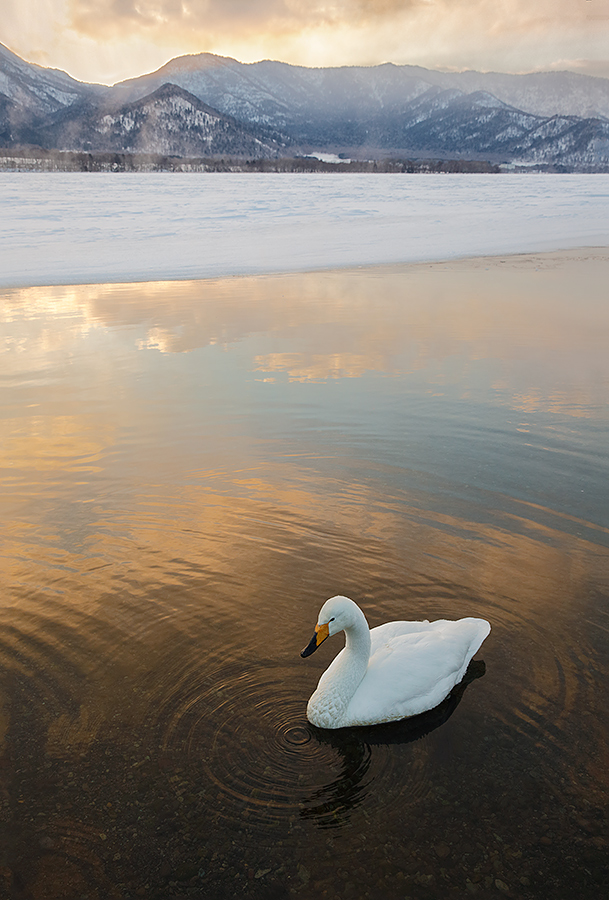
|
|
This image was also created on Day 3 of the Japan in Winter IPT with the Canon EF 24-70mm f/2.8L II USM lens (hand held at 39mm) and the Canon EOS 5D Mark III. ISO 400. Evaluative metering +1 stop at 4:26pm: 1/100 sec. at f/9 in Av mode. Color temperature: 10,000K.
Five sensors down from the central sensor/AI Servo/Surround Rear Focus AF on the face of the nearest swan and re-compose slightly. Click here to see the latest version of the Rear Focus Tutorial. Click on the image to see a larger version.
Image #3: A Hint of Color
|
You Favorite
Take a moment to leave a comment and let us know which of the three images above was your favorite, and be sure to let us know why you made your choice.
|

|
|
If you’d like to learn from the two folks who created the images in the composite above do consider one of the trips below. Denise Ippolito’s images: Japanese leaf painting, skimmer in flight, curved Keukenhof paths with tulips, copulating terns, & pink dahlia. Artie’s images: Snow Geese snowstorm blur, crane landing silhouettes, Leopard with prey in tree, King Penguin, & vertical tulip. Note: Denise alone will be leading the Torres del Paine workshop.
|
A Creative Adventure/BIRDS AS ART Instructional Photo-Tours (IPTs)/Two great leaders: Arthur Morris & Denise Ippolito.
Arthur Morris/BIRDS AS ART www.BIRDSASART-blog.com for the latest images, info, & education
Denise Ippolito/A Creative Adventure www.deniseippolito.com: get yourself out of the box!
Denise’s e-books: Bloomin’ Ideas, A Guide to Filters & Effects, The Softer Side of Macro, & more. Free Monthly Creative MiniMag: www.deniseippolito.com/magazine
Nickerson Baby Beach-nesting Birds IPT, Long Island, NY: 3-Full Days/July 22-24, 2014: $1199.
Black Skimmers, Common Terns with chicks, American Oystercatcher & Piping Plover families; breeding behaviors including courtship feeding, display flight and combat, and copulations. Gulls and shorebirds.
UK Puffins IPT. Early July, 2014.
Details TBA. Please e-mail to be placed on the interested list.
Tanzania Serengeti Summer Safari: Leave US: August 9—return: August 24, 2014: $12,999.
Co-leaders: Arthur Morris & Todd Gustafson. Wildebeest/The Great Migration, cats, elephant, giraffe, zebra, birds & more. Please e-mail for brochure.
Swan Island Dahlia Farm IPT, Canby, OR, September 8-12, 2014: 5 FULL DAYS: $1699.
Leader: Denise Ippolito. 40 acres with 350+dazzling varieties of dahlias in a plethora of colors, shapes and sizes. Sharpen your technical skills and boost your creative juices. Daily assignments, image sharing, and Photoshop sessions.
Bosque del Apache 2014 A Creative Adventure/BIRDS AS ART “Creative Photography Instructional Photo-Tour.” (IPT). NOV 24-25, 2014. 2-FULL DAYS: $729.
Leaders: Denise Ippolito & Arthur Morris. Introductory Slide program: 7:00pm on Sunday 11/23. This IPT is perfect for folks who want to learn to think outside the box, to create new and different images. Learn to unleash your creative juices at the wondrous Bosque del Apache, NWR in San Antonio, NM.
Bosque del Apache 2014 BIRDS AS ART/A Creative Adventure Instructional Photo-Tour (IPT). NOV 29-DEC 3, 2014. Totaling 4 FULL-DAYS: $1449
Leaders: Arthur Morris and Denise Ippolito. Introductory Slide program: 7:00pm on Sunday 11/29. Tens of thousand of Snow Geese, 10,000 Sandhill Cranes, ducks, amazing sunrises, sunsets, and blast-offs. Live, eat, and breathe photography with two of the world’s premier photographic educators at one of their very favorite photography locations on the planet.
Antarctica/The Extended Expedition Voyage: Antarctic Peninsula, South Georgia and Falkland Islands: December 13, 2014 to January 10, 2015.
Please e-mail for details.
BAA offers a wide range of books, e-Guides, and educational materials and photographic accessories at the lowest prices around—25+ years of experience, and the best advice you can get. We will not sell you junk. Access the BAA Store here or call us at 1-863-692-0906.
Questions? Please e-mail us at birdsasart@verizon.net or photographybydenise221@gmail.com.
Support the BAA Blog. Support the BAA Bulletins: Shop B&H here!
We want and need to keep providing you with the latest free information, photography and Photoshop lessons, and all manner of related information. Show your appreciation by making your purchases immediately after clicking on any of our B&H or Amazon Affiliate links in this blog post. Remember, B&H ain’t just photography!


 


Amazon
Everyone buys something from Amazon, be it a big lens or deodorant. Support the blog by starting your search by clicking on the logo-link below. No purchase is too small to be appreciated; they all add up. Why make it a habit? Because I make it a habit of bringing you new images and information on an almost daily basis.
Typos
In all blog posts and Bulletins, feel free to e-mail or to leave a comment regarding any typos, wrong words, misspellings, omissions, or grammatical errors. Just be right. 🙂
IPT Info
Many of our great trips are filling up. See especially info on the Holland, Nickerson Beach, and Bosque IPTs. Two great leaders on most trips ensure that you will receive individual attention, have all of your questions answered, and learn a ton including how to think like a pro, see the situation, and get the right exposure every time. In addition you will have fun, and make lots of great images. Click here for IPT details and general information.
February 15th, 2014 And The Streak Continues…
We had a great day today with the Red-crowned Cranes and the raptors. Our days are so jam-packed with photography that I have not even looked at a single image from today. And it is time for bed: almost 8:30pm. We are all excited as the forecast is for 10 inches of snow tonight!
This post marks 78 straight days with a new educational blog post, a record by far that should be extended for at least another day or so, or not. Or more…. It appears that our lodge has great internet. To show your appreciation for my efforts here, we ask that use our B&H and Amazon affiliate links for all of your B&H and Amazon purchases. Please check the availability of all photographic accessories in the BIRDS AS ART Online Store. We sell only what I use and depend on. We will not sell you junk. We know what you need to make creating great images easy and fun. And we are always glad to answer your gear questions via e-mail.
You can find the following items in the store: Gitzo tripods, Mongoose M3.6 and Wimberley heads, plates, low feet, and accessories, flash brackets, , Delkin e-film Pro Compact Flash Cards, LensCoat products, and our unique line-up of educational materials including ABP I & II, Digital Basics, Site and Set-up e-Guides, Canon and Nikon Camera Users and AF e-Guides, and MP-4 Photoshop video tutorials among others.
We would of course appreciate you using our B&H and Amazon affiliate links for all of your B&H and Amazon major gear, video, electronic, household, and personal purchases. For the photographic stuff mentioned in the paragraph above we would of course greatly appreciate your business. Here is a huge thank you to the many who have been using our links on a regular basis and visiting the BAA Online store as well.
Today’s blog post took 1 1/2 hours to prepare. It’s late, and I gotta get up soon. Again!
Tobu Tori Answers
At times on the blog folks ask such insightful questions that the original lesson may pale by comparison to the answers. Such was the case with yesterday’s blog post. As the lessons were so important and relevant to flight photography I did not want to risk folks missing the material.
Quazi Ahmed Hussain
February 14, 2014 at 1:08 pm
Some stunning images. Thanks for posting. Could you please explain ‘at f/6.3 in Manual mode was an underexposure?
Thanks in advance. Quazi
Arthur Morris/BIRDS AS ART
February 14, 2014 at 3:47 pm
It was an underexposure because I noticed–after the fact, that the histogram was much too far to the left. It was a difficult situation and the action was fast paced. Different settings were required for the various species as they were all of different tonalities…. With their bright whites sunlit the cranes and the Steller’s Sea-Eagles required the least light, the white-tailed needed a bit more light as the white tail is not as bright at the whites on the two previous birds, and the black-eared needed a third stop more light.
I began by over-estimating the amount of light and compounded my errors from there until I finally got it right for the flying crane.
As always, learn everything that you need to know about exposure for nature photography in the two-book bundle: ABP and ABP II.
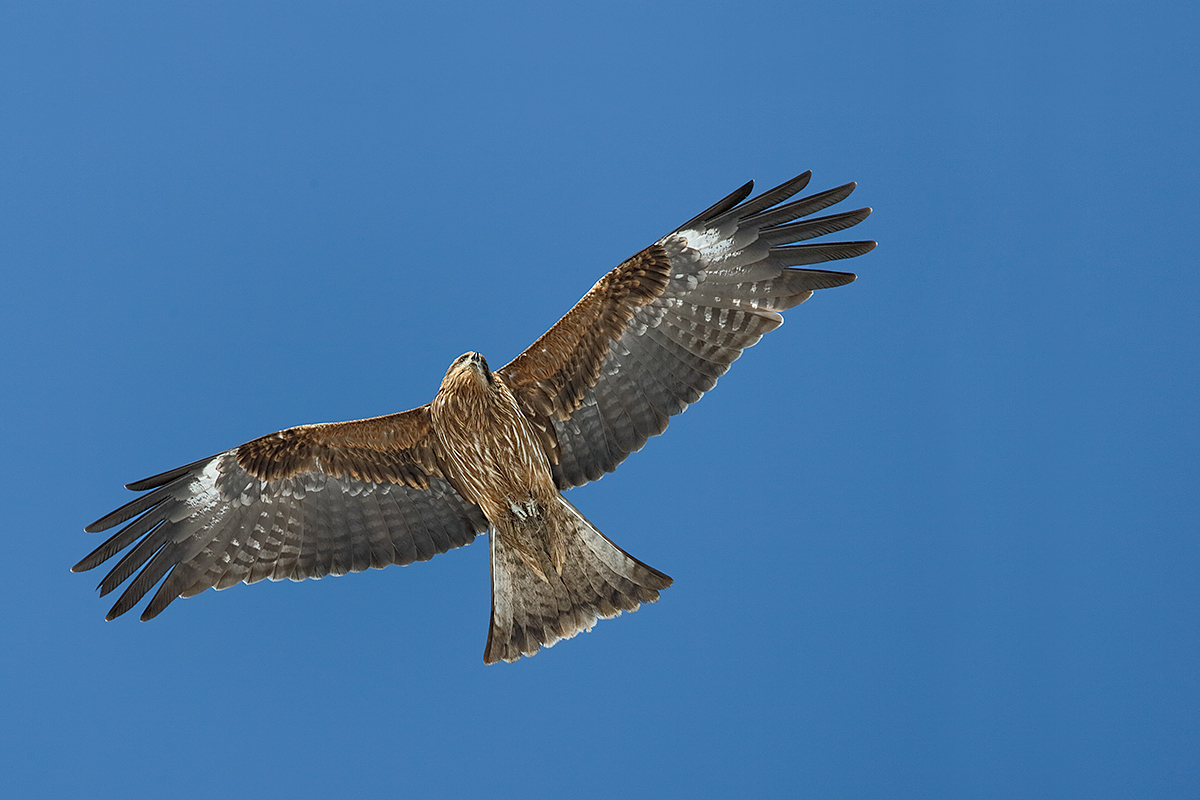
|
|
This Black-eared Kite flight image was also created on the Japan in Winter IPT with the Canon EF 200-400mm f/4L IS USM Lens with Internal 1.4x Extender (hand held with the internal extender in place at 506mm) and the Canon EOS-1D X. ISO 400: 1/1250 sec. at f/6.3 in Manual mode was more than 1/2 stop too dark. AWB.
Central Sensor/AI Servo-Surround/Rear Focus AF on the bird’s right wing as originally framed was active at the moment of exposure. Click here to see the latest version of the Rear Focus Tutorial. Click on the image to see a larger version.
Image #2: Black-eared Kite
|
Chris Houston
February 14, 2014 at 2:30 pm
Really nice photos. I can’t choose between the three raptor shots for my favorite. Since I’ve been trying recently to improve my flight photography I’m even more impressed than usual. It’s not nearly as easy as you make it look to get the light and positioning and composition and sharp focus right!
Either that or maybe you’re a bird whisperer and when they see you the birds all just fly right at you to give you perfect shots. 🙂
Arthur Morris/BIRDS AS ART
February 14, 2014 at 4:01 pm
Actually it is just a matter of understanding the direction of the wind, the light, and bird behavior. As I think I mentioned above, we had pretty much the worst possible flight conditions: fairly bright sun with the wind pretty much in our face though a bit from north. I instructed the group to watch for birds turning and circling to get in on the action and for birds flying the wrong way for whatever reason. After that it is just a matter or pressing the shutter button when the bird is in the zone: coming towards you (and the light)or at least not flying away and filling a suitable amount of the frame. Strength–which I do not have much of, and hand-eye coordination are also major factors but they are trumped by understanding the situation and knowing bird behavior and understanding how the direction of the wind and the direction of the light affect the photography of tobu tori….
Best way to learn all of this stuff: join us on an IPT that features lots of flight photography like this one:
Bosque del Apache 2014 BIRDS AS ART/A Creative Adventure Instructional Photo-Tour (IPT). NOV 29-DEC 3, 2014. Totaling 4 FULL-DAYS: $1449. Leaders: Arthur Morris and Denise Ippolito. Introductory Slide program: 7:00pm on Sunday 11/29.
Tens of thousand of Snow Geese, 10,000 Sandhill Cranes, ducks, amazing sunrises, sunsets, and blast-offs. Live, eat, and breathe photography with two of the world’s premier photographic educators at one of their very favorite photography locations on the planet. Top-notch in-the-field and Photoshop instruction. This will make 21 consecutive Novembers at Bosque for artie. This will be denise’s 6th workshop at the refuge. Nobody knows the place better than artie does. Join us to learn to think like a pro, to recognize situations and to anticipate them based on the weather, especially the sky conditions, the light, and the wind direction. Every time we make a move we will let you know why. When you head home being able to apply what you’ve learned on your home turf will prove to be invaluable.
Learn more by scrolling down here.
APTATS II
I used techniques from APTATS II to move the birds in each of the images above into a more pleasing position in the frame. The crane image took about 20 seconds, the kite image about 90 seconds as I needed to move the bird with four separate operations and four Layer Masks.
Mention this blog post and Jim will be glad to apply a $10 discount on your APTATS II purchase with phone orders only. Throw in APTATS I to hone your Photoshop image clean-up skills and Jim will be glad to enter a $15 discount for the pair, again, on phone orders only.
The DPP RAW Conversion Guide
To learn why I use Canon’s Digital Photo Professional (DPP) to convert every image that I work on, click here.
Your Favorite?
Please take a moment to leave a comment and let us know which of the two images above you feel is stronger. And be sure to let us know why.
|

|
|
Images copyright 2012: Denise Ippolito & Arthur Morris. Card design by Denise Ippolito. Click on the image to enjoy a spectacular larger version.
|
Holland 2014 7 1/2-Day/8-Night: A Creative Adventure/BIRDS AS ART/Tulips & A Touch of Holland IPT. April 17-April 24, 2014: $4995 Limit: 12/Openings: 5
Act soon: this trip is a go and is filling quickly.
Join Denise Ippolito, Flower Queen and the author of “Bloomin’ Ideas,” and Arthur Morris, Canon Explorer of Light Emeritus and one of the planet’s premier photographic educators for a great trip to Holland in mid-April 2014. Day 1 of the IPT will be April 17, 2014. We will have a short afternoon get-together and then our first photographic session at the justly-famed Keukenhof. Most days we will return to the hotel for lunch, image sharing and a break. On Day 8, April 24, we will enjoy both morning and afternoon photography sessions.
The primary subjects will be tulips and orchids at Keukenhof and the spectacularly amazing tulip, hyacinth, and daffodil bulb fields around Lisse. In addition we will spend one full day in Amsterdam. There will be optional visits the Van Gogh Museum in the morning and the Anne Frank House in the afternoon; there will be plenty of time for street photography as well. And some great food. On another day we will have a wonderful early dinner at Kinderdijk and then head out with our gear to photograph the windmills and possibly some birds for those who bring their longs lenses. We will spend an afternoon in the lovely Dutch town of Edam where we will do some street photography and enjoy a superb dinner. All lodging, ground transportation, entry fees, and meals (from dinner on Day 1 through dinner on Day 7) are included. For those who will be bringing a big lens we will likely have an optional bird photography afternoon or two.
Click here for additional info or to register.

|
|
Join me for the 2014 Tanzania Summer Safari!
|
2014 Tanzania Summer Safari, 14-day African Adventure/leave the US on August 9. Fly home on August 24: $12,999.
Co-leaders Todd Gustafson & Arthur Morris. The limit is 12. Three photographers/van; you get your own row of seats. Our trip is a bit more expensive than the average safari for good reason. It is the best. We have the best driver guides with a total of decades of experience. They have been trained over the years by Todd and by me to drive with photography in mind. We have the best and most knowledgeable leaders. We stay in the best lodges and camps. We hope that you will join us for what will be Todd’s 35th African safari, and my 8th.
If you are seriously interested please e-mail me; I will be glad to send you the illustrated PDF with the complete itinerary and deposit info.
What else makes this expedition unique?
•Pre-trip consultation and camera equipment advice
•Award-winning photographers as your guides
•A seamless itinerary visiting the right locations at the best time of year
•Hands-on photography instruction in the field
•Specially designed three roof-hatch photo safari vehicles
•Proprietary materials for preparation, including free copy of “A Photographer’s Guide to Photographing in East Africa.”
•Post-safari image critiques
All-inclusive (double-occupancy) except for your flights to and from Kilamajaro Airport, bar drinks, soda & water (except at the Intimate Tented Camp where everything is free for our entire stay), tips for drivers and camp staff, personal items, and trip insurance.

|
|
Breathe deeply, bite the bullet, and live life to its fullest; we all get only one ride on the merry-go-round… Join me on this great trip.
Click on the image to enjoy a larger version.
|
The Southern Ocean…
If you would like to explore the possibility of joining me on the Cheesemans’ Ecology Safaris Antarctica/The Extended Expedition Voyage< trip: Antarctic Peninsula, South Georgia and Falkland Islands: December 13, 2014 to January 10, 2015, click here for additional information and then shoot me an e-mail.
The DPP RAW Conversion Guide
To learn why I use Canon’s Digital Photo Professional (DPP) to convert every image that I work on, click here.
Support the BAA Blog. Support the BAA Bulletins: Shop B&H here!
We want and need to keep providing you with the latest free information, photography and Photoshop lessons, and all manner of related information. Show your appreciation by making your purchases immediately after clicking on any of our B&H or Amazon Affiliate links in this blog post. Remember, B&H ain’t just photography!


 


Amazon
Everyone buys something from Amazon, be it a big lens or deodorant. Support the blog by starting your search by clicking on the logo-link below. No purchase is too small to be appreciated; they all add up. Why make it a habit? Because I make it a habit of bringing you new images and information on an almost daily basis.
Typos
In all blog posts and Bulletins, feel free to e-mail or to leave a comment regarding any typos, wrong words, misspellings, omissions, or grammatical errors. Just be right. 🙂
IPT Info
Many of our great trips are filling up. See especially info on the South Florida, Holland, and Nickerson Beach IPTs. Two great leaders on most trips ensure that you will receive individual attention, have all of your questions answered, and learn a ton including how to think like a pro, see the situation, and get the right exposure every time. In addition you will have fun, and make lots of great images. Click here for IPT details and general information.
February 14th, 2014 The Streak Goes On…
After sleeping late to 4:00am we had a great day with the Whooper Swans.
This post marks 77 straight days with a new educational blog post, a record by far that should be extended for at least another day or so, or not. Or more…. It appears that our lodge has great internet. To show your appreciation for my efforts here, we ask that use our B&H and Amazon affiliate links for all of your B&H and Amazon purchases. Please check the availability of all photographic accessories in the BIRDS AS ART Online Store. We sell only what I use and depend on. We will not sell you junk. We know what you need to make creating great images easy and fun. And we are always glad to answer your gear questions via e-mail.
You can find the following items in the store: Gitzo tripods, Mongoose M3.6 and Wimberley heads, plates, low feet, and accessories, flash brackets, , Delkin e-film Pro Compact Flash Cards, LensCoat products, and our unique line-up of educational materials including ABP I & II, Digital Basics, Site and Set-up e-Guides, Canon and Nikon Camera Users and AF e-Guides, and MP-4 Photoshop video tutorials among others.
We would of course appreciate you using our B&H and Amazon affiliate links for all of your B&H and Amazon major gear, video, electronic, household, and personal purchases. For the photographic stuff mentioned in the paragraph above we would of course greatly appreciate your business. Here is a huge thank you to the many who have been using our links on a regular basis and visiting the BAA Online store as well.
Today’s blog post took 1 1/2 hours to prepare. It’s late: I gotta get up soon!
|
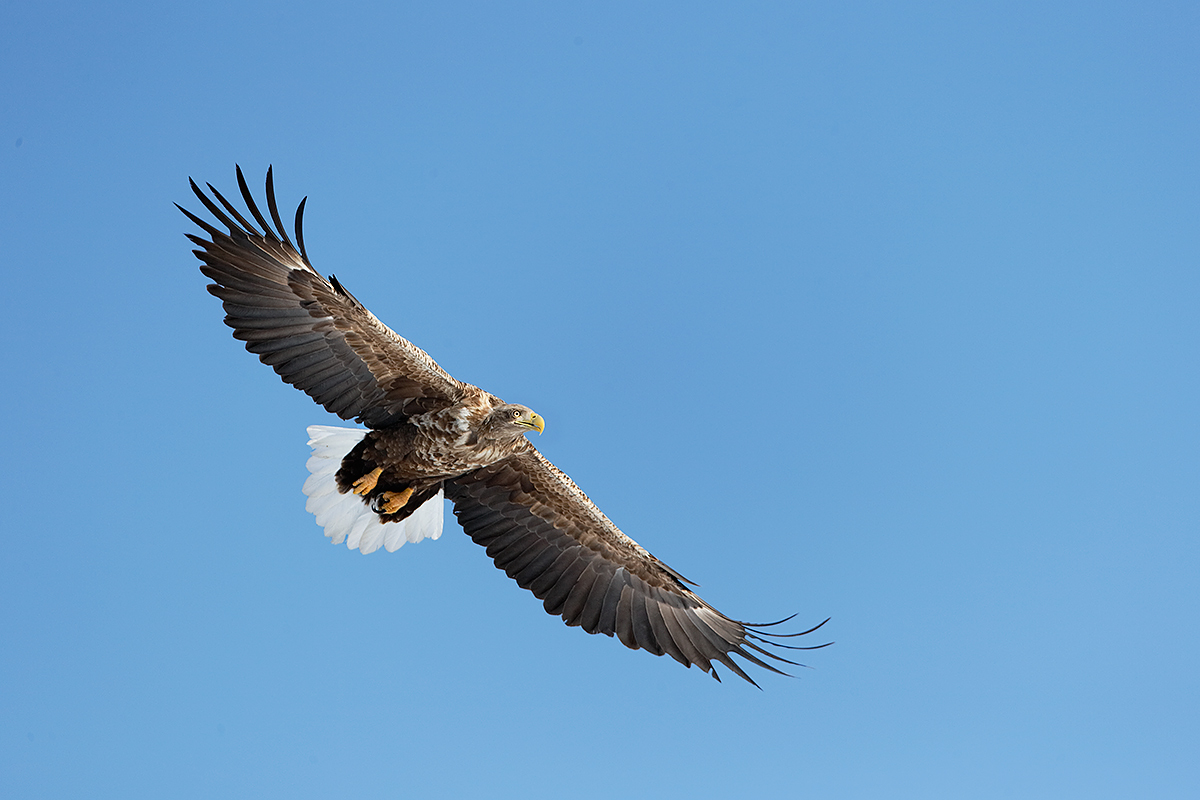
|
|
This White-tailed Sea Eagle flight image was created on the Japan in Winter IPT with the Canon EF 200-400mm f/4L IS USM Lens with Internal 1.4x Extender (hand held with the internal extender in place at 490mm) and the Canon EOS-1D X. ISO 400. Evaluative metering +1/3 stop: 1/2000 sec. at f/6.3 in Manual mode was an underexposure. AWB.
Central Sensor/AI Servo-Surround/Rear Focus AF barely caught the tip of the bird’s bill and was active at the moment of exposure. Click here to see the latest version of the Rear Focus Tutorial. Click on the image to see a larger version.
Image #1: White-tailed Sea Eagle
|
The 200-400 with Internal 1.4X Extender and Friend Do Tobu Tori
As you can see with the three opening images here, the Canon 200-400mm with Internal TC is a killer hand held flight lens. On our first afternoon, it was a dead slaughter. The cranes are fed fish at the Akan Crane Center and a variety of raptors seemingly appear out of nowhere in an attempt to steal a free lunch. The more I use the 2-4 for hand held flight photography the easier the process becomes. The lens is so compact that it seems to weigh a lot less than it actually does. And the more you practice with the positioning of your hands on the lens the easier it becomes to zoom out when needed; note the 490mm focal length for the image above where I zoomed out from 560mm to better fit and place subject in the frame. And with the 1D X every image where I had the sensors anywhere near the bird’s head, face, or neck were razor sharp on the eye.
|
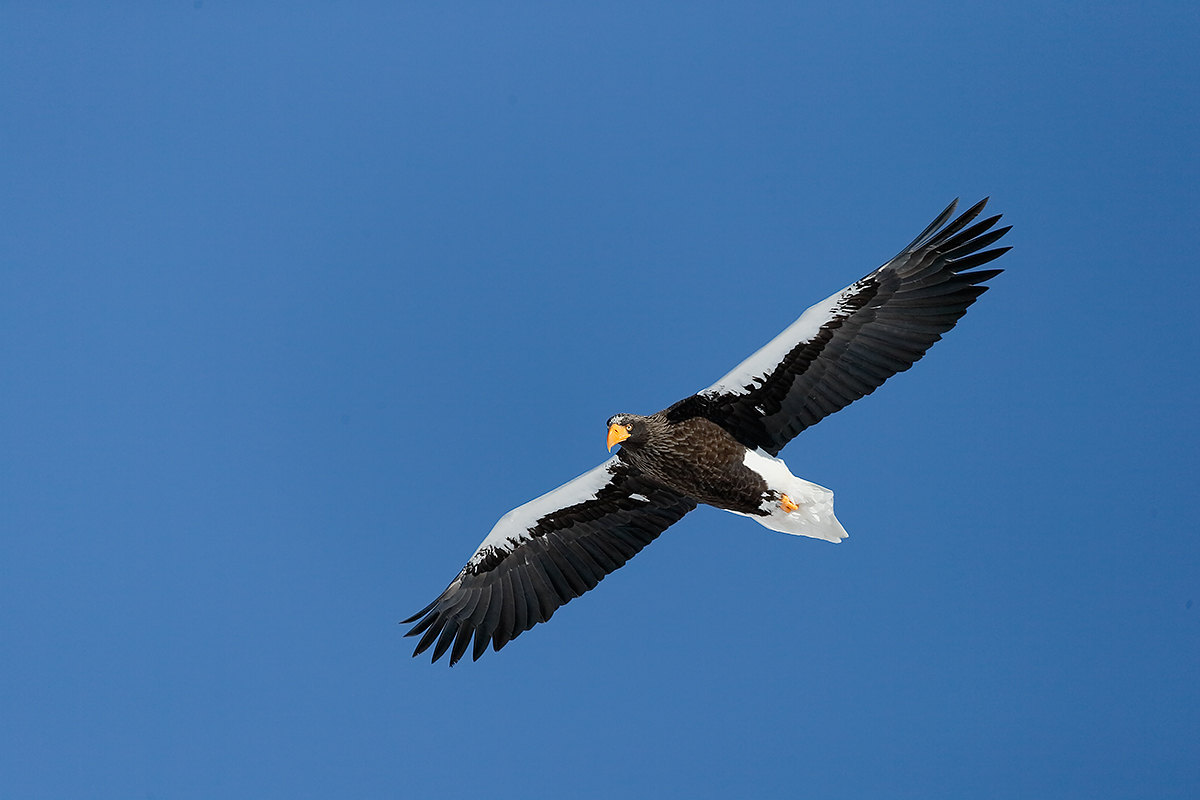
|
|
This Steller’s Sea Eagle flight image was created on the Japan in Winter IPT with the Canon EF 200-400mm f/4L IS USM Lens with Internal 1.4x Extender (hand held with the internal extender in place at 560mm) and the Canon EOS-1D X. ISO 400. Evaluative metering -1/3 stop: 1/3200 sec. at f/6.3 in Manual mode was an also an underexposure. AWB.
Central Sensor/AI Servo-Surround/Rear Focus AF caught the bird’s head and was active at the moment of exposure. Click here to see the latest version of the Rear Focus Tutorial. Click on the image to see a larger version.
Image #2: Steller’s Sea Eagle
|
Steller’s Sea Eagle is not a common bird at the Akan Crane Center. On our first visit, there were two. We got more great news today, with the total absence of sea ice at Rausu until a few days ago, our 4 sea eagle flight photography sessions were in doubt. But with the current cold snap the eagle boats are now running again.
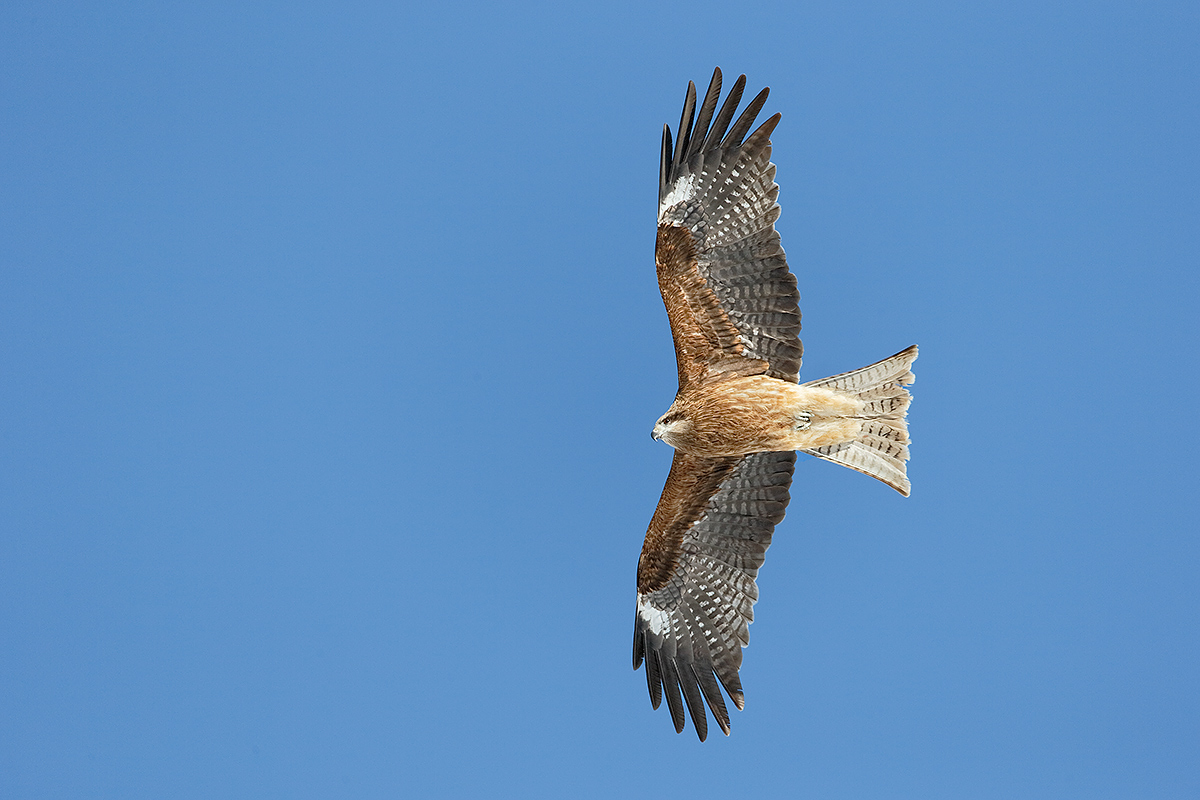
|
|
This Black-eared Kite flight image was also created on the Japan in Winter IPT with the Canon EF 200-400mm f/4L IS USM Lens with Internal 1.4x Extender (hand held with the internal extender in place at 560mm) and the Canon EOS-1D X. ISO 400. Evaluative metering at zero: 1/2000 sec. at f/6.3 in Manual mode was yet another underexposure. AWB.
Central Sensor/AI Servo-Surround/Rear Focus AF just caught the bird’s bill and was active at the moment of exposure. Click here to see the latest version of the Rear Focus Tutorial. Click on the image to see a larger version.
Image #3: Black-eared Kit
|
Ah So….
Tobu Tori means “flying birds” in Japanese.
The 600 II and the 1.4X III TC
Once I saw that all of the feeding action was over I noted that despite the poor wind conditions for flight: wind against sun, that some of the cranes were leaving to our right with the beautiful distant trees as a backdrop. The birds were at quite a distance away so I reached for my 600II/1.4X III/1D X combo and went to work.
You Favorite
Take a moment to leave a comment and let us know which of the four images was your favorite, and why.

|
|
If you’d like to learn from the two folks who created the images in the composite above do consider one of the trips below. Denise Ippolito’s images: Japanese leaf painting, skimmer in flight, curved Keukenhof paths with tulips, copulating terns, & pink dahlia. Artie’s images: Snow Geese snowstorm blur, crane landing silhouettes, Leopard with prey in tree, King Penguin, & vertical tulip. Note: Denise alone will be leading the Torres del Paine workshop.
|
A Creative Adventure/BIRDS AS ART Instructional Photo-Tours (IPTs)/Two great leaders: Arthur Morris & Denise Ippolito.
Arthur Morris/BIRDS AS ART www.BIRDSASART-blog.com for the latest images, info, & education
Denise Ippolito/A Creative Adventure www.deniseippolito.com: get yourself out of the box!
Denise’s e-books: Bloomin’ Ideas, A Guide to Filters & Effects, The Softer Side of Macro, & more. Free Monthly Creative MiniMag: www.deniseippolito.com/magazine
Nickerson Baby Beach-nesting Birds IPT, Long Island, NY: 3-Full Days/July 22-24, 2014: $1199.
Black Skimmers, Common Terns with chicks, American Oystercatcher & Piping Plover families; breeding behaviors including courtship feeding, display flight and combat, and copulations. Gulls and shorebirds.
UK Puffins IPT. Early July, 2014.
Details TBA. Please e-mail to be placed on the interested list.
Tanzania Serengeti Summer Safari: Leave US: August 9—return: August 24, 2014: $12,999.
Co-leaders: Arthur Morris & Todd Gustafson. Wildebeest/The Great Migration, cats, elephant, giraffe, zebra, birds & more. Please e-mail for brochure.
Swan Island Dahlia Farm IPT, Canby, OR, September 8-12, 2014: 5 FULL DAYS: $1699.
Leader: Denise Ippolito. 40 acres with 350+dazzling varieties of dahlias in a plethora of colors, shapes and sizes. Sharpen your technical skills and boost your creative juices. Daily assignments, image sharing, and Photoshop sessions.
Bosque del Apache 2014 A Creative Adventure/BIRDS AS ART “Creative Photography Instructional Photo-Tour.” (IPT). NOV 24-25, 2014. 2-FULL DAYS: $729.
Leaders: Denise Ippolito & Arthur Morris. Introductory Slide program: 7:00pm on Sunday 11/23. This IPT is perfect for folks who want to learn to think outside the box, to create new and different images. Learn to unleash your creative juices at the wondrous Bosque del Apache, NWR in San Antonio, NM.
Bosque del Apache 2014 BIRDS AS ART/A Creative Adventure Instructional Photo-Tour (IPT). NOV 29-DEC 3, 2014. Totaling 4 FULL-DAYS: $1449
Leaders: Arthur Morris and Denise Ippolito. Introductory Slide program: 7:00pm on Sunday 11/29. Tens of thousand of Snow Geese, 10,000 Sandhill Cranes, ducks, amazing sunrises, sunsets, and blast-offs. Live, eat, and breathe photography with two of the world’s premier photographic educators at one of their very favorite photography locations on the planet.
Antarctica/The Extended Expedition Voyage: Antarctic Peninsula, South Georgia and Falkland Islands: December 13, 2014 to January 10, 2015.
Please e-mail for details.
BAA offers a wide range of books, e-Guides, and educational materials and photographic accessories at the lowest prices around—25+ years of experience, and the best advice you can get. We will not sell you junk. Access the BAA Store here or call us at 1-863-692-0906.
Questions? Please e-mail us at birdsasart@verizon.net or photographybydenise221@gmail.com.
Support the BAA Blog. Support the BAA Bulletins: Shop B&H here!
We want and need to keep providing you with the latest free information, photography and Photoshop lessons, and all manner of related information. Show your appreciation by making your purchases immediately after clicking on any of our B&H or Amazon Affiliate links in this blog post. Remember, B&H ain’t just photography!


 


Amazon
Everyone buys something from Amazon, be it a big lens or deodorant. Support the blog by starting your search by clicking on the logo-link below. No purchase is too small to be appreciated; they all add up. Why make it a habit? Because I make it a habit of bringing you new images and information on an almost daily basis.
Typos
In all blog posts and Bulletins, feel free to e-mail or to leave a comment regarding any typos, wrong words, misspellings, omissions, or grammatical errors. Just be right. 🙂
IPT Info
Many of our great trips are filling up. See especially info on the Holland, Nickerson Beach, and Bosque IPTs. Two great leaders on most trips ensure that you will receive individual attention, have all of your questions answered, and learn a ton including how to think like a pro, see the situation, and get the right exposure every time. In addition you will have fun, and make lots of great images. Click here for IPT details and general information.
February 13th, 2014 The Streak Goes On…
After getting in bed at 8:20pm and falling asleep instantly, I woke on Thursday at 2:20am, 1 hour 40 minutes before alarm was set to go off. I spoke at length to Peter Kes in Switzerland on Skype and then finished packing. Denise and I met the group in the lobby at 5:15am, took the bus to Haneda Airport, and flew to Hokkaido. By 2pm we were at the Akan Crane Center photographing Red-crowned Crane, White-tailed and Steller’s Sea Eagle, and Black-eared Kite. The Winter in Japan IPT got off to a great start.
This post marks 76 straight days with a new educational blog post, a record by far that should be extended for at least another day or so, or not. Or more…. It appears that our lodge has great internet. To show your appreciation for my efforts here, we ask that use our B&H and Amazon affiliate links for all of your B&H and Amazon purchases. Please check the availability of all photographic accessories in the BIRDS AS ART Online Store. We sell only what I use and depend on. We will not sell you junk. We know what you need to make creating great images easy and fun. And we are always glad to answer your gear questions via e-mail.
You can find the following items in the store: Gitzo tripods, Mongoose M3.6 and Wimberley heads, plates, low feet, and accessories, flash brackets, , Delkin e-film Pro Compact Flash Cards, LensCoat products, and our unique line-up of educational materials including ABP I & II, Digital Basics, Site and Set-up e-Guides, Canon and Nikon Camera Users and AF e-Guides, and MP-4 Photoshop video tutorials among others.
We would of course appreciate you using our B&H and Amazon affiliate links for all of your B&H and Amazon major gear, video, electronic, household, and personal purchases. For the photographic stuff mentioned in the paragraph above we would of course greatly appreciate your business. Here is a huge thank you to the many who have been using our links on a regular basis and visiting the BAA Online store as well.
Photographing Frantic Action
The great blue grabbed the baby mullet from the bait bucket and was immediately accosted by several pelicans. As he fled to my right I tried to keep the AF sensor on the bird’s face and succeeded to some degree. I pressed the shutter button twice. In the original frame there was some motion blur on the eye so I grabbed the eye from the next frame with a Quick Mask, put on its own layer, brought the layer into the properly framed image (that second image was horribly mis-framed with the end of the bill cut off by the frame-edge), and wound up painting away all but the sharper pupil with a Regular Layer mask.
Here is the main lesson: when photographing frantic or unexpected action, push the shutter button now and ask questions later. If you try in situations that are difficult or near impossible for AF, you might wind up with something worth keeping. If you do not try, you wind up with nothing (but only 100% of the time….) If you are not making some really bad, out-of-focus, mis-framed images then you are not gambling enough and not pushing yourself or the camera’s AF system to the limit.
Image Question
In view of the fact that a faster shutter speed would have been a better choice as I would have had a better chance of freezing the action, why was I at 1/800 sec. at f/10 rather than 1/2000 sec. at f/6.3? (I think that my math is correct…..)
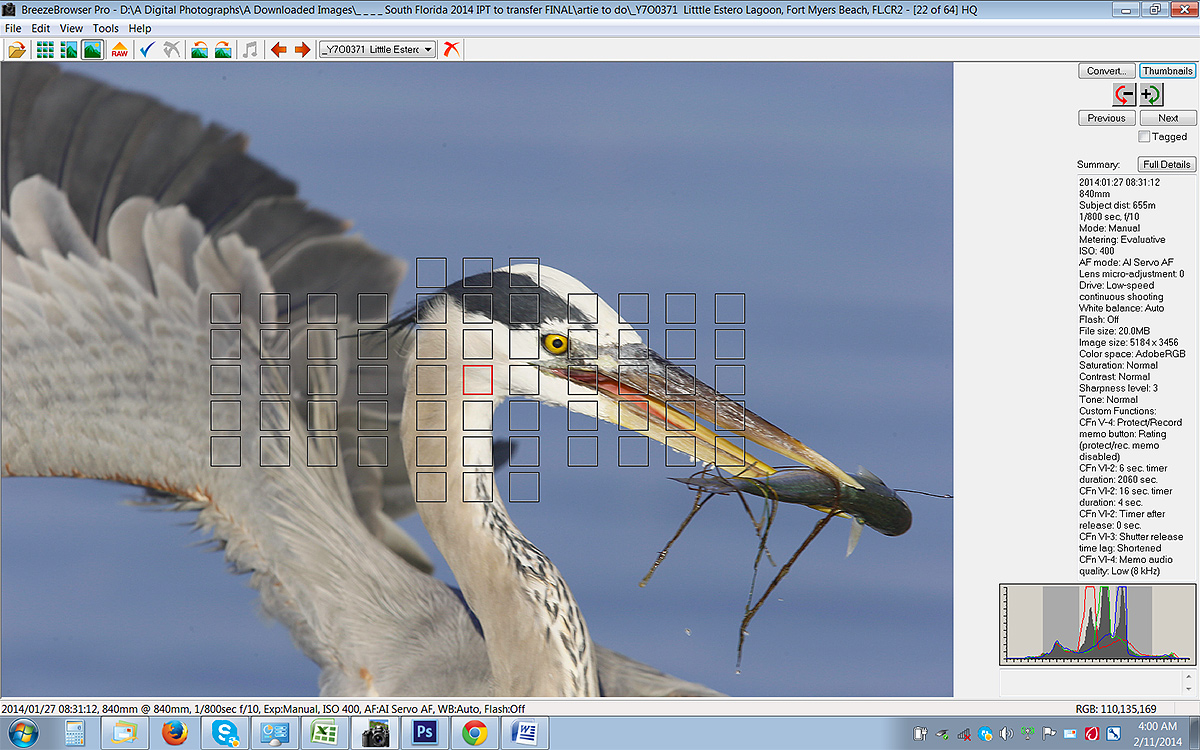
|
|
This is the Breezebrowser Main View screen capture for today’s image.
|
The Breezebrowser Main View Screen Capture
Above is the BreezeBrowser Main View screen capture for today’s image. Note that the illuminated red square (on the bird’s neck) shows the AF point that was active at the moment of exposure.
Note: in Breezebrowser you need to check “Show Focus Points” under View to activate this feature. To see the focus points in DPP check “AF Point” under View or hit Alt L. Hit Alt M to see Highlight Alert. To learn how and why I use DPP (Canon Digital Photo Professional) to convert my RAW files, see the info on our DPP RAW Conversion Guide here.
Note the perfect histogram the WHITEs creeping into the rightmost histogram box. Regular readers know that I use and depend on BreezeBrowser every day of the year. It allows me to sort my keepers and delete the rejects faster than any other Windows browsing program. We use it on the main computer in the home office to catalog our images file-drawer style. And the companion program, Downloader Pro allows me to download my images quickly and conveniently. It automatically adds my IPTC data and the shooting location. I have it set up to create a folder named by the Month/date/year. The Breezebrowser/Downloader Pro combo saves me many hours each week. To learn more or to purchase this great PC only program, click here. As far as the BreezeBrowser/Downloader Pro Combo goes, if you are using a Windows platform and are not using these two great programs you are at best, wasting your valuable time. My understanding is that Photo Mechanic is best for Mac-users who do not opt to run Parallels or VM Ware fusion on their Macs so that they can enjoy the many advantages of BreezeBrowser. See BreezeBrowswer on a Mac for details.
Image Question
Aside from the rapidly moving subject, why is it remarkable that the AF system was able to keep up with the focus at all?
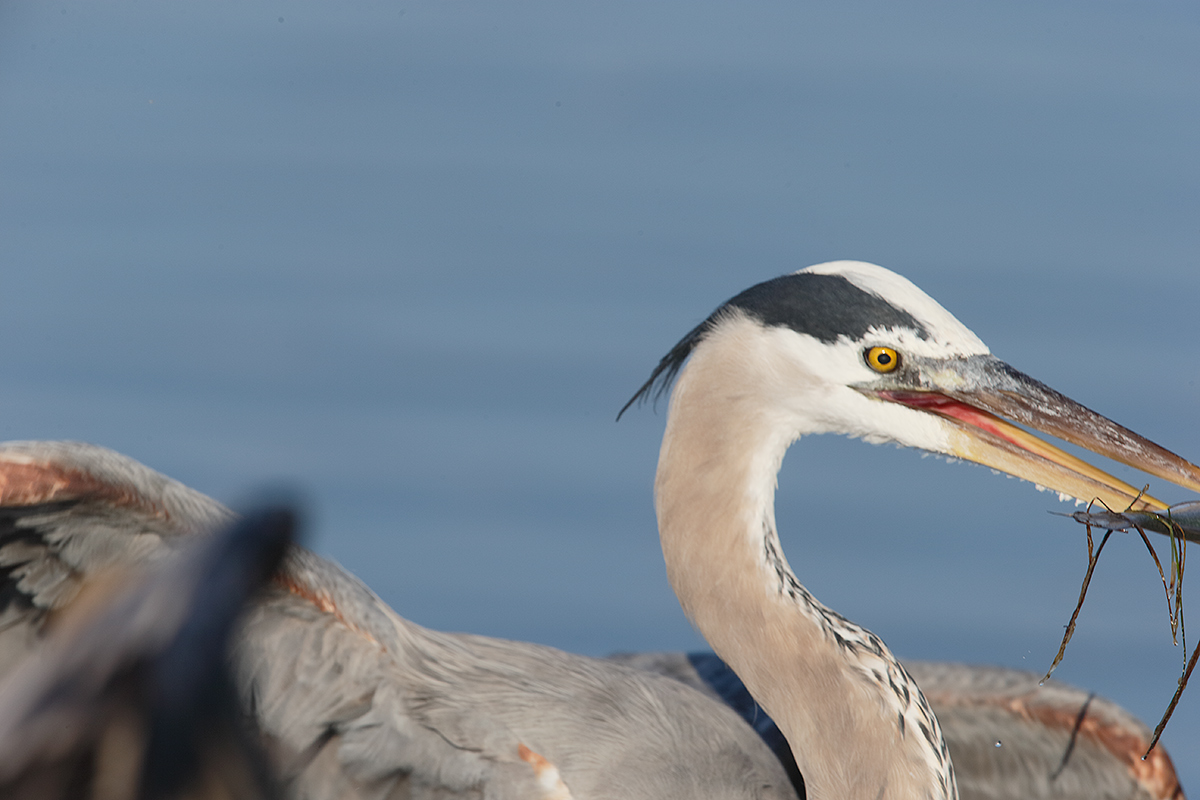
|
|
This is the mis-framed image.
|
The The Mis-framed Image
This is the mis-framed second image from the two-frame sequence; as described above, I used the pupil from this one to replace the motion-blurred pupil in the image that opened this blog post. Note that when editing our images we need to learn to think digitally, to be open to keeping images that might serve as source material for a variety of purpose, images that would surely have been insta-trashes in the days of film.

|
|
Images copyright 2012: Denise Ippoltio & Arthur Morris. Card design by Denise Ippolito. Click on the image to enjoy a spectacular larger version.
|
Holland 2014 7 1/2-Day/8-Night: A Creative Adventure/BIRDS AS ART/Tulips & A Touch of Holland IPT. April 17-April 24, 2014: $4995 Limit: 12/Openings: 5
Act soon: this trip is a go and is filling quickly.
Join Denise Ippolito, Flower Queen and the author of “Bloomin’ Ideas,” and Arthur Morris, Canon Explorer of Light Emeritus and one of the planet’s premier photographic educators for a great trip to Holland in mid-April 2014. Day 1 of the IPT will be April 17, 2014. We will have a short afternoon get-together and then our first photographic session at the justly-famed Keukenhof. Most days we will return to the hotel for lunch, image sharing and a break. On Day 8, April 24, we will enjoy both morning and afternoon photography sessions.
The primary subjects will be tulips and orchids at Keukenhof and the spectacularly amazing tulip, hyacinth, and daffodil bulb fields around Lisse. In addition we will spend one full day in Amsterdam. There will be optional visits the Van Gogh Museum in the morning and the Anne Frank House in the afternoon; there will be plenty of time for street photography as well. And some great food. On another day we will have a wonderful early dinner at Kinderdijk and then head out with our gear to photograph the windmills and possibly some birds for those who bring their longs lenses. We will spend an afternoon in the lovely Dutch town of Edam where we will do some street photography and enjoy a superb dinner. All lodging, ground transportation, entry fees, and meals (from dinner on Day 1 through dinner on Day 7) are included. For those who will be bringing a big lens we will likely have an optional bird photography afternoon or two.
Click here for additional info or to register.

|
|
Join me for the 2014 Tanzania Summer Safari!
|
2014 Tanzania Summer Safari, 14-day African Adventure/leave the US on August 9. Fly home on August 24: $12,999.
Co-leaders Todd Gustafson & Arthur Morris. The limit is 12. Three photographers/van; you get your own row of seats. Our trip is a bit more expensive than the average safari for good reason. It is the best. We have the best driver guides with a total of decades of experience. They have been trained over the years by Todd and by me to drive with photography in mind. We have the best and most knowledgeable leaders. We stay in the best lodges and camps. We hope that you will join us for what will be Todd’s 35th African safari, and my 8th.
If you are seriously interested please e-mail me; I will be glad to send you the illustrated PDF with the complete itinerary and deposit info.
What else makes this expedition unique?
•Pre-trip consultation and camera equipment advice
•Award-winning photographers as your guides
•A seamless itinerary visiting the right locations at the best time of year
•Hands-on photography instruction in the field
•Specially designed three roof-hatch photo safari vehicles
•Proprietary materials for preparation, including free copy of “A Photographer’s Guide to Photographing in East Africa.”
•Post-safari image critiques
All-inclusive (double-occupancy) except for your flights to and from Kilamajaro Airport, bar drinks, soda & water (except at the Intimate Tented Camp where everything is free for our entire stay), tips for drivers and camp staff, personal items, and trip insurance.

|
|
Breathe deeply, bite the bullet, and live life to its fullest; we all get only one ride on the merry-go-round… Join me on this great trip.
Click on the image to enjoy a larger version.
|
The Southern Ocean…
If you would like to explore the possibility of joining me on the Cheesemans’ Ecology Safaris Antarctica/The Extended Expedition Voyage< trip: Antarctic Peninsula, South Georgia and Falkland Islands: December 13, 2014 to January 10, 2015, click here for additional information and then shoot me an e-mail.
The DPP RAW Conversion Guide
To learn why I use Canon’s Digital Photo Professional (DPP) to convert every image that I work on, click here.
Support the BAA Blog. Support the BAA Bulletins: Shop B&H here!
We want and need to keep providing you with the latest free information, photography and Photoshop lessons, and all manner of related information. Show your appreciation by making your purchases immediately after clicking on any of our B&H or Amazon Affiliate links in this blog post. Remember, B&H ain’t just photography!


 


Amazon
Everyone buys something from Amazon, be it a big lens or deodorant. Support the blog by starting your search by clicking on the logo-link below. No purchase is too small to be appreciated; they all add up. Why make it a habit? Because I make it a habit of bringing you new images and information on an almost daily basis.
Typos
In all blog posts and Bulletins, feel free to e-mail or to leave a comment regarding any typos, wrong words, misspellings, omissions, or grammatical errors. Just be right. 🙂
IPT Info
Many of our great trips are filling up. See especially info on the South Florida, Holland, and Nickerson Beach IPTs. Two great leaders on most trips ensure that you will receive individual attention, have all of your questions answered, and learn a ton including how to think like a pro, see the situation, and get the right exposure every time. In addition you will have fun, and make lots of great images. Click here for IPT details and general information.
February 12th, 2014 The Streak Goes On…
The Winter in Japan IPT group leaves the hotel tomorrow at oh-dark-hundred for our flights to Hokkaido; if all goes well, we will be photographing Japanese Red-crowned Cranes tomorrow afternoon. Alan and Pat Lillich and Denise and I spent the morning photographing on the grounds of the Imperial Palace here in Tokyo. We had great fun and enjoyed a great Japanese-style lunch near Tokyo Station. You can see Denise’s favorite image from the morning here. What can I say? The girl is fast. I have not even looked at my images from the palace grounds yet.
This post marks 75 straight days with a new blog post, a record by far that should be extended for at least another day or so, or not. Or more…. I am not sure how good the internet access (if any) will be at our lodge in Hokkaido…..There is a small chance that I may not get to post for several weeks but I sure hope not. To show your appreciation for my efforts here, we ask that use our B&H and Amazon affiliate links for all of your B&H and Amazon purchases. Please check the availability of all photographic accessories in the BIRDS AS ART Online Store. We sell only what I use and depend on. We will not sell you junk. We know what you need to make creating great images easy and fun. And we are always glad to answer your gear questions via e-mail.
You can find the following items in the store: Gitzo tripods, Mongoose M3.6 and Wimberley heads, plates, low feet, and accessories, flash brackets, , Delkin e-film Pro Compact Flash Cards, LensCoat products, and our unique line-up of educational materials including ABP I & II, Digital Basics, Site and Set-up e-Guides, Canon and Nikon Camera Users and AF e-Guides, and MP-4 Photoshop video tutorials among others.
We would of course appreciate you using our B&H and Amazon affiliate links for all of your B&H and Amazon major gear, video, electronic, household, and personal purchases. For the photographic stuff mentioned in the paragraph above we would of course greatly appreciate your business. Here is a huge thank you to the many who have been using our links on a regular basis and visiting the BAA Online store as well.
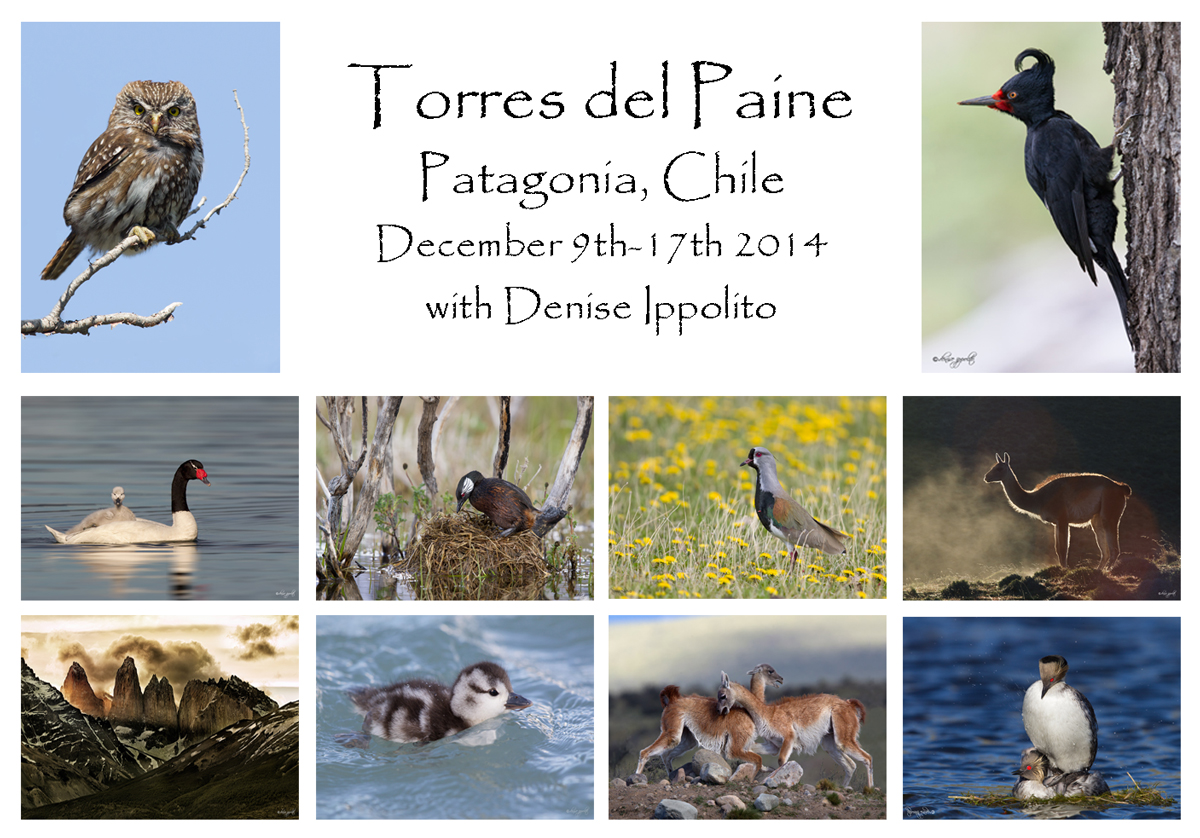
|
|
Image and card design copyright 2103: Denise Ippolito/A Creative Adventure
|
A Rare Photographic Opportunity
Torres del PaineA Creative Adventure Workshop
Join Denise Ippolito for her first ever Torres del Paine workshop. As many of you know, she presented a program to Avistar Patagonia in November of 2013. We spent our days traveling to the famed Torres del Paine National Park in Chile. After the workshop was over Denise joined David Tipling and me for a few days of photography on our own at Torres del Paine. Once David left Denise and I met up with two professional guides and stayed inside the park for a week scouting and photographing on our own. She fell in love with the place and knew immediately that she would return with clients as this place has something for everyone. We will enjoy landscape photography, wildlife photography, bird photography and creative photography.
Participants will fly to the airport in Santiago, Chile (SCL) and take a connecting flight to Punta Arenas (PUQ). There we will be picked up by hotel van; these transfers are included. It is a four hour drive and most hotels do not include this pricey transfer. Once we reach our hotel we will check in and everything will be included: all meals, open bar, bilingual guides, transfers to and from the park, horseback riding if you want- or simply just photographing the horses. Note: your round trip airfare to and from Punta Arenas, Chile is not included in the trip fee. Denise has arranged for a private photo shoot of the horses running with gauchos. Anyone wishing to bring a spouse may; the price for a spouse or companion is the same. There will be other excursions, treks, and activities available as options. The group will photograph together in the mornings and again in the late afternoons (weather permitting). Free time can be enjoyed relaxing at the award-winning hotel, taking advantage of some of the amazingly plush amenities, downloading and reviewing images. or participating in small group image critique or Photoshop sessions with Denise.
Her goal is to help you create the best images at every stop of the journey. This will be an adventurous photography tour and Denise will be there to help you with your camera settings, lens selection, creative techniques and much more. December is the month that the Guanacos have their young; this may attract the Pumas into photographic range. We will hope to see Puma but our trip will not be based on that quest. December is one of the best times to visit the park for wildlife.
Torres del Paine/A Creative Adventure Photographic Workshop: December 9th- 17th. 2014: $6120 USD double occupancy.
This trip needs a minimum of 12 people to run; you will need to wait until you hear from Denise before booking your flights. Travel insurance with TSI is recommended. Click here for more information or to register. Please let Denise know that BIRDS AS ART sent you. 🙂
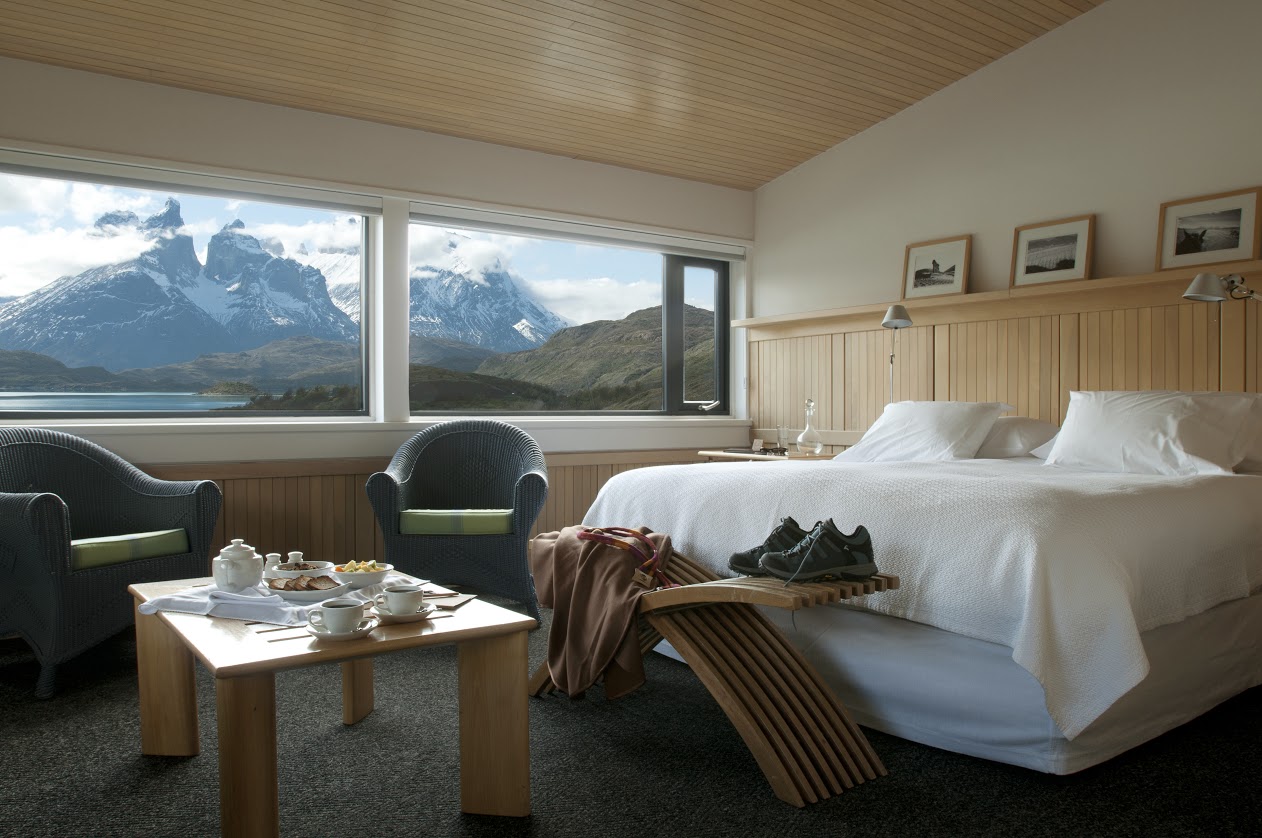
|
|
Image courtesy of and copyright Explora Patagonia.
|
The lodge/hotel, Explora Patagonia/Hotel Salto Chico). is the only hotel located in the heart of the extraordinary Torres del Paine National Park in central Patagonia. It is on the banks of the Salto Chico waterfall where we will have excellent view of the unique Paine Massif and two of the three impressive torres, or towers, that give the park its name. Situated on a 7.4-acre site, Explora Patagonia has 49 comfortable rooms, all with captivating views. The sophisticated design incorporates native lenga wood and cypress brought from the Guaitecas Archipelago, while the floor is made of almond wood. Each room has a small living area, hydromassage bath, and beds designed for deep, pleasurable sleep after a day of exploration.
|
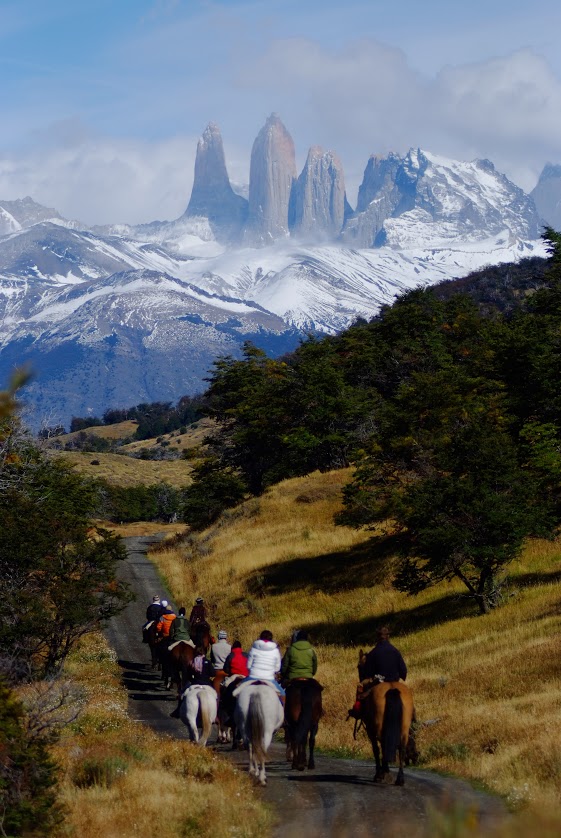
|
|
Image courtesy of and copyright Explora Patagonia.
|
The hotel is the only lodge in the area with its own horses, horses that have been bred and trained especially to be ridden by gringos. Denise loves being outdoors experiencing nature in its rawest form, however, a clean, comfortable bed in a luxurious hotel with gourmet food is a nice way to end the day! The coffee is great! Denise does not know if that matters to you but it matters to her 🙂

|
|
If you’d like to learn from the two folks who created the images in the composite above do consider one of the trips below. Denise Ippolito’s images: Japanese leaf painting, skimmer in flight, curved Keukenhof paths with tulips, copulating terns, & pink dahlia. Artie’s images: Snow Geese snowstorm blur, crane landing silhouettes, Leopard with prey in tree, King Penguin, & vertical tulip. Note: Denise alone will be leading the Torres del Paine workshop.
|
A Creative Adventure/BIRDS AS ART Instructional Photo-Tours (IPTs)/Two great leaders: Arthur Morris & Denise Ippolito.
Arthur Morris/BIRDS AS ART www.BIRDSASART-blog.com for the latest images, info, & education
Denise Ippolito/A Creative Adventure www.deniseippolito.com: get yourself out of the box!
Denise’s e-books: Bloomin’ Ideas, A Guide to Filters & Effects, The Softer Side of Macro, & more. Free Monthly Creative MiniMag: www.deniseippolito.com/magazine
Nickerson Baby Beach-nesting Birds IPT, Long Island, NY: 3-Full Days/July 22-24, 2014: $1199.
Black Skimmers, Common Terns with chicks, American Oystercatcher & Piping Plover families; breeding behaviors including courtship feeding, display flight and combat, and copulations. Gulls and shorebirds.
UK Puffins IPT. Early July, 2014.
Details TBA. Please e-mail to be placed on the interested list.
Tanzania Serengeti Summer Safari: Leave US: August 9—return: August 24, 2014: $12,999.
Co-leaders: Arthur Morris & Todd Gustafson. Wildebeest/The Great Migration, cats, elephant, giraffe, zebra, birds & more. Please e-mail for brochure.
Swan Island Dahlia Farm IPT, Canby, OR, September 8-12, 2014: 5 FULL DAYS: $1699.
Leader: Denise Ippolito. 40 acres with 350+dazzling varieties of dahlias in a plethora of colors, shapes and sizes. Sharpen your technical skills and boost your creative juices. Daily assignments, image sharing, and Photoshop sessions.
Bosque del Apache 2014 A Creative Adventure/BIRDS AS ART “Creative Photography Instructional Photo-Tour.” (IPT). NOV 24-25, 2014. 2-FULL DAYS: $729.
Leaders: Denise Ippolito & Arthur Morris. Introductory Slide program: 7:00pm on Sunday 11/23. This IPT is perfect for folks who want to learn to think outside the box, to create new and different images. Learn to unleash your creative juices at the wondrous Bosque del Apache, NWR in San Antonio, NM.
Bosque del Apache 2014 BIRDS AS ART/A Creative Adventure Instructional Photo-Tour (IPT). NOV 29-DEC 3, 2014. Totaling 4 FULL-DAYS: $1449
Leaders: Arthur Morris and Denise Ippolito. Introductory Slide program: 7:00pm on Sunday 11/29. Tens of thousand of Snow Geese, 10,000 Sandhill Cranes, ducks, amazing sunrises, sunsets, and blast-offs. Live, eat, and breathe photography with two of the world’s premier photographic educators at one of their very favorite photography locations on the planet.
Antarctica/The Extended Expedition Voyage: Antarctic Peninsula, South Georgia and Falkland Islands: December 13, 2014 to January 10, 2015.
Please e-mail for details.
BAA offers a wide range of books, e-Guides, and educational materials and photographic accessories at the lowest prices around—25+ years of experience, and the best advice you can get. We will not sell you junk. Access the BAA Store here or call us at 1-863-692-0906.
Questions? Please e-mail us at birdsasart@verizon.net or photographybydenise221@gmail.com.
Support the BAA Blog. Support the BAA Bulletins: Shop B&H here!
We want and need to keep providing you with the latest free information, photography and Photoshop lessons, and all manner of related information. Show your appreciation by making your purchases immediately after clicking on any of our B&H or Amazon Affiliate links in this blog post. Remember, B&H ain’t just photography!


 


Amazon
Everyone buys something from Amazon, be it a big lens or deodorant. Support the blog by starting your search by clicking on the logo-link below. No purchase is too small to be appreciated; they all add up. Why make it a habit? Because I make it a habit of bringing you new images and information on an almost daily basis.
Typos
In all blog posts and Bulletins, feel free to e-mail or to leave a comment regarding any typos, wrong words, misspellings, omissions, or grammatical errors. Just be right. 🙂
IPT Info
Many of our great trips are filling up. See especially info on the Holland, Nickerson Beach, and Bosque IPTs. Two great leaders on most trips ensure that you will receive individual attention, have all of your questions answered, and learn a ton including how to think like a pro, see the situation, and get the right exposure every time. In addition you will have fun, and make lots of great images. Click here for IPT details and general information.
February 10th, 2014 The Streak Goes On…
I am posting this at 7:27pm Tokyo time (which is 5:27am Florida time) from the Narita Airport as we wait for the bus. My flight was great. Denise and Alan and Pat Lillich kindly waited for me for almost five hours. God bless them all!
This post marks 75 straight days with a new educational blog post, a record by far that should be extended for at least another day or so, or not. Or more…. I am not sure how good the internet access (if any) will be in Japan. To show your appreciation for my efforts here, we ask that use our B&H and Amazon affiliate links for all of your B&H and Amazon purchases. Please check the availability of all photographic accessories in the BIRDS AS ART Online Store. We sell only what I use and depend on. We will not sell you junk. We know what you need to make creating great images easy and fun. And we are always glad to answer your gear questions via e-mail.
You can find the following items in the store: Gitzo tripods, Mongoose M3.6 and Wimberley heads, plates, low feet, and accessories, flash brackets, , Delkin e-film Pro Compact Flash Cards, LensCoat products, and our unique line-up of educational materials including ABP I & II, Digital Basics, Site and Set-up e-Guides, Canon and Nikon Camera Users and AF e-Guides, and MP-4 Photoshop video tutorials among others.
We would of course appreciate you using our B&H and Amazon affiliate links for all of your B&H and Amazon major gear, video, electronic, household, and personal purchases. For the photographic stuff mentioned in the paragraph above we would of course greatly appreciate your business. Here is a huge thank you to the many who have been using our links on a regular basis and visiting the BAA Onliine store as well.
Thanks and enjoy today’s blog post!
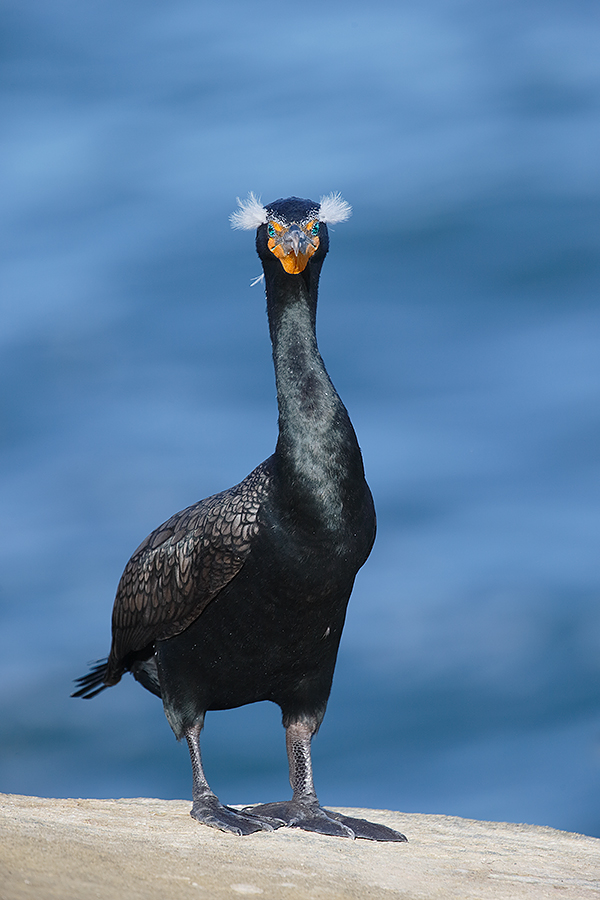
|
|
This Double-crested Cormorant image was created on the San Diego Short Notice IPT with the Canon EF 200-400mm f/4L IS USM Lens with Internal 1.4x Extender (hand held with the internal extender in place at 560mm) and the Canon EOS-1D X. ISO 400. Evaluative metering +1/3 stop: 1/1000 sec. at f/6.3 in Manual mode. White Balance = K 7500.
Four sensors up from the Central Sensor/AI Servo-Rear Focus AF on the bird’s chin active at the moment of exposure. Click here to see the latest version of the Rear Focus Tutorial. Click on the image to see a larger version.
Image #1: Clarabell the Clown
|
The 600 f/4L IS II & the 200-400 f/4L IS II with Internal Extender Combo
Though difficult to travel with, the 600 II with both TCs available and the 200-400 with Internal extender is a great combination for birds and wildlife, giving folks a focal length range of from 200-1200mm.
Orientation-linked AF Points
If you own a 1D X or a 5D III and you do not have your camera set up for Orientation-linked AF Points you are really hurting yourself. The camera senses whether you are working in horizontal or vertical format and uses the AF Selection Area and the last selected points for each. You can probably figure things out by consulting the camera manual but in the two User’s Guides below I share the details of set-up, explore the various options, and let you know how I have my cameras set up to enable me to get the shot quickly without having to fiddle around.
EOS-1D X Autofocus Guide
Learn the ins and out of the great AF system of the 1D X. Of special interest to bird photographers will be my comments and strategies involving Cases 1-6, the custom-Case that I created and use for most of my bird photography (with detailed instructions for setting it up of course), my strategy for Select AF area selection mode (on AF4, the fourth purple menu), and pretty much anything that has to do with 1D X autofocus….Get your PDF via e-mail here for only $25. Setting up and using Orientation-linked AF Points is of course covered in detail.
5D Mark III User’s Guide
5D III folks can learn everything that I know about 5D III exposure fine points, the top LCD and all camera control buttons, the 5D Mark III drive modes, how to manually select an AF sensor, choosing an AF Area Selection Mode; how and why (includes extensive detail), Menu Item Access, coverage of almost all Menu Items and Custom Functions including the following: Image Quality, Auto Lighting Optimizer, Highlight Tone Priority, AF Configuration Tool (includes details on the custom setting that I use), Acceleration/deceleration tracking, Tracking sensitivity, Lens drive when AF impossible, Orientation-linked AF point (I love this feature on the 5D III!), Highlight alert, Histogram display, Auto rotate, Custom Shooting Mode set-up, Safety shift, using the Q button, and setting up rear focus. The guide is–of course–written in my informal, easy-to-follow style.
You can learn more about the 5D Mark III User’s Guide or have the PDF sent to you by clicking here.
Snazzy
Breeding plumage Double-crested Cormorant in full breeding plumage is indeed a snazzy bird. Both eastern and western birds feature the neat crests. Eastern birds have black crests that are not as snazzy as the fluffy white crests of their western counterparts. But the color of the inside of the mouth of the eastern birds in full breeding plumage gets to be a much brighter cobalt blue than the mouth linings of the western birds. I just saw some image of western birds photographed last week in LaJolla by IPT veteran Donna Bourdon with the mouth lining as bright as I have seen on the eastern birds at Anhinga Trail. Donna was extolling the virtues of the San Diego Site Guide.
Donna wrote: Hi Artie. Just wanted to let you know how much I enjoyed your e-book on photographing the pelicans in San Diego. I just returned and got some great shots. Your directions to the cliffs were perfect. We saw pelicans, two Peregrine Falcons, lots of cormorants, and lots of Harbor Seals and California Sea Lions. I appreciate all the instruction I have received from you through your visit to Chattanooga and your sharing of knowledge in your e-books. Attached are a few examples. Donna.
She send some very nice images including a killer shot of a peregrine taking flight.
On the San Diego Short Notice IPT (likely to be repeated next January) both species of cormorants (double-crested and Brandt’s) were several weeks ahead of an average year in terms of breeding plumage and soft parts coloration. We had great fun photographing both species. I will be sharing more cormorant images and education with you here in the not too distant future.
Questions
Which of the two images do you like best and why?
Why f/6.3 for the opening image and f/14 for the head portrait? I think that many of you are getting this concept :).

|
|
Images copyright 2012: Denise Ippoltio & Arthur Morris. Card design by Denise Ippolito. Click on the image to enjoy a spectacular larger version.
|
Holland 2014 7 1/2-Day/8-Night: A Creative Adventure/BIRDS AS ART/Tulips & A Touch of Holland IPT. April 17-April 24, 2014: $4995 Limit: 12/Openings: 5
Act soon: this trip is a go and is filling quickly.
Join Denise Ippolito, Flower Queen and the author of “Bloomin’ Ideas,” and Arthur Morris, Canon Explorer of Light Emeritus and one of the planet’s premier photographic educators for a great trip to Holland in mid-April 2014. Day 1 of the IPT will be April 17, 2014. We will have a short afternoon get-together and then our first photographic session at the justly-famed Keukenhof. Most days we will return to the hotel for lunch, image sharing and a break. On Day 8, April 24, we will enjoy both morning and afternoon photography sessions.
The primary subjects will be tulips and orchids at Keukenhof and the spectacularly amazing tulip, hyacinth, and daffodil bulb fields around Lisse. In addition we will spend one full day in Amsterdam. There will be optional visits the Van Gogh Museum in the morning and the Anne Frank House in the afternoon; there will be plenty of time for street photography as well. And some great food. On another day we will have a wonderful early dinner at Kinderdijk and then head out with our gear to photograph the windmills and possibly some birds for those who bring their longs lenses. We will spend an afternoon in the lovely Dutch town of Edam where we will do some street photography and enjoy a superb dinner. All lodging, ground transportation, entry fees, and meals (from dinner on Day 1 through dinner on Day 7) are included. For those who will be bringing a big lens we will likely have an optional bird photography afternoon or two.
Click here for additional info or to register.

|
|
Join me for the 2014 Tanzania Summer Safari!
|
2014 Tanzania Summer Safari, 14-day African Adventure/leave the US on August 9. Fly home on August 24: $12,999.
Co-leaders Todd Gustafson & Arthur Morris. The limit is 12. Three photographers/van; you get your own row of seats. Our trip is a bit more expensive than the average safari for good reason. It is the best. We have the best driver guides with a total of decades of experience. They have been trained over the years by Todd and by me to drive with photography in mind. We have the best and most knowledgeable leaders. We stay in the best lodges and camps. We hope that you will join us for what will be Todd’s 35th African safari, and my 8th.
If you are seriously interested please e-mail me; I will be glad to send you the illustrated PDF with the complete itinerary and deposit info.
What else makes this expedition unique?
•Pre-trip consultation and camera equipment advice
•Award-winning photographers as your guides
•A seamless itinerary visiting the right locations at the best time of year
•Hands-on photography instruction in the field
•Specially designed three roof-hatch photo safari vehicles
•Proprietary materials for preparation, including free copy of “A Photographer’s Guide to Photographing in East Africa.”
•Post-safari image critiques
All-inclusive (double-occupancy) except for your flights to and from Kilamajaro Airport, bar drinks, soda & water (except at the Intimate Tented Camp where everything is free for our entire stay), tips for drivers and camp staff, personal items, and trip insurance.

|
|
Breathe deeply, bite the bullet, and live life to its fullest; we all get only one ride on the merry-go-round… Join me on this great trip.
Click on the image to enjoy a larger version.
|
The Southern Ocean…
If you would like to explore the possibility of joining me on the Cheesemans’ Ecology Safaris Antarctica/The Extended Expedition Voyage< trip: Antarctic Peninsula, South Georgia and Falkland Islands: December 13, 2014 to January 10, 2015, click here for additional information and then shoot me an e-mail.
The DPP RAW Conversion Guide
To learn why I use Canon’s Digital Photo Professional (DPP) to convert every image that I work on, click here.
Support the BAA Blog. Support the BAA Bulletins: Shop B&H here!
We want and need to keep providing you with the latest free information, photography and Photoshop lessons, and all manner of related information. Show your appreciation by making your purchases immediately after clicking on any of our B&H or Amazon Affiliate links in this blog post. Remember, B&H ain’t just photography!


 


Amazon
Everyone buys something from Amazon, be it a big lens or deodorant. Support the blog by starting your search by clicking on the logo-link below. No purchase is too small to be appreciated; they all add up. Why make it a habit? Because I make it a habit of bringing you new images and information on an almost daily basis.
Typos
In all blog posts and Bulletins, feel free to e-mail or to leave a comment regarding any typos, wrong words, misspellings, omissions, or grammatical errors. Just be right. 🙂
IPT Info
Many of our great trips are filling up. See especially info on the South Florida, Holland, and Nickerson Beach IPTs. Two great leaders on most trips ensure that you will receive individual attention, have all of your questions answered, and learn a ton including how to think like a pro, see the situation, and get the right exposure every time. In addition you will have fun, and make lots of great images. Click here for IPT details and general information.
February 10th, 2014 The Streak Goes On…
I am feeling pretty good as I wait at the gate for my flight to DFW continuing on to Tokyo, arriving at 4:15pm on Tuesday if I make my conncetion 🙂 Denise Ippolito and Paul McKenzie are leading the Winter in Japan IPT with me.
This post marks 75 straight days with a new educational blog post, a record by far that should be extended for at least another day or so, or not. Or more…. I am not sure how good the internet access (if any) will be in Japan. To show your appreciation for my efforts here, we ask that use our B&H and Amazon affiliate links for all of your B&H and Amazon purchases. Please check the availability of all photographic accessories in the BIRDS AS ART Online Store. We sell only what I use and depend on. We will not sell you junk. We know what you need to make creating great images easy and fun. And we are always glad to answer your gear questions via e-mail.
You can find the following items in the store: Gitzo tripods, Mongoose M3.6 and Wimberley heads, plates, low feet, and accessories, flash brackets, , Delkin e-film Pro Compact Flash Cards, LensCoat products, and our unique line-up of educational materials including ABP I & II, Digital Basics, Site and Set-up e-Guides, Canon and Nikon Camera Users and AF e-Guides, and MP-4 Photoshop video tutorials among others.
We would of course appreciate you using our B&H and Amazon affiliate links for all of your B&H and Amazon major gear, video, electronic, household, and personal purchases. For the photographic stuff mentioned in the paragraph above we would of course greatly appreciate your business. Here is a huge thank you to the many who have been using our links on a regular basis and visiting the BAA Onliine store as well.
Thanks and enjoy today’s blog post!
|
|
|
This image was created with the tripod-mounted Canon EF 200-400mm f/4L IS USM Lens with Internal 1.4x Extender (with the internal TC in place at 506mm) and the Canon EOS-1D X). ISO 1600. Evaluative metering +2/3 stop as framed: 1/400 sec. at f/5.6 in Manual Mode.
Two sensors above the central sensor/AI Servo-Surround/Rear Focus on the bear’s muzzle below the eyes active at the moment of exposure. Click here if you missed the Rear Focus Tutorial. Click on the image to see a larger version.
|
Why Not Focus On the Subject’s Eye?
Thanks to BAA-Friend and multiple IPT veteran Brent Bridges for asking the question via e-mail when he wrote:
Dear Artie,
I told Denise the blastoff on the Sunday of the Bosque IPT with tens of thousands of birds was surreal. That alone was worth the price of the whole trip. You two had the group in the right place every minute for four straight days. 🙂
I meant to ask you an AF question but forgot. In the past on you BAA site you showed a Yellow-billed Pintail where you had focused on the upper breast just above the waterline; with a Magellanic Oystercatcher you focused one inch behind the eye; to create a White-rumped Sandpiper image you focused on the side of the bird’s breast; and for a coastal Brown Bear photo you focuses on the bear’s muzzle below the eyes. I have been trying to put a focusing sensor on the subject’s eye. Can you please tell me the reasons you focused elsewhere?
Thanks, Brent
My Reply
Sometimes it is not possible to get the sensor right on the bird’s eye. With the bird’s head often small in the frame it can be impossible to focus on the eye…. That is especially true when using an f/4 super-telephoto lens and the 2X III TC. In those situations folks are limited to the central sensor only. In all cases, I try to find something that is roughly on the same plane as the subjects eye. Check out each of the images here and I think that you will see that the spot that I chose was either on the same plane as the eye or very close to it. Thanks for your great question and take care Brent. Did I ever tell you that you are a mensch??
Thanks again for joining us and later and love, artie
AF Point Selection With Shorebirds and Ducks
In the image above, with the bird relatively small in the frame, placing the central AF sensor (by necessity with the 2X II TC in place) on the bird’s breast made perfect sense. With shorebirds and ducks that that are much larger in the frame, I most often will place the AF sensor on the bird’s back just this side of the centerline, again, trying to approximate the plane of the bird’s eye. And that goes quadruple when you are limited to the central sensor; with large in the frame subjects and central sensor only AF you will be dead in the water and wind up cutting off parts of the bird…. Even if you managed to fit a smaller subject completely into the frame, the compositional balance would be very poor.
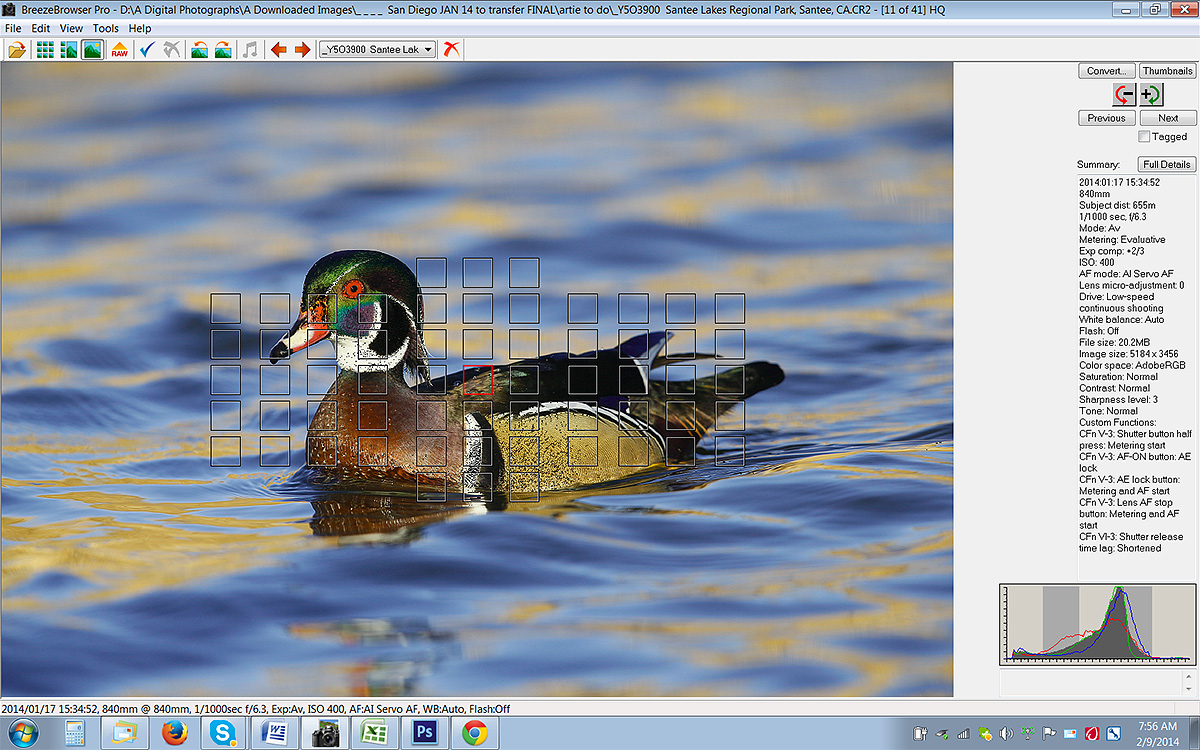
|
|
This is the BreezeBrowser Main View screen capture for the Wood Duck image below.
|
BreezeBrowser Main View Screen Capture
Above is the BreezeBrowser Main View screen capture for the Wood Duck image below. Note that the illuminated red square shows the AF point that was active at the moment of exposure. As mentioned above, I place the active AF sensor on the bird’s back on a spot that I thought would approximate the plane of the duck’s eye….
Note: in Breezebrowser you need to check “Show Focus Points” under View to activate this feature. To see the focus points in DPP check “AF Point” under View or hit Alt L. Hit Alt M to see Highlight Alert. To learn how and why I use DPP (Canon Digital Photo Professional) to convert my RAW files, see the info on our DPP RAW Conversion Guide here.
Note the perfect histogram the WHITEs creeping well into the rightmost histogram box. Regular readers know that I use and depend on BreezeBrowser every day of the year. It allows me to sort my keepers and delete the rejects faster than any other Windows browsing program. We use it on the main computer in the home office to catalog our images file-drawer style. And the companion program, Downloader Pro allows me to download my images quickly and conveniently. It automatically adds my IPTC data and the shooting location. I have it set up to create a folder named by the Month/date/year. The Breezebrowser/Downloader Pro combo saves me many hours each week. To learn more or to purchase this great PC only program, click here. As far as the BreezeBrowser/Downloader Pro Combo goes, if you are using a Windows platform and are not using these two great programs you are at best, wasting your valuable time. My understanding is that Photo Mechanic is best for Mac-users who do not opt to run Parallels or VM Ware fusion on their Macs so that they can enjoy the many advantages of BreezeBrowser. See BreezeBrowswer on a Mac for details.
The Crop
As the bird was too centered in the original frame–see in the BreezeBrowser screen capture above, I cropped from below and from the rear using the 3X2 Rectangular Marquee Tool. I love that you can move the whole crop box around after setting the size. I hope to be doing a CS-6 MP-4 Video Tutorial soon detailing how I have gotten around all the annoying changes in CS-6.
Image Question
In this situation I found it easier to work in Av mode and dial in exposure compensation (EC) as needed working most often at zero or -1/3 stop, the latter if the bird swam through dark green reflections. In this image how did I know in advance that +2/3 would be perfect?
EOS-1D X Autofocus Guide
Learn the ins and out of the great AF system of the 1D X. Of special interest to bird photographers will be my comments and strategies involving Cases 1-6, the custom-Case that I created and use for most of my bird photography (with detailed instructions for setting it up of course), my strategy for Select AF area selection mode (on AF4, the fourth purple menu), and pretty much anything that has to do with 1D X autofocus….Get your PDF via e-mail here for only $25.
5D Mark III User’s Guide
5D III folks can learn all of the above plus tons more including everything that I know about 5D III exposure fine points, the top LCD and all camera control buttons, the 5D Mark III drive modes, how to manually select an AF sensor, choosing an AF Area Selection Mode; how and why (includes extensive detail), Menu Item Access, coverage of almost all Menu Items and Custom Functions including the following: Image Quality, Auto Lighting Optimizer, Highlight Tone Priority, AF Configuration Tool (includes details on the custom setting that I use), Acceleration/deceleration tracking, Tracking sensitivity, Lens drive when AF impossible, Orientation linked AF point (I love this feature on the 5D III!), Highlight alert, Histogram display, Auto rotate, Custom Shooting Mode set-up, Safety shift, using the Q button, and setting up rear focus. The guide is–of course–written in my informal, easy-to-follow style.
You can learn more about the 5D Mark III User’s Guide or have the PDF sent to you by clicking here.

|
|
If you’d like to learn from the two folks who created the images in the composite above do consider one of the trips below. Denise Ippolito’s images: Japanese leaf painting, skimmer in flight, curved Keukenhof paths with tulips, copulating terns, & pink dahlia. Artie’s images: Snow Geese snowstorm blur, crane landing silhouettes, Leopard with prey in tree, King Penguin, & vertical tulip.
|
A Creative Adventure/BIRDS AS ART Instructional Photo-Tours (IPTs)/Two great leaders: Arthur Morris & Denise Ippolito.
Arthur Morris/BIRDS AS ART www.BIRDSASART-blog.com for the latest images, info, & education
Denise Ippolito/A Creative Adventure www.deniseippolito.com: get yourself out of the box!
Denise’s e-books: Bloomin’ Ideas, A Guide to Filters & Effects, The Softer Side of Macro, & more. Free Monthly Creative MiniMag: www.deniseippolito.com/magazine
Nickerson Baby Beach-nesting Birds IPT, Long Island, NY: 3-Full Days/July 22-24, 2014: $1199.
Black Skimmers, Common Terns with chicks, American Oystercatcher & Piping Plover families; breeding behaviors including courtship feeding, display flight and combat, and copulations. Gulls and shorebirds.
UK Puffins IPT. Early July, 2014.
Details TBA. Please e-mail to be placed on the interested list.
Tanzania Serengeti Summer Safari: Leave US: August 9—return: August 24, 2014: $12,999.
Co-leaders: Arthur Morris & Todd Gustafson. Wildebeest/The Great Migration, cats, elephant, giraffe, zebra, birds & more. Please e-mail for brochure.
Swan Island Dahlia Farm IPT, Canby, OR, September 8-12, 2014: 5 FULL DAYS: $1699.
Leader: Denise Ippolito. 40 acres with 350+dazzling varieties of dahlias in a plethora of colors, shapes and sizes. Sharpen your technical skills and boost your creative juices. Daily assignments, image sharing, and Photoshop sessions.
Bosque del Apache 2014 A Creative Adventure/BIRDS AS ART “Creative Photography Instructional Photo-Tour.” (IPT). NOV 24-25, 2014. 2-FULL DAYS: $729.
Leaders: Denise Ippolito & Arthur Morris. Introductory Slide program: 7:00pm on Sunday 11/23. This IPT is perfect for folks who want to learn to think outside the box, to create new and different images. Learn to unleash your creative juices at the wondrous Bosque del Apache, NWR in San Antonio, NM.
Bosque del Apache 2014 BIRDS AS ART/A Creative Adventure Instructional Photo-Tour (IPT). NOV 29-DEC 3, 2014. Totaling 4 FULL-DAYS: $1449
. Leaders: Arthur Morris and Denise Ippolito. Introductory Slide program: 7:00pm on Sunday 11/29. Tens of thousand of Snow Geese, 10,000 Sandhill Cranes, ducks, amazing sunrises, sunsets, and blast-offs. Live, eat, and breathe photography with two of the world’s premier photographic educators at one of their very favorite photography locations on the planet.
Antarctica/The Extended Expedition Voyage: Antarctic Peninsula, South Georgia and Falkland Islands: December 13, 2014 to January 10, 2015.
Please e-mail for details.
BAA offers a wide range of books, e-Guides, and educational materials and photographic accessories at the lowest prices around—25+ years of experience, and the best advice you can get. We will not sell you junk. Access the BAA Store here or call us at 1-863-692-0906.
Questions? Please e-mail us at birdsasart@verizon.net or photographybydenise221@gmail.com.
Support the BAA Blog. Support the BAA Bulletins: Shop B&H here!
We want and need to keep providing you with the latest free information, photography and Photoshop lessons, and all manner of related information. Show your appreciation by making your purchases immediately after clicking on any of our B&H or Amazon Affiliate links in this blog post. Remember, B&H ain’t just photography!


 


Amazon
Everyone buys something from Amazon, be it a big lens or deodorant. Support the blog by starting your search by clicking on the logo-link below. No purchase is too small to be appreciated; they all add up. Why make it a habit? Because I make it a habit of bringing you new images and information on an almost daily basis.
Typos
In all blog posts and Bulletins, feel free to e-mail or to leave a comment regarding any typos, wrong words, misspellings, omissions, or grammatical errors. Just be right. 🙂
IPT Info
Many of our great trips are filling up. See especially info on the Holland, Nickerson Beach, and Bosque IPTs. Two great leaders on most trips ensure that you will receive individual attention, have all of your questions answered, and learn a ton including how to think like a pro, see the situation, and get the right exposure every time. In addition you will have fun, and make lots of great images. Click here for IPT details and general information.
February 9th, 2014 The Streak Goes On…
I continue to feel pretty good, I fly to Japan tomorrow Denise Ippolito and Paul McKenzie will be leading the Winter in Japan IPT with me.
This post marks 74 straight days with a new educational blog post, a record by far that should be extended for at least another day or so, or not. Or more…. I am not sure how good the internet access (if any) will be in Japan. To show your appreciation for my efforts here, we ask that use our B&H and Amazon affiliate links for all of your B&H and Amazon purchases. Please check the availability of all photographic accessories in the BIRDS AS ART Online Store. We sell only what I use and depend on. We will not sell you junk. We know what you need to make creating great images easy and fun. And we are always glad to answer your gear questions via e-mail.
You can find the following items in the store: Gitzo tripods, Mongoose M3.6 and Wimberley heads, plates, low feet, and accessories, flash brackets, , Delkin e-film Pro Compact Flash Cards, LensCoat products, and our unique line-up of educational materials including ABP I & II, Digital Basics, Site and Set-up e-Guides, Canon and Nikon Camera Users and AF e-Guides, and MP-4 Photoshop video tutorials among others.
We would of course appreciate you using our B&H and Amazon affiliate links for all of your B&H and Amazon major gear, video, electronic, household, and personal purchases. For the photographic stuff mentioned in the paragraph above we would of course greatly appreciate your business. Here is a huge thank you to the many who have been using our links on a regular basis and visiting the BAA Onliine store as well.
Thanks and enjoy today’s blog post!
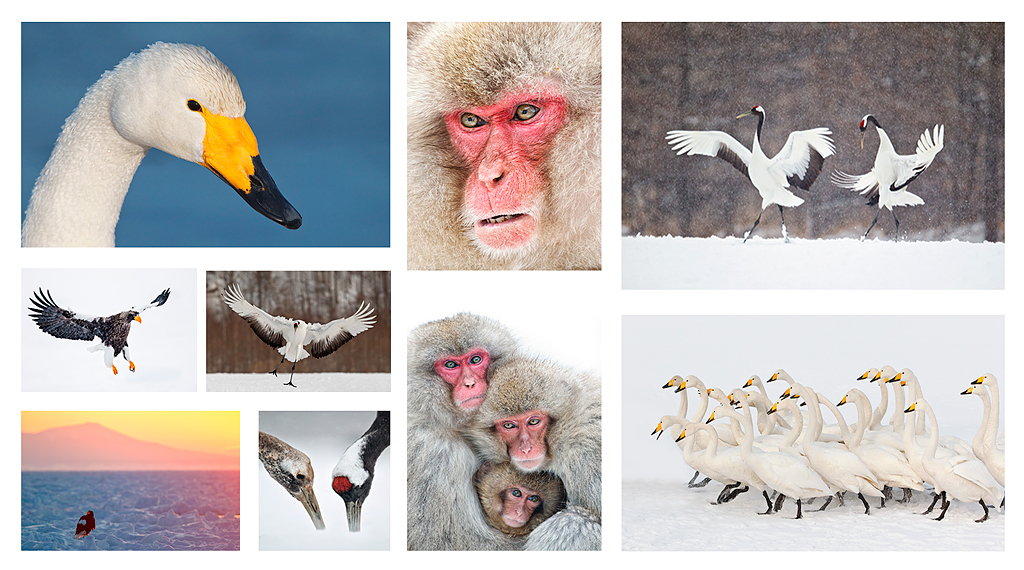
|
|
If you are interested in joining us on a Japan in Winter IPT in February 2016 shoot me an e-mail.
|
Japan in Winter IPT Gear Bag
I head to the Orlando Airport Courtyard Marriott this afternoon, Sunday February 9, 2014, to overhight for my 8:35am flight to Dallas on Monday. I arrive in DFW at 10:30am for my 11:40am flight to Tokyo’s Narita airport arriving at 4:15pm on Tuesday. Yikes. I will be meeting co-leader Denise Ippolito and good friends and multiple IPT veterans Alan and Pat Lillich (say LILL-ick) all of whom arrive ahead of me. From there we take a bus to our Tokyo hotel for a full day of rest on Wednesday. We fly to Hokkaido on Thursday. Double yikes!
Important gear decisions must be made whenever you travel and getting ready for this trip was no exception. All of my gear is packed up in my Think Tank Airport Security Rolling Bag in either my beloved wool watch caps or in various LensCoat LensPouches, LensCoats, and Body Bags. Each of the big lenses is of course protected by a LensCoat to prevent dings on Canon’s pretty, white, heat-reflective finish. Having your lenses protected by a LensCoat will increase the resale value far in excess of the cost of a LensCoat. My favorite pattern is Hardwood Snow.
For the first time in as long as I can remember I will not be traveling with my black, hard-sided plastic Delsey suitcase; that bag has been around the world with me several times over. Why the switch? There will be times in Japan when I need to move all of my stuff at once. With my laptop bag strapped atop the Think Tank Bag and 2 regular rolling bags, that is impossible as I do not have 3 arms…. Denise has been using and loving two Samsonite soft-sided spinners, a 25″ case and a 29″ case. She can pull her roll-aboard camera bag with her laptop bag on it with one arm and maneuver her 2 checked bags with the other. As I routinely travel with a lot more stuff than she does, two 50 pound checked bags to be exact, I went for 2 of these: Samsonite Lift 29″ Spinner Luggage Navy – Exclusive . You position them back to back and stroll on down the concourse with ease. . You position them back to back and stroll on down the concourse with ease.
Think Tank Bags
Spend more than $50 using this link and earn a free small bag of your choice. In addition to a great line-up of rolling bags and accessories Think Tanks also has some great backpacks.
Here’s what’s in my Think Tank Airport Security™ V 2.0 Rolling Camera Bag:
Canon EF 600mm f/4L IS II USM lens: as this is my sole long straight super-telephoto I pretty much go nowhere without it. Two years ago I took the 800 f/5.6L IS that has been more than ably replaced by the 600II.
Canon EF 300mm f/2.8L IS II USM lens; I did great with this lens on my first Japan trip with the 1.4X III TCs on the eagle boat, with cranes in flight, and with the Snow Monkeys.
Both the 300 II and the 600 II have a 4th Generation Design CR-X 5 Low Foot attached. The CR-X 5 is pretty much mandatory to prevent torque when the lenses are mounted on a Mongoose M3.6 and there is enough room between the foot and the lens to make it easy to carry the gear by the lens foot.
Canon EF 70-200mm f/2.8L IS II USM lens; I used this lens with great success with the 1.4X TC on my last trip for both the swans in flight and the Snow Monkeys. The 70-200 is of course equipped with a Wimberley P-20 plate, the perfect Arca-Swiss compatible plate for virtually all intermediate telephoto lenses.
As regular readers know I recently sold my Canon EF 24-105mm f/4L IS USM zoom lens, having upgraded to the all around and edge-to-edge sharper Canon EF 24-70mm f/2.8L II USM lens; it meshes perfectly with the 70-200 II and will soon become my new favorite B-roll all purpose short zoom lens that I will never leave home, or the car, without! See Laziness, Turtle Soup, and the Moral of the Story… to learn why.
Two Canon EOS-1D X Digital SLR camera bodies; I never travel for birds without two of Canon’s top of the line professional digital camera body along for the ride.
One Canon EOS 5D Mark III so that I can run three lenses at once when needed and avoid having to switch camera bodies. As we are staying an extra five days to visit Kyoto where the 5D III will be my main camera body for temple and building photography where I will be doing lots of In-camera Art Vivid and Natural HDR stuff.
As the temps might be as low as -5 F or even lower, I already have the Canon BG-E11 Battery Grip for 5D Mark III installed with two Canon LP-E6 Rechargeable Lithium-Ion batteries. (7.2V, 1800mAh). Using off-brand batteries carry the risk of error warnings at best or malfunction at worst.
Three Canon 1.4x EF Extenders III (Teleconverters); I cannot risk being without at least two of this valuable accessory so I always travel with three :).
Two each Canon 2x EF Extenders III (teleconverter): one for use with the 600II and one as a back-up.
I have a Delkin 64gb 700X e-film Pro Compact Flash Card in each camera body and a few extra assorted cards in a Delkin CF Memory Card Tote. I have used and depended on Delkin digital media for well more than a decade. Fast and reliable works for me every time.
All of the above fit snugly into my big Think Rolling bag that came to 46 1/2 pounds on the doctor’s scale in my bathroom.
After I sent my Canon EF 200-400mm f/4L IS USM lens with Internal 1.4x Extender to the Irvine, CA repair center for a repair, I had it shipped to Alan and Pat Lillich in Los Gatos, CA so that they could borrow it for their Yellowstone in Winter trip. In return, they are bringing it to Japan, bringing it back home, and shipping it to me. The three of us will share my 200-400 and my 300 II on the trip. And Denise of course is welcome to try the 2-4 if she would like.
As always, my Gitzo 3532 LS carbon fiber tripod and my Mongoose M3.6 head are in one of my checked bags along with the hoods for the 3 telephoto lenses and the removable tripod collar for the 70-200 f/2.8L IS II. I also have my Giottos’ tiny ballhead, my tool kit that has a Wimberley P-5 camera body plate stored in it, and my Lens Pen sensor cleaning kit.
I will be wearing my Xtrahand vest with not much in it besides my insulin with gel ice paks, my blood sugar meter, a good supply of fish salad so that I can eat well on the long flight to Japan, and my latest airport novel; I buy them from the Lake Wales Public Library for a buck each. The vest will be invaluable on pretty much all of our shoots.
My laptop bag is packed to the gills with various items and tips the scale right at about 20 pounds.
All gear questions are of course welcome. If you have additional questions about the right camera or lens for you, please feel free to e-mail me.
Wish us luck!

|
|
Images copyright 2012: Denise Ippoltio & Arthur Morris. Card design by Denise Ippolito. Click on the image to enjoy a spectacular larger version.
|
Holland 2014 7 1/2-Day/8-Night: A Creative Adventure/BIRDS AS ART/Tulips & A Touch of Holland IPT. April 17-April 24, 2014: $4995 Limit: 12/Openings: 5
Act soon: this trip is a go and is filling quickly.
Join Denise Ippolito, Flower Queen and the author of “Bloomin’ Ideas,” and Arthur Morris, Canon Explorer of Light Emeritus and one of the planet’s premier photographic educators for a great trip to Holland in mid-April 2014. Day 1 of the IPT will be April 17, 2014. We will have a short afternoon get-together and then our first photographic session at the justly-famed Keukenhof. Most days we will return to the hotel for lunch, image sharing and a break. On Day 8, April 24, we will enjoy both morning and afternoon photography sessions.
The primary subjects will be tulips and orchids at Keukenhof and the spectacularly amazing tulip, hyacinth, and daffodil bulb fields around Lisse. In addition we will spend one full day in Amsterdam. There will be optional visits the Van Gogh Museum in the morning and the Anne Frank House in the afternoon; there will be plenty of time for street photography as well. And some great food. On another day we will have a wonderful early dinner at Kinderdijk and then head out with our gear to photograph the windmills and possibly some birds for those who bring their longs lenses. We will spend an afternoon in the lovely Dutch town of Edam where we will do some street photography and enjoy a superb dinner. All lodging, ground transportation, entry fees, and meals (from dinner on Day 1 through dinner on Day 7) are included. For those who will be bringing a big lens we will likely have an optional bird photography afternoon or two.
Click here for additional info or to register.

|
|
Join me for the 2014 Tanzania Summer Safari!
|
2014 Tanzania Summer Safari, 14-day African Adventure/leave the US on August 9. Fly home on August 24: $12,999.
Co-leaders Todd Gustafson & Arthur Morris. The limit is 12. Three photographers/van; you get your own row of seats. Our trip is a bit more expensive than the average safari for good reason. It is the best. We have the best driver guides with a total of decades of experience. They have been trained over the years by Todd and by me to drive with photography in mind. We have the best and most knowledgeable leaders. We stay in the best lodges and camps. We hope that you will join us for what will be Todd’s 35th African safari, and my 8th.
If you are seriously interested please e-mail me; I will be glad to send you the illustrated PDF with the complete itinerary and deposit info.
What else makes this expedition unique?
•Pre-trip consultation and camera equipment advice
•Award-winning photographers as your guides
•A seamless itinerary visiting the right locations at the best time of year
•Hands-on photography instruction in the field
•Specially designed three roof-hatch photo safari vehicles
•Proprietary materials for preparation, including free copy of “A Photographer’s Guide to Photographing in East Africa.”
•Post-safari image critiques
All-inclusive (double-occupancy) except for your flights to and from Kilamajaro Airport, bar drinks, soda & water (except at the Intimate Tented Camp where everything is free for our entire stay), tips for drivers and camp staff, personal items, and trip insurance.

|
|
Breathe deeply, bite the bullet, and live life to its fullest; we all get only one ride on the merry-go-round… Join me on this great trip.
Click on the image to enjoy a larger version.
|
The Southern Ocean…
If you would like to explore the possibility of joining me on the Cheesemans’ Ecology Safaris Antarctica/The Extended Expedition Voyage< trip: Antarctic Peninsula, South Georgia and Falkland Islands: December 13, 2014 to January 10, 2015, click here for additional information and then shoot me an e-mail.
The DPP RAW Conversion Guide
To learn why I use Canon’s Digital Photo Professional (DPP) to convert every image that I work on, click here.
Support the BAA Blog. Support the BAA Bulletins: Shop B&H here!
We want and need to keep providing you with the latest free information, photography and Photoshop lessons, and all manner of related information. Show your appreciation by making your purchases immediately after clicking on any of our B&H or Amazon Affiliate links in this blog post. Remember, B&H ain’t just photography!


 


Amazon
Everyone buys something from Amazon, be it a big lens or deodorant. Support the blog by starting your search by clicking on the logo-link below. No purchase is too small to be appreciated; they all add up. Why make it a habit? Because I make it a habit of bringing you new images and information on an almost daily basis.
Typos
In all blog posts and Bulletins, feel free to e-mail or to leave a comment regarding any typos, wrong words, misspellings, omissions, or grammatical errors. Just be right. 🙂
IPT Info
Many of our great trips are filling up. See especially info on the South Florida, Holland, and Nickerson Beach IPTs. Two great leaders on most trips ensure that you will receive individual attention, have all of your questions answered, and learn a ton including how to think like a pro, see the situation, and get the right exposure every time. In addition you will have fun, and make lots of great images. Click here for IPT details and general information.
February 8th, 2014 The Streak Goes On…
I continue to feel pretty good, I fly to Japan next Monday. Denise Ippolito and Paul McKenzie will be leading the Winter in Japan IPT with me.
This post marks 73 straight days with a new educational blog post, a record by far that should be extended for at least another day or so, or not. Or more…. I am not sure how good the internet access (if any) will be in Japan. To show your appreciation for my efforts here, we ask that use our B&H and Amazon affiliate links for all of your B&H and Amazon purchases. Please check the availability of all photographic accessories in the BIRDS AS ART Online Store. We sell only what I use and depend on. We will not sell you junk. We know what you need to make creating great images easy and fun. And we are always glad to answer your gear questions via e-mail.
You can find the following items in the store: Gitzo tripods, Mongoose M3.6 and Wimberley heads, plates, low feet, and accessories, flash brackets, , Delkin e-film Pro Compact Flash Cards, LensCoat products, and our unique line-up of educational materials including ABP I & II, Digital Basics, Site and Set-up e-Guides, Canon and Nikon Camera Users and AF e-Guides, and MP-4 Photoshop video tutorials among others.
We would of course appreciate you using our B&H and Amazon affiliate links for all of your B&H and Amazon major gear, video, electronic, household, and personal purchases. For the photographic stuff mentioned in the paragraph above we would of course greatly appreciate your business. Here is a huge thank you to the many who have been using our links on a regular basis and visiting the BAA Onliine store as well.
Thanks and enjoy today’s blog post! Even with no text, this blog post took well more than three hours to prepare.
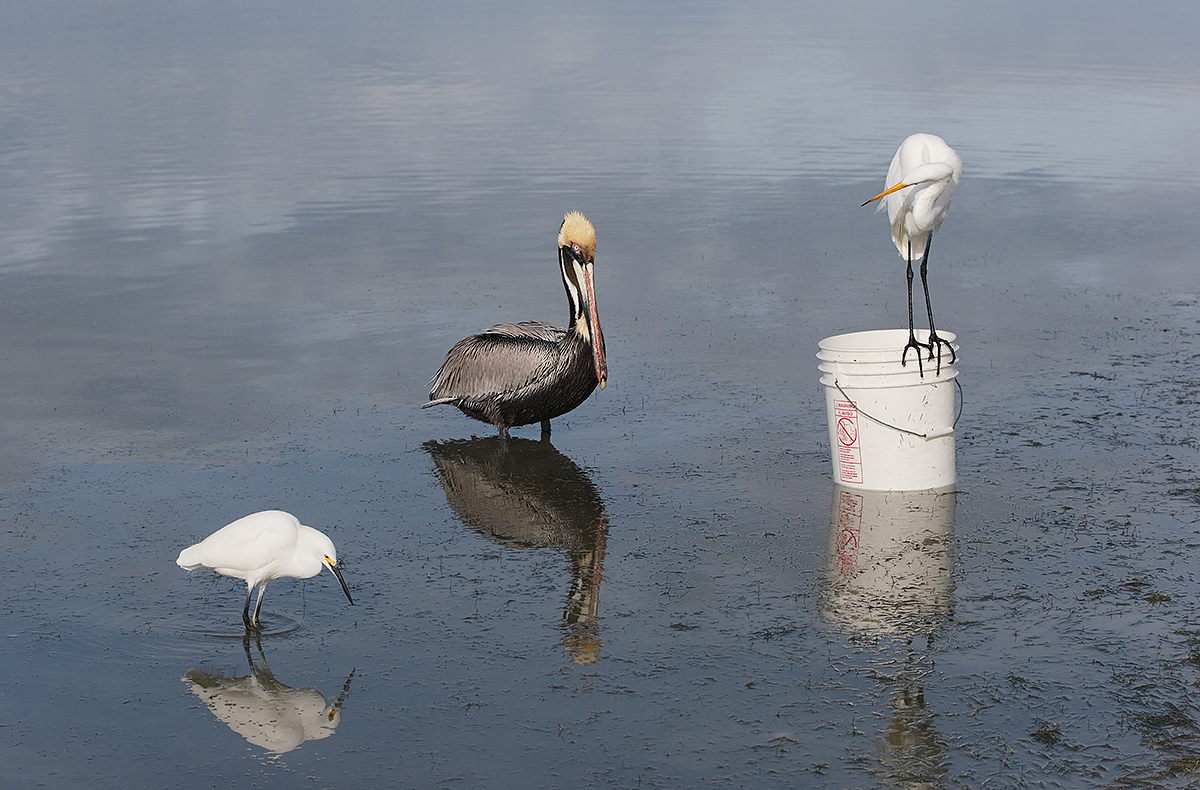
|
|
This scene was photographed on the Little Estero Lagoon IPT with the Canon EF 70-200mm f/2.8L IS II USM lens, the Canon Extender EF 1.4X III (hand held at 98mm), and the Canon EOS-1D X. ISO 400. Evaluative metering -1/3 stop: 1/2500 sec. at f/8 in Manual mode was about 1/2 stop underexposed. Color temperature: AWB.
Central Sensor/AI Servo/Surround Rear Focus AF on the head of the closest bird, the Snowy Egret, and re-compose. Click here to see the latest version of the Rear Focus Tutorial. Click on the image to see a larger version.
|
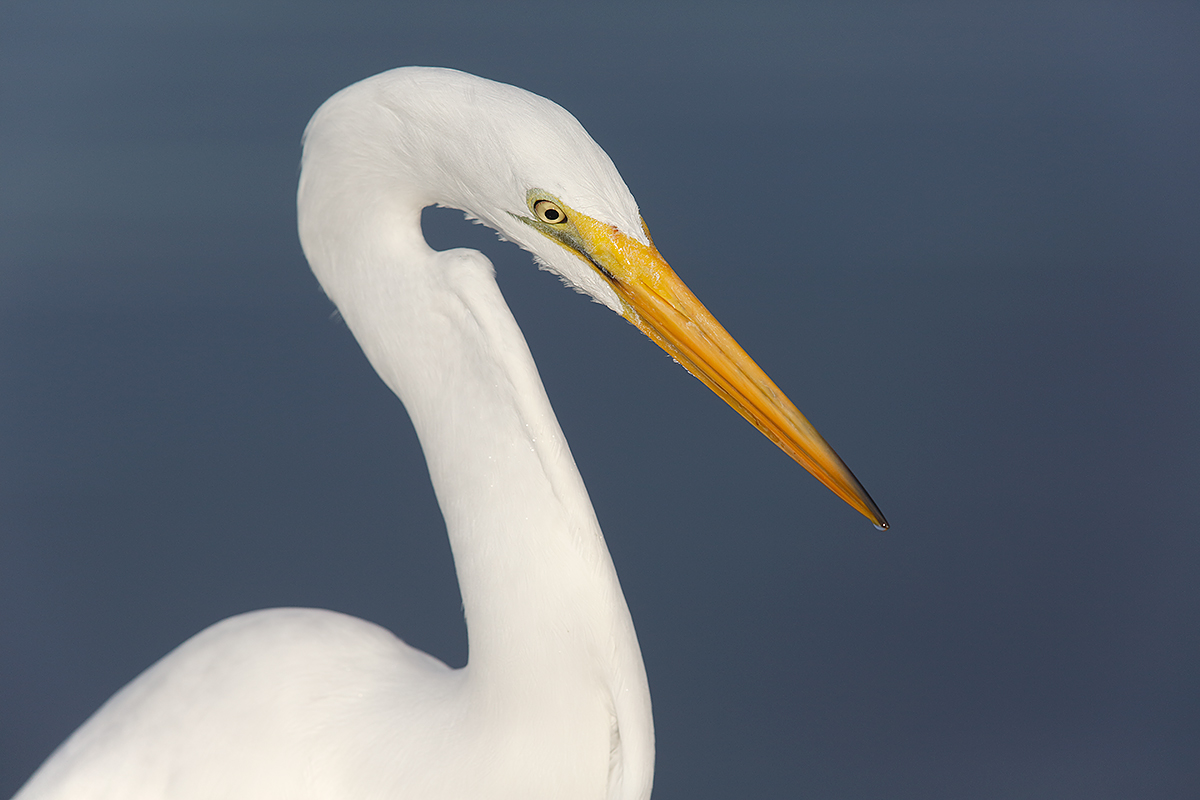
|
|
This Great Egret image was also created on the Little Estero Lagoon IPT while sitting behind my lowered Gitzo 3532 LS carbon fiber tripod with the Mongoose M3.6 head, the Canon EF 600mm f/4L IS II USM lens, the Canon 1.4x EF Extender III (Teleconverter), and the Canon EOS-1D X. ISO 400. Evaluative metering at zero at 8:15am: 1/2500 sec. at f/7.1 in Manual mode, again the standard ISO 400 bright white in full sun exposure (and the equivalent of 1/2000 sec. at f/8.). Color temperature: AWB.
Two sensors above the central sensor/AI Servo/Surround Rear Focus AF just caught the white feathers near the base of the lower mandible active at the moment of exposure. Click here to see the latest version of the Rear Focus Tutorial. Click on the image to see a larger version.
|
|
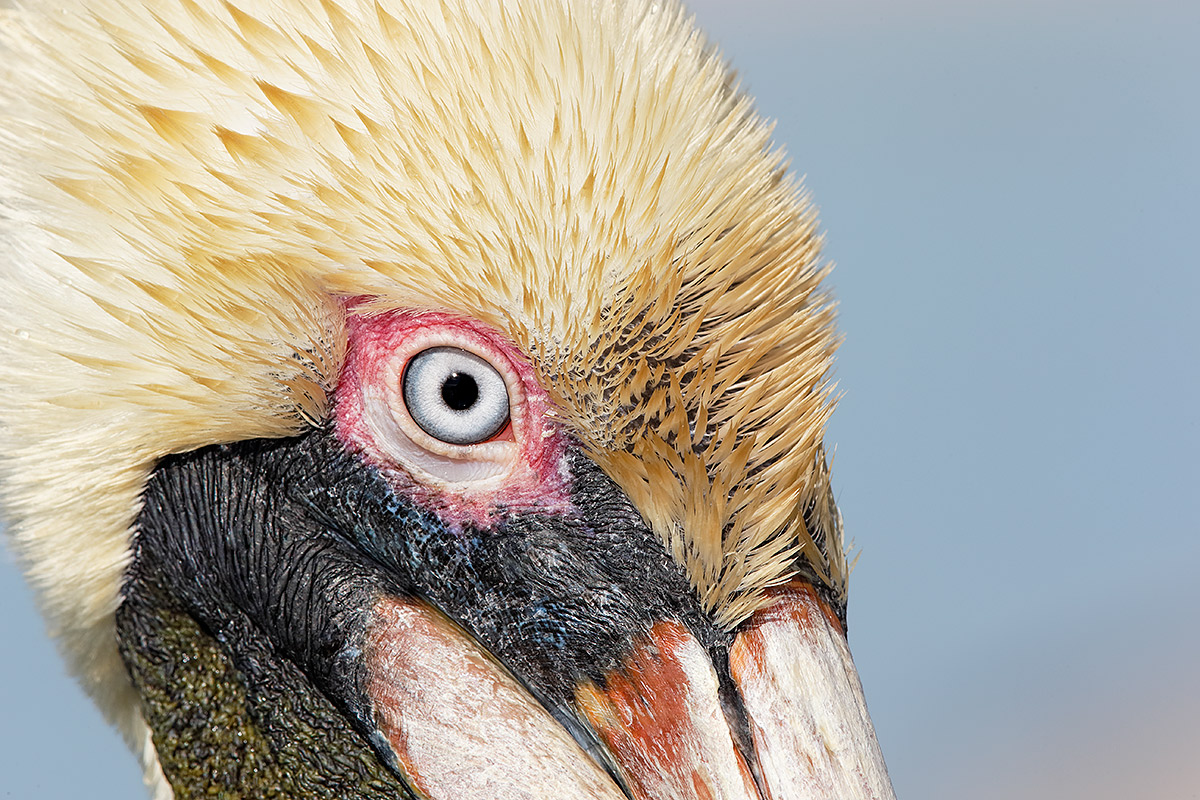
|
|
This tight face portrait of a Brown Pelican was also created on the Little Estero Lagoon IPT while sitting behind my lowered Gitzo 3532 LS carbon fiber tripod with the Mongoose M3.6 head. This one with the Canon EF 600mm f/4L IS II USM lens and the Canon EOS-1D X. ISO 400. Evaluative metering +1/3 stop: 1/320 sec. at f/16 in Manual mode. Color temperature: AWB.
Two sensors to the left of the Central Sensor/AI Servo/Surround Rear Focus AF on the birds eye. Click here to see the latest version of the Rear Focus Tutorial. Click on the image to see a larger version.
|
Your Favorite?
Please take a moment to leave a comment and let us know which of the five images here is your favorite, and as always, be sure to let us know why.
I will be quick to answer any question on the images or the bait bucket and to respond to all comments, at least for the next two days.
EOS-1D X Autofocus Guide
Learn the ins and out of the great AF system of the 1D X. Of special interest to bird photographers will be my comments and strategies involving Cases 1-6, the custom-Case that I created and use for most of my bird photography (with detailed instructions for setting it up of course), my strategy for Select AF area selection mode (on AF4, the fourth purple menu), and pretty much anything that has to do with 1D X autofocus….Get your PDF via e-mail here for only $25.

|
|
If you’d like to learn from the two folks who created the images in the composite above do consider one of the trips below. Denise Ippolito’s images: Japanese leaf painting, skimmer in flight, curved Keukenhof paths with tulips, copulating terns, & pink dahlia. Artie’s images: Snow Geese snowstorm blur, crane landing silhouettes, Leopard with prey in tree, King Penguin, & vertical tulip.
|
A Creative Adventure/BIRDS AS ART Instructional Photo-Tours (IPTs)/Two great leaders: Arthur Morris & Denise Ippolito.
Arthur Morris/BIRDS AS ART www.BIRDSASART-blog.com for the latest images, info, & education
Denise Ippolito/A Creative Adventure www.deniseippolito.com: get yourself out of the box!
Denise’s e-books: Bloomin’ Ideas, A Guide to Filters & Effects, The Softer Side of Macro, & more. Free Monthly Creative MiniMag: www.deniseippolito.com/magazine
Nickerson Baby Beach-nesting Birds IPT, Long Island, NY: 3-Full Days/July 22-24, 2014: $1199.
Black Skimmers, Common Terns with chicks, American Oystercatcher & Piping Plover families; breeding behaviors including courtship feeding, display flight and combat, and copulations. Gulls and shorebirds.
UK Puffins IPT. Early July, 2014.
Details TBA. Please e-mail to be placed on the interested list.
Tanzania Serengeti Summer Safari: Leave US: August 9—return: August 24, 2014: $12,999.
Co-leaders: Arthur Morris & Todd Gustafson. Wildebeest/The Great Migration, cats, elephant, giraffe, zebra, birds & more. Please e-mail for brochure.
Swan Island Dahlia Farm IPT, Canby, OR, September 8-12, 2014: 5 FULL DAYS: $1699.
Leader: Denise Ippolito. 40 acres with 350+dazzling varieties of dahlias in a plethora of colors, shapes and sizes. Sharpen your technical skills and boost your creative juices. Daily assignments, image sharing, and Photoshop sessions.
Bosque del Apache 2014 A Creative Adventure/BIRDS AS ART “Creative Photography Instructional Photo-Tour.” (IPT). NOV 24-25, 2014. 2-FULL DAYS: $729.
Leaders: Denise Ippolito & Arthur Morris. Introductory Slide program: 7:00pm on Sunday 11/23. This IPT is perfect for folks who want to learn to think outside the box, to create new and different images. Learn to unleash your creative juices at the wondrous Bosque del Apache, NWR in San Antonio, NM.
Bosque del Apache 2014 BIRDS AS ART/A Creative Adventure Instructional Photo-Tour (IPT). NOV 29-DEC 3, 2014. Totaling 4 FULL-DAYS: $1449
. Leaders: Arthur Morris and Denise Ippolito. Introductory Slide program: 7:00pm on Sunday 11/29. Tens of thousand of Snow Geese, 10,000 Sandhill Cranes, ducks, amazing sunrises, sunsets, and blast-offs. Live, eat, and breathe photography with two of the world’s premier photographic educators at one of their very favorite photography locations on the planet.
Antarctica/The Extended Expedition Voyage: Antarctic Peninsula, South Georgia and Falkland Islands: December 13, 2014 to January 10, 2015.
Please e-mail for details.
BAA offers a wide range of books, e-Guides, and educational materials and photographic accessories at the lowest prices around—25+ years of experience, and the best advice you can get. We will not sell you junk. Access the BAA Store here or call us at 1-863-692-0906.
Questions? Please e-mail us at birdsasart@verizon.net or photographybydenise221@gmail.com.
Support the BAA Blog. Support the BAA Bulletins: Shop B&H here!
We want and need to keep providing you with the latest free information, photography and Photoshop lessons, and all manner of related information. Show your appreciation by making your purchases immediately after clicking on any of our B&H or Amazon Affiliate links in this blog post. Remember, B&H ain’t just photography!


 


Amazon
Everyone buys something from Amazon, be it a big lens or deodorant. Support the blog by starting your search by clicking on the logo-link below. No purchase is too small to be appreciated; they all add up. Why make it a habit? Because I make it a habit of bringing you new images and information on an almost daily basis.
Typos
In all blog posts and Bulletins, feel free to e-mail or to leave a comment regarding any typos, wrong words, misspellings, omissions, or grammatical errors. Just be right. 🙂
IPT Info
Many of our great trips are filling up. See especially info on the Holland, Nickerson Beach, and Bosque IPTs. Two great leaders on most trips ensure that you will receive individual attention, have all of your questions answered, and learn a ton including how to think like a pro, see the situation, and get the right exposure every time. In addition you will have fun, and make lots of great images. Click here for IPT details and general information.
February 7th, 2014 The Streak Goes On…
I continue to feel pretty good today. I fly to Japan next Monday. Denise Ippolito and Paul McKenzie will be co-leading.
This post marks 72 straight days with a new educational blog post, a record by far that should be extended for at least another few days or so, or not. I am not sure how good the internet access (if any) will be in Japan. To show your appreciation for my efforts here, we ask that use our B&H and Amazon affiliate links for all of your B&H and Amazon purchases. Please check the availability of all photographic accessories in the BIRDS AS ART Online Store. We sell only what I use and depend on. We will not sell you junk. We know what you need to make creating great images easy and fun. And we are always glad to answer your gear questions via e-mail.
You can find the following items in the store: Gitzo tripods, Mongoose M3.6 and Wimberley heads, plates, low feet, and accessories, flash brackets, , Delkin e-film Pro Compact Flash Cards, LensCoat products, and our unique line-up of educational materials including ABP I & II, Digital Basics, Site and Set-up e-Guides, Canon and Nikon Camera Users and AF e-Guides, and MP-4 Photoshop video tutorials among others.
We would of course appreciate you using our B&H and Amazon affiliate links for all of your B&H and Amazon major gear, video, electronic, household, and personal purchases. For the photographic stuff mentioned in the paragraph above we would of course greatly appreciate your business. Here is a huge thank you to the many who have been using our links on a regular basis and visiting the BAA Onliine store as well.
Thanks and enjoy today’s blog post! With no images, this one took only a bit more than an hour to prepare.
Laziness?
When photographing at Anhinga Trail in Everglades National Park I always bring my longest telephoto, currently the Canon EF 600mm f/4L IS II USM lens. I have the Canon EF 70-200mm f/2.8L IS II USM lens usually with the Canon Extender EF 1.4X III in place with the rig conveniently on my shoulder and easily within reach with a Black Rapid RS-7 strap. In my vest I routinely stow another Canon Extender EF 1.4X III along with a single Canon 2x EF Extender III (Teleconverter). (Note: because they are so important to the work that I do I travel with three 1.4X III TCs and two 2X III TCs.) As I preach often, never head into the field without a short zoom lens on your person. I have traditionally kept my Canon EF 24-105mm f/4L IS USM lens in one of the large pockets of my Xtrahand vest. Having just sold that lens I will begin keeping my new Canon EF 24-70mm f/2.8L II USM lens in the vest.
On the morning of February 2, 2014, the 2nd morning of the Anhinga Trail IPT, I headed down the path with all of the above-mentioned gear in place. We had some good chances early on. With my vest packed with the 24-105, my tool kit, water, and on that morning, the Canon EF 100mm f/2.8L Macro IS USM lens as well, I always try to remember to remove my vest and place it on the ground when working a good situation. I did that as I headed back towards the visitor center and as an afterthought, took the 70-200 off of my shoulder and placed it atop the vest that had been placed off the trail on the grass. As there was not much flying around I figured that it would be nice to travel light. As I go halfway to the big tree now on my left, a Black Vulture flew right at me into the east wind right down sun angle. I reached for my 70-200 but quickly realized that I had decided to leave it behind. Ooops. Then, as if to taunt me, the vulture circled and again flew right into the perfect flight photography zone….
Turtle Soup
The next afternoon marked the end of a long ten days of teaching and photography. Having not learned my lesson, I had already decided not to lug the 70-200. Then I decided after some hemming and hawing to leave the 24-105 in my SUV. I remember asking Denise, “Should I bring the 24-105?” She said, “Bring it.” I didn’t listen…. So I headed out with only the 600 II. We had yet another excellent afternoon with a clean Green Heron and a pair of very handsome preening Anhingas. It was just about sunset and I was messing around with a fishing Great Egret when I couldn’t help but see and hear a loud splash right in front of me in the slough. I called out to everyone within earshot, “A gator’s got something.” In the low light of dusk I strained to see what the prey was. At first I thought it was a large fish. Then the gator, about a 7-footer, climbed out of the slough with a huge Soft-shelled Turtle in its jaws.
Oh how I wished that I had not left the 24-105 in the trunk…. Even the 70-200 would have been OK with the 1.4X TC quickly removed. With only the 600mm, I was dead in the water as the gator and its prey were blocked by grasses on both sides. It was as Deirdre suggested later, “Turtle soup.” The gator’s chomps on the shell of the turtle were accompanied by loud cracking sounds. The turtle was trying to bite the side of the big reptile but its efforts seemed feeble at best. Then, remarkably, the turtle broke free and bolted towards the slough. The gator made a lightning fast turn with its jaws fully open and once again chomped down on the now hapless and helpless reptile. Deridre’s images showed later that the gator had the turtle completely within its jaws.
I mentioned to the group that the person who had made the best images of the encounter was a youngster of about ten who walked right up to the low fence and photographed the carnage with his cell phone….
The Moral of the Story
Here is the moral of the story:
If you are thinking about leaving a certain piece of gear behind always opt to bring it. If you don’t, you will almost always learn quickly why you should have brought it.
Here is another important lesson: the longest lens is often not the best lens for the job.
One final thought: it is often said that if God or whomever is in charge of such things gives you a lesson and you don’t get it, then God or whomever will keep giving you that lesson again and again until you learn it. Maybe I learned the lesson for good on the Anhinga Trail IPT. Or not….

|
|
Join me for the 2014 Tanzania Summer Safari!
|
2014 Tanzania Summer Safari, 14-day African Adventure/leave the US on August 9. Fly home on August 24: $12,999.
Co-leaders Todd Gustafson & Arthur Morris. The limit is 12. Three photographers/van; you get your own row of seats. Our trip is a bit more expensive than the average safari for good reason. It is the best. We have the best driver guides with a total of decades of experience. They have been trained over the years by Todd and by me to drive with photography in mind. We have the best and most knowledgeable leaders. We stay in the best lodges and camps. We hope that you will join us for what will be Todd’s 35th African safari, and my 8th.
If you are seriously interested please e-mail me; I will be glad to send you the illustrated PDF with the complete itinerary and deposit info.
What else makes this expedition unique?
•Pre-trip consultation and camera equipment advice
•Award-winning photographers as your guides
•A seamless itinerary visiting the right locations at the best time of year
•Hands-on photography instruction in the field
•Specially designed three roof-hatch photo safari vehicles
•Proprietary materials for preparation, including free copy of “A Photographer’s Guide to Photographing in East Africa.”
•Post-safari image critiques
All-inclusive (double-occupancy) except for your flights to and from Kilamajaro Airport, bar drinks, soda & water (except at the Intimate Tented Camp where everything is free for our entire stay), tips for drivers and camp staff, personal items, and trip insurance.

|
|
Breathe deeply, bite the bullet, and live life to its fullest; we all get only one ride on the merry-go-round… Join me on this great trip.
Click on the image to enjoy a larger version.
|
The Southern Ocean…
If you would like to explore the possibility of joining me on the Cheesemans’ Ecology Safaris Antarctica/The Extended Expedition Voyage< trip: Antarctic Peninsula, South Georgia and Falkland Islands: December 13, 2014 to January 10, 2015, click here for additional information and then shoot me an e-mail.
The DPP RAW Conversion Guide
To learn why I use Canon’s Digital Photo Professional (DPP) to convert every image that I work on, click here.
Support the BAA Blog. Support the BAA Bulletins: Shop B&H here!
We want and need to keep providing you with the latest free information, photography and Photoshop lessons, and all manner of related information. Show your appreciation by making your purchases immediately after clicking on any of our B&H or Amazon Affiliate links in this blog post. Remember, B&H ain’t just photography!


 


Amazon
Everyone buys something from Amazon, be it a big lens or deodorant. Support the blog by starting your search by clicking on the logo-link below. No purchase is too small to be appreciated; they all add up. Why make it a habit? Because I make it a habit of bringing you new images and information on an almost daily basis.
Typos
In all blog posts and Bulletins, feel free to e-mail or to leave a comment regarding any typos, wrong words, misspellings, omissions, or grammatical errors. Just be right. 🙂
IPT Info
Many of our great trips are filling up. See especially info on the South Florida, Holland, and Nickerson Beach IPTs. Two great leaders on most trips ensure that you will receive individual attention, have all of your questions answered, and learn a ton including how to think like a pro, see the situation, and get the right exposure every time. In addition you will have fun, and make lots of great images. Click here for IPT details and general information.
February 6th, 2014 The Streak Goes On…
I am feeling pretty darned good today. I fly to Japan next Monday. Denise Ippolito and Paul McKenzie will be co-leading.
This post marks 71 straight days with a new educational blog post, a record by far that should be extended for at least another few days or so, or not. I am not sure how good the internet access (if any) will be in Japan. To show your appreciation for my efforts here, we ask that use our B&H and Amazon affiliate links for all of your B&H and Amazon purchases. Please check the availability of all photographic accessories in the BIRDS AS ART Online Store. We sell only what I use and depend on. We will not sell you junk. We know what you need to make creating great images easy and fun. And we are always glad to answer your gear questions via e-mail.
You can find the following items in the store: Gitzo tripods, Mongoose M3.6 and Wimberley heads, plates, low feet, and accessories, flash brackets, , Delkin e-film Pro Compact Flash Cards, LensCoat products, and our unique line-up of educational materials including ABP I & II, Digital Basics, Site and Set-up e-Guides, Canon and Nikon Camera Users and AF e-Guides, and MP-4 Photoshop video tutorials among others.
We would of course appreciate you using our B&H and Amazon affiliate links for all of your B&H and Amazon major gear, video, electronic, household, and personal purchases. For the photographic stuff mentioned in the paragraph above we would of course greatly appreciate your business.
Thanks and enjoy today’s blog post! This one took about 1 1/2 hours to assemble. And a huge thanks to the many who have been using our links on a regular basis.
Used Canon 24-105mm f/4L IS USM Lens for Sale/$600!
Sale Pending
I am offering my used Canon EF 24-105mm f/4L IS USM Lens for sale for $600. The lens is in excellent condition with the front element pristine. It includes the original box and everything that came in it. Buyer pays insured shipping to US addresses only via UPS Ground. Personal check only; we will not ship until your check clears. Sorry, but I was burned for $3K on a used 1D Mark III 🙂 If you are seriously interested please shoot me an e-mail.
Note: the lens is $1149 new. I have upgraded to the Canon EF 24-70mm f/2.8L II USM lens that meshes perfectly with my beloved Canon EF 70-200mm f/2.8L IS II. The 24-70 II sells for $2,299.00.
Multi-Subject Flight Photography Tips and a Primer On Exposing for Whites in Bright Sun
In the Multi-Subject Flight Photography Tips and a Primer On Exposing for Whites in Bright Sun post, my favorite of the three by far was the image above, the one of the two cranes with the mountain backdrop. Why? The lovely soft light, the pleasing background with both birds completely below the distant ridge (with no merging), and the synchronicity of the two perfect downstroke wing postiions. I have responded to all comments and questions at that post.
John Haedo Comment
Artie, I always learn something from your blogs, but this one is a real gem. Lots of VERY useful information here, already copied and pasted into a Word document that I will refer to from time to time. Rest assured I’m not the only one who appreciates these tips from you. I, for one, read them over and over again. Having been at Bosque with you, I can visualize exactly what you are saying here; I feel like I’m there shooting the cranes and snow geese, but with greater understanding.
Three Lenses, and the Power of Twelve
In the Three Lenses, and the Power of Twelve post, I asked, #1- Which of these images do you think that I created first? Why? and #2: Why only +1/3 stop for all three of these images?
I made the large in the frame image first. Why? My vision always goes for tight and graphic first. The educational images created with shorter focal lengths were made only after I have created the vertical portrait above.
Doug West proved that he knows me too well when he wrote:
#1 – Going against the grain, I’m going to say you created #3 first. Why? Being in the van and not knowing how close you could really get, you pulled out the big gun first.
Greg Payne nailed the exposure question when he wrote,
Why add only 1/3? It was a sunny day. The camera’s computer is pretty smart then. You added 1/3 to bring out slightly more detail but did not do more because the camera’s exposure reading is pretty accurate on a sunny day.
He is obviously a well-studied BAA disciple 🙂
Follow Your Nose…
In Follow Your Nose… I asked, #1-In the second image, why was it a mistake to have the internal TC in place? #2-In the second image, considering that I was hand holding, what factors helped me to create a relatively sharp image at only 1/30 sec.? #3-Which of the images above is your favorite? Why? I have two clear favorites and will share them with you at some point.
#1: Knowing that I wanted to go wide I should have disengaged the internal TC.
#2:Good rifle shooter’s sharpness technique and the great 4-stop IS system.
#3: My very favorite image was the last blur for its two-direction blur–the birds going against the panning motion caused the zig-zag blurring. And I liked the second image for the soft light and the pleasing patterns of the perched birds. My least favorite of the four was the image that opened the blog post.
You Should Be So Lucky/Bird Photography Hotspot: Little Estero Lagoon, Fort Myers Beach, FL
In the You Should Be So Lucky/Bird Photography Hotspot: Little Estero Lagoon, Fort Myers Beach, FL blog post I loved the 2nd image for the pink light and the out-of-the-box image design but the opening image, the one above, was my favorite of the 2 by a large margin? Why? It is rare that you have a chance to photograph a virtually perfect specimen of any species in full breeding plumage and white morph Reddish Egret is one of the most beautiful species on the planet. I just love birds with the blue/pink/white color scheme… In addition to the wonderful colors I love the killer still blue water background (with a few ripples no less), the sweet light, the sharpness, and the pleasing image design.
Looking Back…
I have been remiss in not following up on various blog posts for quite some time. I feel that my following up is an important part of the learning that is going on here. I will do my best to continue in this vein in the future. If you have a new question on anything above, please shout it out by leaving a comment.
Your Favorite?
Please take a moment to let us know which of the 3 completely different images above is your favorite. And why.

|
|
Join me for the 2014 Tanzania Summer Safari!
|
2014 Tanzania Summer Safari, 14-day African Adventure/leave the US on August 9. Fly home on August 24: $12,999.
Co-leaders Todd Gustafson & Arthur Morris. The limit is 12. Three photographers/van; you get your own row of seats. Our trip is a bit more expensive than the average safari for good reason. It is the best. We have the best driver guides with a total of decades of experience. They have been trained over the years by Todd and by me to drive with photography in mind. We have the best and most knowledgeable leaders. We stay in the best lodges and camps. We hope that you will join us for what will be Todd’s 35th African safari, and my 8th.
If you are seriously interested please e-mail me; I will be glad to send you the illustrated PDF with the complete itinerary and deposit info.
What else makes this expedition unique?
•Pre-trip consultation and camera equipment advice
•Award-winning photographers as your guides
•A seamless itinerary visiting the right locations at the best time of year
•Hands-on photography instruction in the field
•Specially designed three roof-hatch photo safari vehicles
•Proprietary materials for preparation, including free copy of “A Photographer’s Guide to Photographing in East Africa.”
•Post-safari image critiques
All-inclusive (double-occupancy) except for your flights to and from Kilamajaro Airport, bar drinks, soda & water (except at the Intimate Tented Camp where everything is free for our entire stay), tips for drivers and camp staff, personal items, and trip insurance.

|
|
Breathe deeply, bite the bullet, and live life to its fullest; we all get only one ride on the merry-go-round… Join me on this great trip.
Click on the image to enjoy a larger version.
|
The Southern Ocean…
If you would like to explore the possibility of joining me on the Cheesemans’ Ecology Safaris Antarctica/The Extended Expedition Voyage< trip: Antarctic Peninsula, South Georgia and Falkland Islands: December 13, 2014 to January 10, 2015, click here for additional information and then shoot me an e-mail.
The DPP RAW Conversion Guide
To learn why I use Canon’s Digital Photo Professional (DPP) to convert every image that I work on, click here.
Support the BAA Blog. Support the BAA Bulletins: Shop B&H here!
We want and need to keep providing you with the latest free information, photography and Photoshop lessons, and all manner of related information. Show your appreciation by making your purchases immediately after clicking on any of our B&H or Amazon Affiliate links in this blog post. Remember, B&H ain’t just photography!


 


Amazon
Everyone buys something from Amazon, be it a big lens or deodorant. Support the blog by starting your search by clicking on the logo-link below. No purchase is too small to be appreciated; they all add up. Why make it a habit? Because I make it a habit of bringing you new images and information on an almost daily basis.
Typos
In all blog posts and Bulletins, feel free to e-mail or to leave a comment regarding any typos, wrong words, misspellings, omissions, or grammatical errors. Just be right. 🙂
IPT Info
Many of our great trips are filling up. See especially info on the South Florida, Holland, and Nickerson Beach IPTs. Two great leaders on most trips ensure that you will receive individual attention, have all of your questions answered, and learn a ton including how to think like a pro, see the situation, and get the right exposure every time. In addition you will have fun, and make lots of great images. Click here for IPT details and general information.
February 5th, 2014 The Streak Goes On…
I am feeling pretty good with just a tiny sore throat and a bit of chest congestion remaining on Day 18 of my epic head cold. I fly to Japan next Monday.
This post marks 70 straight days with a new educational blog post, a record by far that should be extended for at least another few days or so, or not. To show your appreciation, we ask that use our B&H and Amazon affiliate links for all of your B&H and Amazon purchases. Please check the availability of all photographic accessories in the BIRDS AS ART Online Store. We sell only what I use and depend on. We will not sell you junk. We know what you need to make creating great images easy and fun. And we are always glad to answer your gear questions via e-mail.
You can find the following items in the store: Gitzo tripods, Mongoose M3.6 and Wimberley heads, plates, low feet, and accessories, flash brackets, , Delkin e-film Pro Compact Flash Cards, LensCoat products, and our unique line-up of educational materials including ABP I & II, Digital Basics, Site and Set-up e-Guides, Canon and Nikon Camera Users and AF e-Guides, and MP-4 Photoshop video tutorials among others.
We would of course appreciate you using our B&H and Amazon affiliate links for all of your B&H and Amazon major gear, video, electronic, household, and personal purchases. For the photographic stuff mentioned in the paragraph above we would of course greatly appreciate your business.
Thanks and enjoy today’s blog post! This one took about 2 hours to assemble.
Splish Splash…
Bobby Darin: Splish Splash (I was takin’ a bath). And for the Bobby Darin fans: Dream Lover.
Recognizing Bird Behavior
The image above shows a Wilson’s Plover in the beginning stages of bathing.
On many IPTs, denise and I will call out, “Bathing bird!” Not realizing that a bird dipping its breast and often its head in the water is in the process of bathing and that 90% of the time, the bird will rise or fly up and flap its wings, many participants stare blankly. Then we explain the process and the possibilities. When the birds finally do flap their wings vigorously–you often have to beg them to flap–everyone is amazed. But birds have been bathing and flapping after their baths for eons. Pretty much all species of birds bathe though the exact procedure often varies. Sandhill Cranes for example sock themselves and may put their heads in the water while flopping around with their wings but I have never seen them raise up and flap.
The most commonly photographed bathers/flappers are the ducks, shorebirds, gulls, and terns among others. The smaller species especially the shorebirds often flap so hard that they take flight after their baths. Whenever photographing birds in the process of bathing you face a dilemma: add a teleconverter or get closer to photograph the dramatic flashing, or stay back and relatively wide in hopes of creating a spectacular image of the flap? (Note: with the right situation and the Canon EF 200-400mm f/4L IS USM lens with Internal 1.4x Extender it is possible to do both from the same spot.
The Flapping Strategies
If you wish to photograph the dramatic flapping, you are again faced with 2 choices: use either Rear or One-Shot AF, focus on the bird’s face, and when it raises up to flap, fire away without attempting to track the subject. Or, you may focus on the bird’s head, face, or breast with either Rear Focus or Shutter Button AI Servo, and keep focus active as the bird raises up and start to flap. The first approach requires some luck–the bird must raise straight up to remain in focus. The second approach requires some degree of skill, especially when the bird veers of to one side…. I have had success with both methods. Part of the skill involves anticipating when to track the bird as it flaps and rises and when to bump the focus (as described in Jim Neiger’s great eGuide, Flight Plan).
After studying bathing birds seriously you will be able to anticipate when the bird will begin to flap; their dipping and flopping usually becomes more and more frenetic just before they rise up and beat their wings vigorously. As always, the more you study and come to know bird behavior the better photographer you will become.
Miscellaneous
Each of these images was created while I was kneeling behind my lowered tripod. Each was cropped to varying degrees from the bottom and from the side as needed to center the bird’s head. All three images were converted in DPP. After adjusting the sliders for the first image I cut and pasted the recipe to the other two files to save lots of time while doing the RAW conversions.
Your Favorite?
Please take a moment to leave a comment and let us know which of the flapping images is your favorite. And why?
Do you know which feathers are the tertials?

|
|
Join me for the 2014 Tanzania Summer Safari!
|
2014 Tanzania Summer Safari, 14-day African Adventure/leave the US on August 9. Fly home on August 24: $12,999.
Co-leaders Todd Gustafson & Arthur Morris. The limit is 12. Three photographers/van; you get your own row of seats. Our trip is a bit more expensive than the average safari for good reason. It is the best. We have the best driver guides with a total of decades of experience. They have been trained over the years by Todd and by me to drive with photography in mind. We have the best and most knowledgeable leaders. We stay in the best lodges and camps. We hope that you will join us for what will be Todd’s 35th African safari, and my 8th.
If you are seriously interested please e-mail me; I will be glad to send you the illustrated PDF with the complete itinerary and deposit info.
What else makes this expedition unique?
•Pre-trip consultation and camera equipment advice
•Award-winning photographers as your guides
•A seamless itinerary visiting the right locations at the best time of year
•Hands-on photography instruction in the field
•Specially designed three roof-hatch photo safari vehicles
•Proprietary materials for preparation, including free copy of “A Photographer’s Guide to Photographing in East Africa.”
•Post-safari image critiques
All-inclusive (double-occupancy) except for your flights to and from Kilamajaro Airport, bar drinks, soda & water (except at the Intimate Tented Camp where everything is free for our entire stay), tips for drivers and camp staff, personal items, and trip insurance.

|
|
Breathe deeply, bite the bullet, and live life to its fullest; we all get only one ride on the merry-go-round… Join me on this great trip.
Click on the image to enjoy a larger version.
|
The Southern Ocean…
If you would like to explore the possibility of joining me on the Cheesemans’ Ecology Safaris Antarctica/The Extended Expedition Voyage< trip: Antarctic Peninsula, South Georgia and Falkland Islands: December 13, 2014 to January 10, 2015, click here for additional information and then shoot me an e-mail.
The DPP RAW Conversion Guide
To learn why I use Canon’s Digital Photo Professional (DPP) to convert every image that I work on, click here.
Support the BAA Blog. Support the BAA Bulletins: Shop B&H here!
We want and need to keep providing you with the latest free information, photography and Photoshop lessons, and all manner of related information. Show your appreciation by making your purchases immediately after clicking on any of our B&H or Amazon Affiliate links in this blog post. Remember, B&H ain’t just photography!


 


Amazon
Everyone buys something from Amazon, be it a big lens or deodorant. Support the blog by starting your search by clicking on the logo-link below. No purchase is too small to be appreciated; they all add up. Why make it a habit? Because I make it a habit of bringing you new images and information on an almost daily basis.
Typos
In all blog posts and Bulletins, feel free to e-mail or to leave a comment regarding any typos, wrong words, misspellings, omissions, or grammatical errors. Just be right. 🙂
IPT Info
Many of our great trips are filling up. See especially info on the South Florida, Holland, and Nickerson Beach IPTs. Two great leaders on most trips ensure that you will receive individual attention, have all of your questions answered, and learn a ton including how to think like a pro, see the situation, and get the right exposure every time. In addition you will have fun, and make lots of great images. Click here for IPT details and general information.
February 4th, 2014 And the Streak Continues
I am glad to report that Denise Ippolito made it home safely despite the snowstorm. I stopped on the way home at Wakodahatchee for some early morning bird photography. I am feeling pretty good with just a bit of chest congestion remaining on Day 17 of my epic head cold. I fly to Japan next Monday.
This post marks 69 days in a row with a new educational blog post, a record by far that should be extended for at least another week or so. Or not. 🙂 To show your appreciation, we ask that use our B&H and Amazon affiliate links for all of your B&H and Amazon purchases. Please check the availability of all photographic accessories in the BIRDS AS ART Online Store. We sell only what I use and depend on. We will not sell you junk. We know what you need to make creating great images easy and fun. And we are always glad to answer your gear questions via e-mail.
You can find the following items in the store: Gitzo tripods, Mongoose M3.6 and Wimberley heads, plates, low feet, and accessories, flash brackets, , Delkin e-film Pro Compact Flash Cards, LensCoat products, and our unique line-up of educational materials including ABP I & II, Digital Basics, Site and Set-up e-Guides, Canon and Nikon Camera Users and AF e-Guides, and MP-4 Photoshop video tutorials among others.
We would of course appreciate you using our B&H and Amazon affiliate links for all of your B&H and Amazon major gear, video, electronic, household, and personal purchases. For the photographic stuff mentioned in the paragraph above we would of course greatly appreciate your business.
Thanks and enjoy today’s blog post! This one took about 2 1/2 hours to assemble.

|
|
This image of a Black Vulture coming in for a landing was created at 6:52am on the Anhinga Trail IPT with the Gitzo 3532 LS carbon fiber tripod, Mongoose M3.6 head, the Canon EF 600mm f/4L IS II USM lens and the Canon EOS-1D X Digital SLR camera. ISO 2000 (with ISO Safety Shift). Evaluative metering +1 2/3 stops: 1/500 sec. at f/4.5 in Tv mode.
Central Sensor/AI Servo/Surround Rear Focus AF just caught the bird’s head and was active at the moment of exposure. This is a much smaller crop than the crop in the opening image. Click here if you missed the Rear Focus Tutorial. Click on the image to see a larger version.
Image #1: Landing
|
The Predawn Silhouette Tv Mode Technique/A Free IPT Lesson
As we entered Anhinga Trail in the dark of predawn I noticed several vultures landing in the big tree on the right about 70 yards down the asphalt path. With the brightening eastern sky, I realized that there would be some opportunities for creating some strong silhouettes and that the situation would present a great teaching opportunity. I let my intentions be known to the group, most of whom were anxious to try for flight silhouettes using my Tv Mode technique. A few were more interested in photographing other species along the slough.
“Go to Tv Mode. If you do not have ISO Safety Shift set, or if your camera does not offer it, set Auto ISO. Set your exposure compensation to +1 2/3 or +2 stops. Then check your histogram. Since we want to create silhouettes and are not trying to see detail on the vultures, you do not want any flashing highlights on the sky. The camera will automatically set an ISO that is high enough to allow for your chosen shutter speed, in this case, 1/500 sec. I am using central sensor Surround. Others may feel more comfortable using the central sensor only. Do not choose 61-point of 19-Point AF; I have found that the full AF arrays usually do not perform well with birds in flight. Be sure to have far distance range set to increase the speed of initial focusing acquisition.”
As some birds were coming in from our left, others flying right at us above the path, and still others were coming from our right, I called out the location of the incoming birds to the group. I created 65 images during our predawn session and kept 4, including the two featured in today’s blog post.
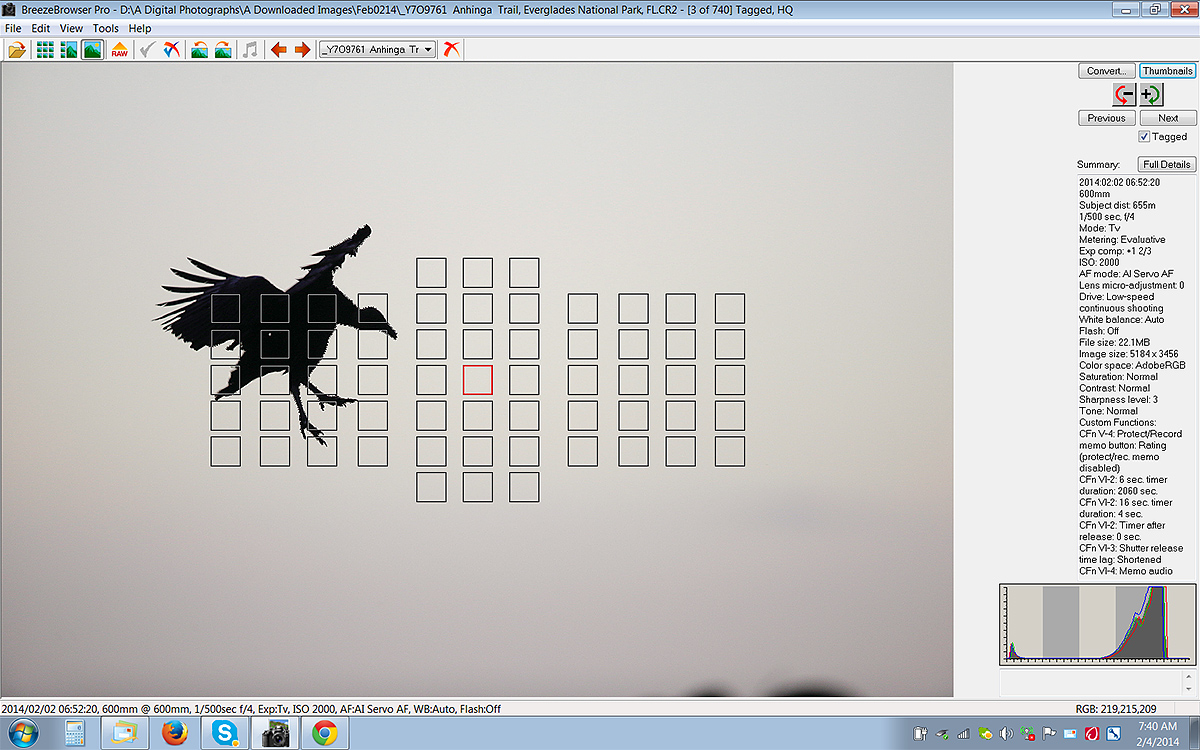
|
|
This is the BreezeBrowser Main View screen capture.
|
BreezeBrowser Main View Screen Capture
Above is the BreezeBrowser Main View screen capture for today’s opening image. Note that the illuminated red square shows the AF point that had been selected manually and indicates that AF was active at the moment of exposure. Somewhat strangely, the assist points are never illuminated when you are using Surround as I was here or expand.
Note: in Breezebrowser you need to check “Show Focus Points” under View to activate this feature. To see the focus points in DPP check “AF Point” under View or hit Alt L. Hit Alt M to see Highlight Alert. To learn how and why I use DPP (Canon Digital Photo Professional) to convert my RAW files, see the info on our DPP RAW Conversion Guide here.
Note that that even though I had added 1 2/3 stops of light to my exposure the image is a bit dark and the histogram could have been pushed a bit more to the right without creating any blinkies. Why? I wanted to sacrifice a bit of noise to keep the ISO down a bit–it would not be visible after making the birds truly black and running Filter/Blur/Surface Blur on the whole image.
Regular readers know that I use and depend on BreezeBrowser every day of the year. It allows me to sort my keepers and delete the rejects faster than any other Windows browsing program. We use it on the main computer in the home office to catalog our images file-drawer style. And the companion program, Downloader Pro allows me to download my images quickly and conveniently. It automatically adds my IPTC data and the shooting location. I have it set up to create a folder named by the Month/date/year. The Breezebrowser/Downloader Pro combo saves me many hours each week. To learn more or to purchase this great PC only program, click here. As far as the BreezeBrowser/Downloader Pro Combo goes, if you are using a Windows platform and are not using these two great programs you are at best, wasting your valuable time. My understanding is that Photo Mechanic is best for Mac-users who do not opt to run Parallels or VM Ware fusion on their Macs so that they can enjoy the many advantages of BreezeBrowser. See BreezeBrowswer on a Mac for details.
AF Compositional Strategy
Seeing that the bird was a bit small in the frame and wanting to keep the bird as far back in the frame as I could, and not having the time to move the AF sensor to my left, I acquired focus and as the bird began to brake I intentionally panned faster to move the bird back in the frame. With the AF settings recommended in both the 1D X AF Guide and the 5D Mark III User’s Guide, I knew that the AF system would stay with the bird for a moment or two even with the active sensors nowhere near the bird. The clean sky background helped and gave me the confidence to try this advanced technique. As birds were coming in at varying distances and from different directions I opted not to to turn AF Search to Off. Doing so would have helped in this exact situation but would have hurt my efforts overall.
|
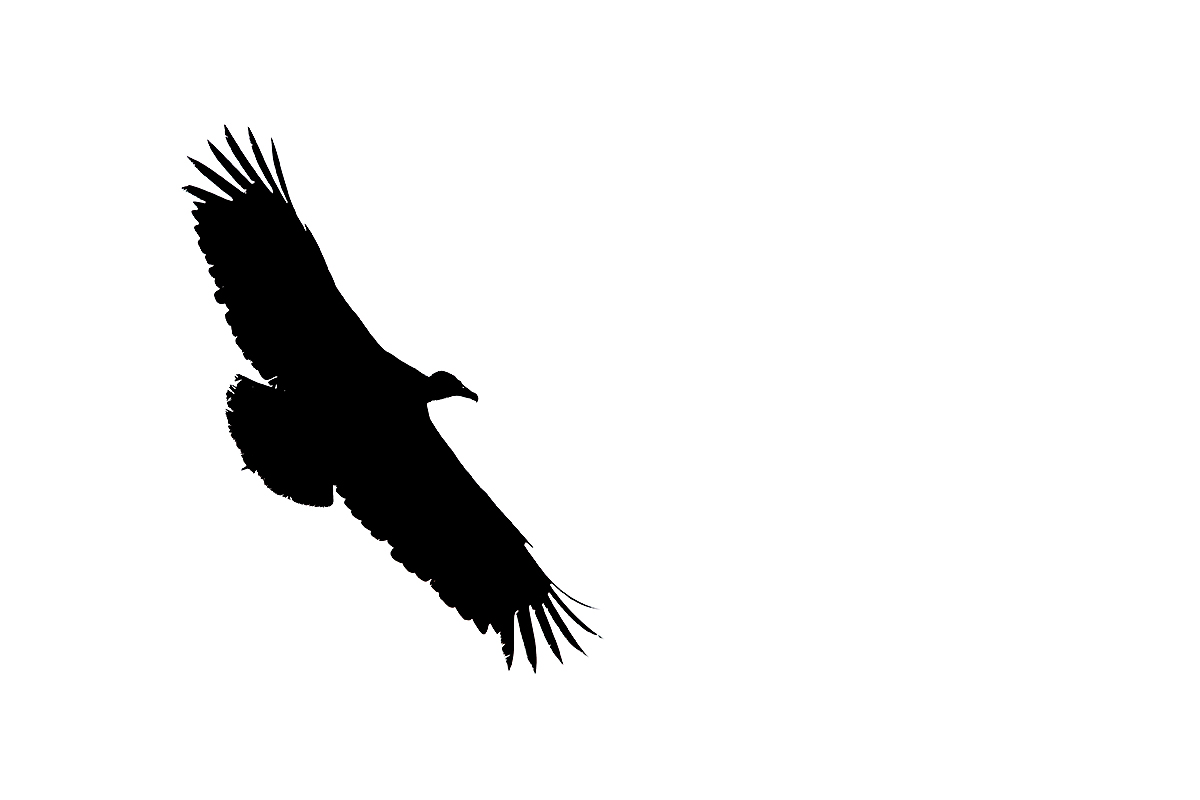
|
|
This image of a banking Black Vulture was also created on the Anhinga Trail IPT with the Gitzo 3532 LS carbon fiber tripod, Mongoose M3.6 head, the Canon EF 600mm f/4L IS II USM lens and the Canon EOS-1D X Digital SLR camera. ISO 2000 (with ISO Safety Shift). Evaluative metering +1 2/3 stops: 1/500 sec. at f/4 in Tv mode.
Central Sensor/AI Servo/Surround Rear Focus AF active at the moment of exposure. No active AF sensor was anywhere near the bird’s head as framed originally. If you are a non-believer, see the animated GIF below. Click here if you missed the Rear Focus Tutorial. Click on the image to see a larger version.
Image #2: Banking
|
Creating the Super-Contrasty Look in Post Processing
I love the very black BLACKs and the pure WHITE sky look of the two images above. I usually create them using a Levels Adjustment Layer by holding the ALT key down and moving the black slider to the right until almost all the colored pixels on the bird disappear. This will yield the super black BLACKs. Then I move the highlight slider a bit to the left for the bright white sky look. With the image above, however, I tried a new strategy: when converting the image in DPP I first upped the Brightness slider. Then I moved the Highlight slider to the right, the Shadow slider to the left, and the Contrast slider to the right to increase contrast. Wow. The image looked great and it is always best to make such tonal adjustments during conversion than in Photoshop.
Digital Basics and APTATS I & II
I used the advanced Quick Masking Techniques detailed in APTATS I to repair a missing chunk of the bird’s tail in the banking vulture image above. I used technques from APTATS II to move the bird in the same image well back in the frame in about 10 seconds. Mention this blog post and Jim will be glad to apply a $5 discount on your APTATS I purchase with phone orders only. Mention this blog post and Jim will be glad to apply a $10 discount on your APTATS II purchase with phone orders only. Order both to hone your Photoshop image clean-up skills and Jim will be glad to enter a $15 discount for the pair, on phone orders only.
The Levels adjustment techniques that I mentioned above are detailed in my Digital Basics File, an instructional PDF that is sent via e-mail. It includes my complete digital workflow, dozens of great Photoshop tips, several different ways to expand canvas, all of my time-saving Keyboard Shortcuts, Quick Masking, Layer Masking, and NIK Color Efex Pro basics, my killer image clean-up techniques, Digital Eye Doctor, and tons more.
The DPP RAW Conversion Guide
To learn why I use Canon’s Digital Photo Professional (DPP) to convert every image that I work on, click here.
Your Favorite?
Please take a moment to leave a comment and let us know which of the two images above you feel is stronger. And be sure to let us know why.
Support the BAA Blog. Support the BAA Bulletins: Shop B&H here!
We want and need to keep providing you with the latest free information, photography and Photoshop lessons, and all manner of related information. Show your appreciation by making your purchases immediately after clicking on any of our B&H or Amazon Affiliate links in this blog post. Remember, B&H ain’t just photography!


 


Amazon
Everyone buys something from Amazon, be it a big lens or deodorant. Support the blog by starting your search by clicking on the logo-link below. No purchase is too small to be appreciated; they all add up. Why make it a habit? Because I make it a habit of bringing you new images and information on an almost daily basis.
Typos
In all blog posts and Bulletins, feel free to e-mail or to leave a comment regarding any typos, wrong words, misspellings, omissions, or grammatical errors. Just be right. 🙂
IPT Info
Many of our great trips are filling up. See especially info on the South Florida, Holland, and Nickerson Beach IPTs. Two great leaders on most trips ensure that you will receive individual attention, have all of your questions answered, and learn a ton including how to think like a pro, see the situation, and get the right exposure every time. In addition you will have fun, and make lots of great images. Click here for IPT details and general information.
February 3rd, 2014 And the Streak Continues
I awoke today at 4am. We are on the way to Miami Airport where I will be dropping Denise off for her hoped for flight to Newark this morning; they are expecting 5-8 inches there…. Good luck Lady D. This post marks 69 days in a row with a new educational blog post, a record by far that should be extended for at least another week or so. Or not. 🙂 To show your appreciation, we ask that use our B&H and Amazon affiliate links for all of your B&H and Amazon purchases. Please check the availability of all photographic accessories in the BIRDS AS ART Online Store. We sell only what I use and depend on. We will not sell you junk. We know what you need to make creating great images easy and fun. And we are always glad to answer your gear questions via e-mail.
You can find the following items in the store: Gitzo tripods, Mongoose M3.6 and Wimberley heads, plates, low feet, and accessories, flash brackets, , Delkin e-film Pro Compact Flash Cards, LensCoat products, and our unique line-up of educational materials including ABP I & II, Digital Basics, Site and Set-up e-Guides, Canon and Nikon Camera Users and AF e-Guides, and MP-4 Photoshop video tutorials among others.
We would of course appreciate you using our B&H and Amazon affiliate links for all of your B&H and Amazon major gear, video, electronic, household, and personal purchases. For the photographic stuff mentioned in the paragraph above we would of course greatly appreciate your business.
Thanks and enjoy today’s blog post! This one took about 2 1/2 hours to assemble. I am feeling pretty good today.
Dealing with Clutter at Anhinga Trail
Green Heron is a notoriously hard to photograph species at Anhinga Trail. Though they are relatively tame and fairly common, they have a habit of choosing the most cluttered perches imaginable. To see them posing in gorgeous light but blocked by any number of twigs and branches is a pretty much daily frustration along Taylor Slough. We found this bird fishing just north of the spot where the boardwalk returns to the asphalt. It took me a while to choose a perspective that allowed a clean look at the subject. As I was working well off light angle I needed to wait for a cloud to cover the sun in order to create a pleasing image. The image presented here is un-cropped; the 24X magnification of the 600 II/2X III/1D X combo enabled me to isolate the subject nicely. Most of the images in the series had one or more leaves merging with the subject; this one did not. The bird posed so nicely that I encouraged many of the participants with shorter focal length lenses to put a card in my camera and make a few images. Many did just that.
My position is that using the 2X TC with both f/4 and f/2.8 super-telephoto lenses adds range to your bird photography efforts with negligible loss of quality. All that folks need to do is to try it and practice as making sharp images with the doublers is an acquired skill.
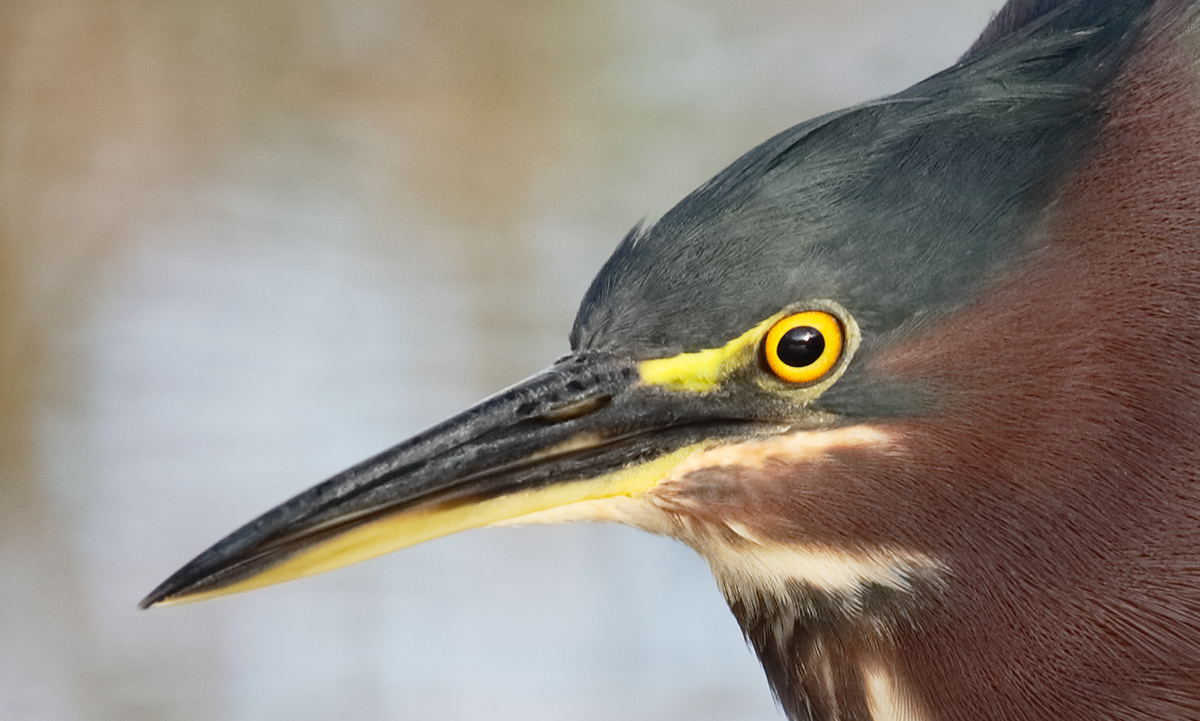
|
|
This is an unsharpened 100% crop of the Green Heron’s head.
|
600 II, 1D X, 2XIII TC Insanity
There are folks who state clearly that it is not possible to create a sharp image with a 1.4X teleconverter. There are others who state that 2X teleconverters are such garbage that nobody should ever own or use one. I doubt that any successful bird photographer uses their 2X TC as much as I use mine. On our recent Florida swing probably more than half of the thousands of images that I created were made with the 600 f/4 L IS II lens with the Extender 2X III in place. I am confident that I can make professionally sharp images on a consistent basis at shutter speeds as low as 1/60 sec. My success is due in part to the superb optics of all involved parties, to my nearly impeccable sharpness techniques, and to the great 4-stop Image Stabilization system of the new Series II Super-telephoto lenses. Not to mention stopping down from f/8 to f/11.
The best way to learn my sharpness techniques is to join us for an IPT. Next best is to study the section on Advanced Sharpness Techniques in The Art of Bird Photography II (ABP II: 916 pages, 900+ images on CD only).
Support the BAA Blog. Support the BAA Bulletins: Shop B&H here!
We want and need to keep providing you with the latest free information, photography and Photoshop lessons, and all manner of related information. Show your appreciation by making your purchases immediately after clicking on any of our B&H or Amazon Affiliate links in this blog post. Remember, B&H ain’t just photography!


 


Amazon
Everyone buys something from Amazon, be it a big lens or deodorant. Support the blog by starting your search by clicking on the logo-link below. No purchase is too small to be appreciated; they all add up. Why make it a habit? Because I make it a habit of bringing you new images and information on an almost daily basis.
Typos
In all blog posts and Bulletins, feel free to e-mail or to leave a comment regarding any typos, wrong words, misspellings, omissions, or grammatical errors. Just be right. 🙂
IPT Info
Many of our great trips are filling up. See especially info on the South Florida, Holland, and Nickerson Beach IPTs. Two great leaders on most trips ensure that you will receive individual attention, have all of your questions answered, and learn a ton including how to think like a pro, see the situation, and get the right exposure every time. In addition you will have fun, and make lots of great images. Click here for IPT details and general information.
February 2nd, 2014 And the Streak Continues
This post marks 68 days in a row with a new educational blog post, a record by far that should be extended for at least another week or so. Or not. 🙂 To show your appreciation, we ask that use our B&H and Amazon affiliate links for all of your B&H and Amazon purchases. Please check the availability of all photographic accessories in the BIRDS AS ART Online Store. We sell only what I use and depend on. We will not sell you junk. We know what you need to make creating great images easy and fun. And we are always glad to answer your gear questions via e-mail.
You can find the following items in the store: Gitzo tripods, Mongoose M3.6 and Wimberley heads, plates, low feet, and accessories, flash brackets, , Delkin e-film Pro Compact Flash Cards, LensCoat products, and our unique line-up of educational materials including ABP I & II, Digital Basics, Site and Set-up e-Guides, Canon and Nikon Camera Users and AF e-Guides, and MP-4 Photoshop video tutorials among others.
We would of course appreciate you using our B&H and Amazon affiliate links for all of your B&H and Amazon major gear, video, electronic, household, and personal purchases. For the photographic stuff mentioned in the paragraph above we would of course greatly appreciate your business.
Thanks and enjoy today’s blog post! This one took about 3 hours to assemble. I am feeling pretty good today with just a bit of hemming and hawing. We leave in 30 minutes for our last morning IPT session.
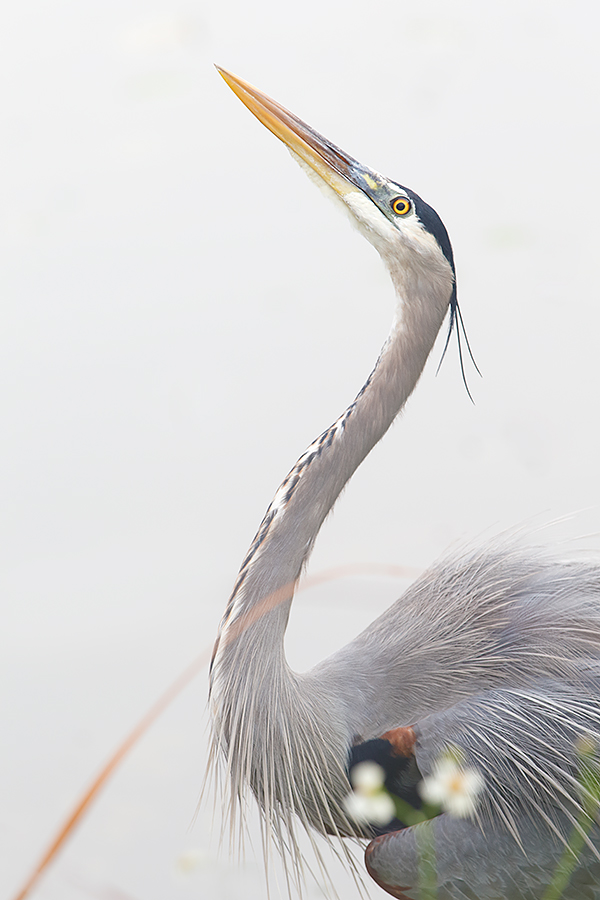
|
|
This displaying Great Blue Heron image was created with the with the Canon EF 70-200mm f/2.8L IS II USM zoom lens, the Canon 1.4x EF Extender III (teleconverter) (hand held at 280mm), and the Canon EOS-1D X. ISO 400. Evaluative metering +2 stops as framed: 1/160 sec. at f/5.6 in Manual mode.
61-Point AI Servo/Rear Focus AF active at the moment of exposure; three sensors in the upper left corner of the vertical AF array just caught the top of the bird’s bill. See the BreezeBrowswer screen capture below for the whole story on 61-Point AF. Click here if you missed the Rear Focus Tutorial. Click on the image to see a larger version.
|
The Before
As described briefly in yesterday’s blog post, “Can the Wrong Head Head Angle Be the Right Prey Angle?,” the group got to photograph a Great Blue Heron eating a gar; it was a great way to begin the Anhinga Trail IPT.
First, the live gar appeared magically on the asphalt. It appeared that it had just been captured (and then dropped) by the Great Blue Heron standing over it. Then a second GBH flew in and the 2 birds began doing their drooped wing threat displays at each other. Then a Black Vulture began toying with the fish. The dominant heron returned, dragged the fish into the grass, and finally picked it up and posed for an instant before flying to the opposite shore of Taylor Slough.
Black Rapid RS-7 Strap
Having my flight and action rig, the 70-200/1.4X III TC, and 1D X instantly available on my right shoulder via the RS-7 strap that I use was–as it always is–a Godsend. I simply dialed in +2 stops by adjusting the shutter speed and was good to go. Learn more about the Black Rapid RS-7 Strap or purchase one here. If you are using a camera body strap for the intermediate telephoto rig on your shoulder you might as well be strangling yourself….
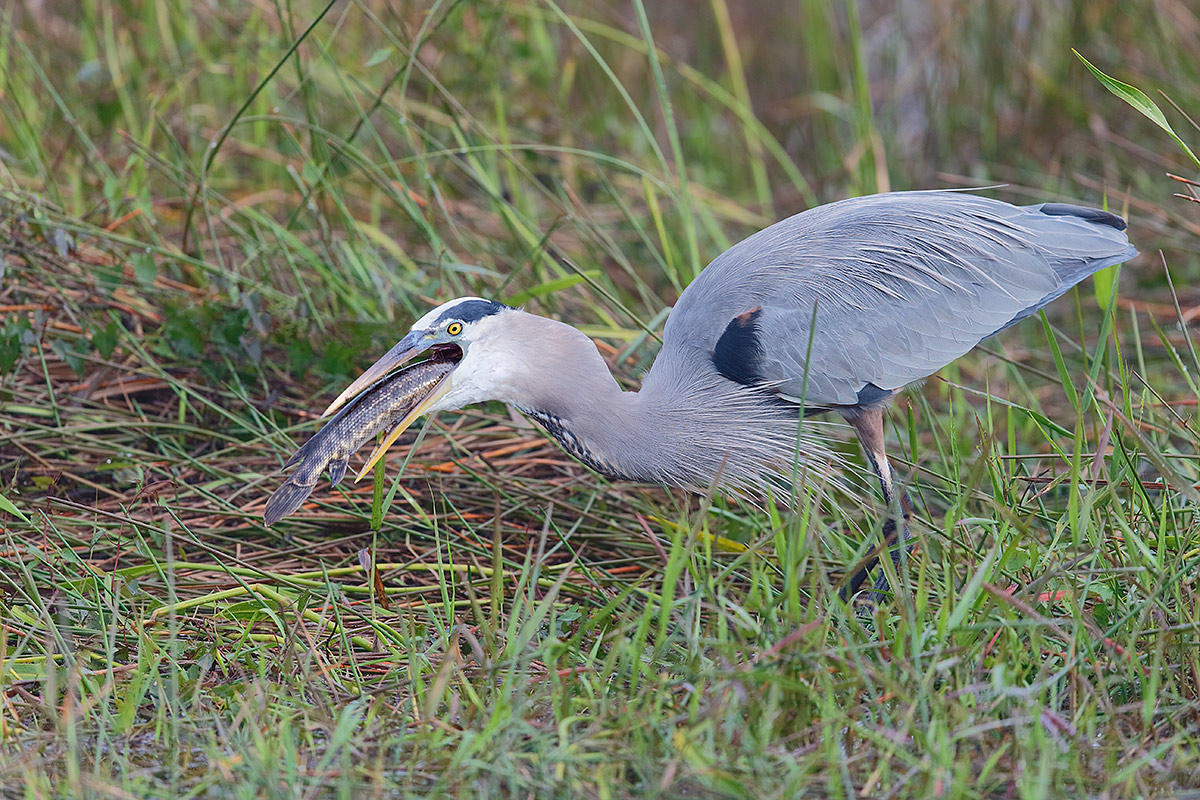
|
|
This image of a Great Blue Heron swallowing the gar was created on the Anhinga Trail IPT with the Gitzo 3532 LS carbon fiber tripod, Mongoose M3.6 head, the Canon EF 600mm f/4L IS II USM lens and the Canon EOS-1D X Digital SLR camera. ISO 400. Evaluative metering at zero: 1/500 sec. at f/4 in Manual mode.
One sensor to the right and one sensor above the Central Sensor/AI Servo/Rear Focus AF as framed active at the moment of exposure. Click here if you missed the Rear Focus Tutorial. Click on the image to see a larger version.
|
And the Aftermath…
While I think that I was the only one who made a good image of one of the displaying herons, everyone had a great chance to photograph the great blue picking up and eventually swallowing the rather large fish. As the scene unfolded Denise and I called out advice on choosing the best perspective, on exposure, and on selecting the best AF point. As above, it was a great way to begin the BAA/A Creative Adveneture Anhinga Trail Instructional Photo-Tour.
Image Questions
Would you have removed the strand of yellow grass that enters the frame from the lower left corner in the opening image? Do you like the flowers in that one?
Your Favorite?
Please take a moment to leave a comment and let us know which is your favorite of the 2 images. And as always, be sure to let us know why.
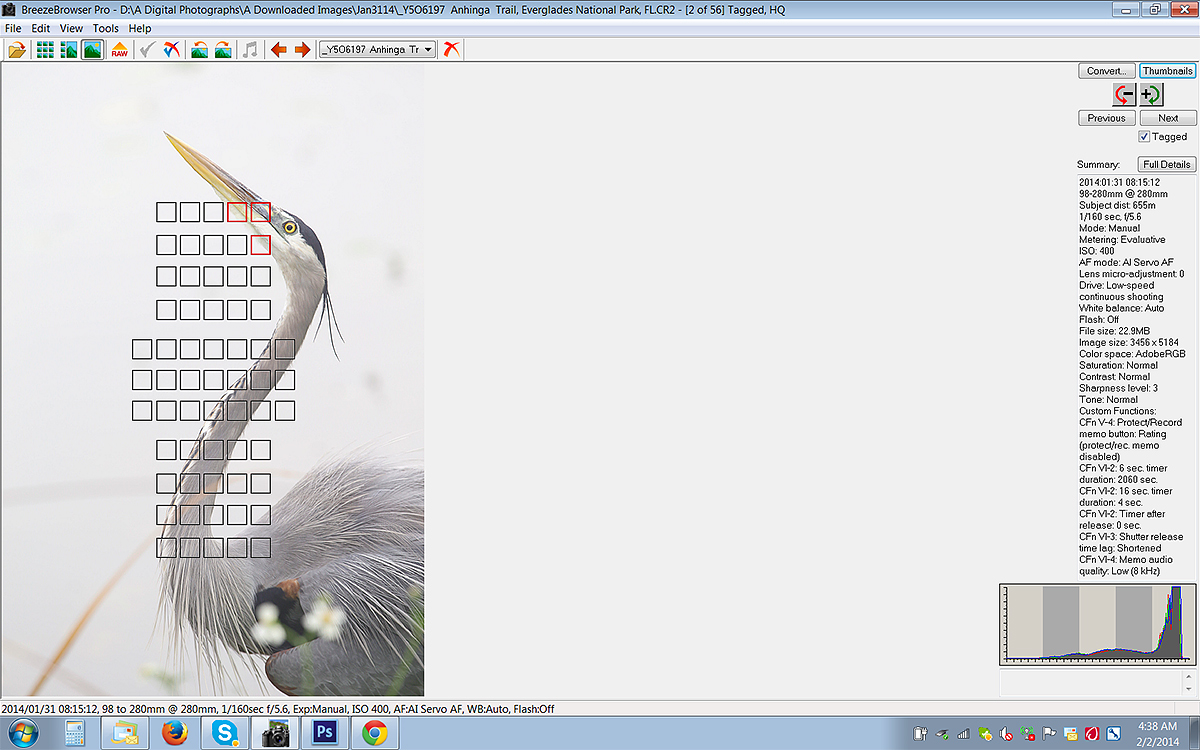
|
|
This is the BreezeBrowser Main View screen capture.
|
BreezeBrowser Main View Screen Capture
Above is the BreezeBrowser Main View screen capture for today’s image. Note that the illuminated red square shows the AF points that were active at the moment of exposure. See more on 61-Point AF immediately below.
Note: in Breezebrowser you need to check “Show Focus Points” under View to activate this feature. To see the focus points in DPP check “AF Point” under View or hit Alt L. Hit Alt M to see Highlight Alert. To learn how and why I use DPP (Canon Digital Photo Professional) to convert my RAW files, see the info on our DPP RAW Conversion Guide here.
Note the perfect histogram lots of data well into the rightmost histogram box. Regular readers know that I use and depend on BreezeBrowser every day of the year. It allows me to sort my keepers and delete the rejects faster than any other Windows browsing program. We use it on the main computer in the home office to catalog our images file-drawer style. And the companion program, Downloader Pro allows me to download my images quickly and conveniently. It automatically adds my IPTC data and the shooting location. I have it set up to create a folder named by the Month/date/year. The Breezebrowser/Downloader Pro combo saves me many hours each week. To learn more or to purchase this great PC only program, click here. As far as the BreezeBrowser/Downloader Pro Combo goes, if you are using a Windows platform and are not using these two great programs you are at best, wasting your valuable time. My understanding is that Photo Mechanic is best for Mac-users who do not opt to run Parallels or VM Ware fusion on their Macs so that they can enjoy the many advantages of BreezeBrowser. See BreezeBrowswer on a Mac for details.
61-Point AF
The more I use 61-Point AF with my 1D X and my 5D III bodies the more confident I become using it. As you see here, I it works superbly well with tall skinny vertical birds, especially with head and neck portraits. I absolutely love the “Orientation linked AF point” on both the 1D X and the 5D III. Here is a short free excerpt from the 1D X AF Guide:
On “AF4,” the fourth purple Menu (with the camera set to P, Tv, Av, or M):
Orientation linked AF point
I absolutely love this one. With it enabled (Select separate AF points, the 2nd choice), you can select one sensor or zone in a given AF Area Selection Mode when working in horizontal format and another different sensor (and even a different AF Area Selection Mode) when working vertically. The camera detects the orientation of the camera and “remembers” your AF settings for both horizontals and verticals. Remember that you must hold the camera vertically for your vertical settings to stick for that orientation (and vice versa).
For verticals I usually set 61-point automatic selection AF and manually select an AF point well above the central sensor so that I am ready for tall birds (or people) walking towards me at all times. For most horizontal shooting I set AF Surround with the central sensor selected.
The use and set-up for “Orientation linked AF point” is also detailed in the 5D III User’s Guide.
1D X AF Guide and 5D III User’s Guide
To learn everything that I know about the great 1D X AF system check out our 1D X AF Guide here. 5D Mark III users should check out our 5D III User’s Guide here to learn everything that I know about using this great, lightweight camera.
Support the BAA Blog. Support the BAA Bulletins: Shop B&H here!
We want and need to keep providing you with the latest free information, photography and Photoshop lessons, and all manner of related information. Show your appreciation by making your purchases immediately after clicking on any of our B&H or Amazon Affiliate links in this blog post. Remember, B&H ain’t just photography!


 


Amazon
Everyone buys something from Amazon, be it a big lens or deodorant. Support the blog by starting your search by clicking on the logo-link below. No purchase is too small to be appreciated; they all add up. Why make it a habit? Because I make it a habit of bringing you new images and information on an almost daily basis.
Typos
In all blog posts and Bulletins, feel free to e-mail or to leave a comment regarding any typos, wrong words, misspellings, omissions, or grammatical errors. Just be right. 🙂
IPT Info
Many of our great trips are filling up. See especially info on the South Florida, Holland, and Nickerson Beach IPTs. Two great leaders on most trips ensure that you will receive individual attention, have all of your questions answered, and learn a ton including how to think like a pro, see the situation, and get the right exposure every time. In addition you will have fun, and make lots of great images. Click here for IPT details and general information.
February 1st, 2014 And the Streak Continues
This post marks 67 days in a row with a new educational blog post, a record by far that should be extended for at least another week or two. Or not. 🙂 To show your appreciation, we ask that use our B&H and Amazon affiliate links for all of your B&H and Amazon purchases. Please check the availability of all photographic accessories in the BIRDS AS ART Online Store. We sell only what I use and depend on. We will not sell you junk. We know what you need to make creating great images easy and fun. And we are always glad to answer your gear questions via e-mail.
You can find the following items in the store: Gitzo tripods, Mongoose M3.6 and Wimberley heads, plates, low feet, and accessories, flash brackets, , Delkin e-film Pro Compact Flash Cards, LensCoat products, and our unique line-up of educational materials including ABP I & II, Digital Basics, Site and Set-up e-Guides, Canon and Nikon Camera Users and AF e-Guides, and MP-4 Photoshop video tutorials among others.
We would of course appreciate you using our B&H and Amazon affiliate links for all of your B&H and Amazon major gear, video, electronic, household, and personal purchases. For the photographic stuff mentioned in the paragraph above we would of course greatly appreciate your business.
Thanks and enjoy today’s blog post! This one took about 2 hours to assemble. I am feeling pretty close to normal today.
Can the Wrong Head Head Angle Be the Right Prey Angle?
In both of the images here the head of the wading bird is turned away from the viewer; the head angle would usually be thought of as poor.
The image above shows a Great Egret with what I believe to be some type of fish. I saw the capture and it was as strange as the creature itself. Half of the long, skinny prey item was sticking straight up out of the mud. It looked like a stick. Then the bird grabbed it, pulled it out of its hole, and worked at swallowing it for about a minute or so.
Had the bird turned its head more towards us in the image above, how would that have effected the rest of the image? Please be specific.
If anyone has an idea as to the true identity of the prey item, please let us know by leaving a comment.
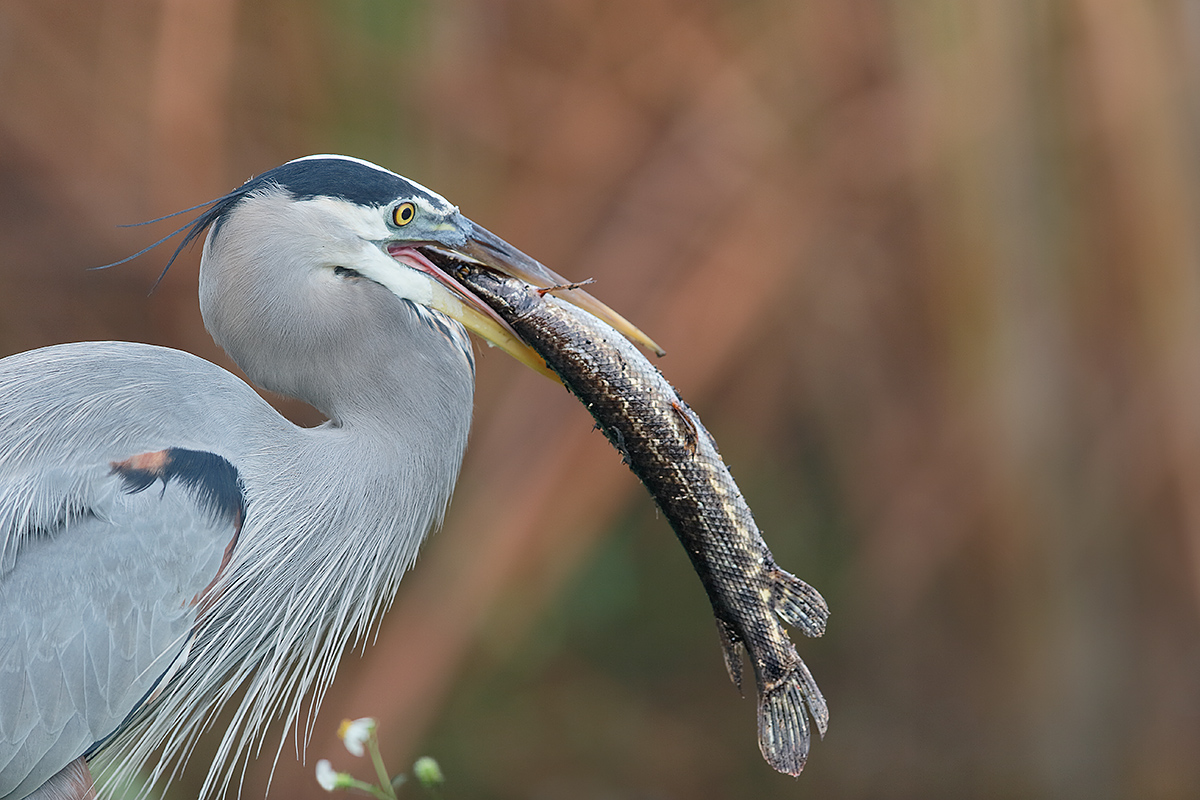
|
|
This Great Blue Heron with a gar was photographed this morning on the Anhinga Trail IPT with the Gitzo 3532 LS carbon fiber tripod, Mongoose M3.6 head, the Canon EF 600mm f/4L IS II USM lens and the Canon EOS-1D X Digital SLR camera. ISO 400. Evaluative metering -1/3 stop: 1/320 sec. at f/4 in Manual mode.
61-point/AI Servo/Rear Focus as framed active at the moment of exposure. Click here if you missed the Rear Focus Tutorial. Click on the image to see a larger version.
|
The Gar
Here, nobody in the group saw the capture. The gar was lying on the ground on the asphalt path at Anhinga Trail. Two great blues were disputing ownership with their beautiful wings drooped threat displays. In the meantime a Black Vulture tried to steal the fish without success. The gar flopped itself on the grass above Taylor Slough and finally the dominant GBH was able to pick it up. As I framed the image I was aware that the bird’s head was turned away slightly but I was so excited that I made three images and in retrospect am glad that I did. Then the bird turned slightly towards me so that the head was square to the camera. Inexplicably I waited just a moment for perfect to become more perfect and the bird took flight landing on the other side of the slough…. Please do not think that after 30+ years of doing this that I fail to get excited in instances like this.
In any case, had I pressed the shutter when the head angle was perfect for the bird how would that have effected the image as a whole?
Your Favorite?
Please let us know which of the two images (if either) you like best. And of course, let us know why.

|
|
Breathe deeply, bite the bullet, and live life to its fullest; we all get only one ride on the merry-go-round… Join me on this great trip.
Click on the image to enjoy a larger version.
|
The Southern Ocean…
I’ve been blessed. I’ve made three trips to the Southern Ocean, two extended trips that visited the Falklands, South Georgia, and the Antarctic Peninsula, and one to the Falklands and South Georgia. Each was a truly amazing experience. With three trips under my belt, I have a pretty good idea about how to make great images at each of the iconic landings. And I would love the chance to share my knowledge with you.
And I know from personal experience that if you are a photographer who is going to invest in Southern Ocean voyage that you will want to put your money on Cheesemans’. No other tour company goes so far out of their way to ensure making every possible safe landing. And no other tour company will have you spending more time on land. Here, from the” Way to Go CES! (Cheeseman’s Ecology Safaris)” blog post here, is one of my favorite Cheesemans’ stories:
The landing at Bailey Head, Antarctica, was especially rewarding to me as I had been sitting in a zodiac 100 yards off shore on my 2007 trip when the zodiac in front of mine swamped and the captain of the ship called off the landing…. Early that day it looked as if my weather Karma might not be working. Ted’s “Good morning shipmates” was followed by the news that we would not be able to land at Bailey Head that morning as the swell was too big. The beach there is sloped tremendously and the sea strives to pull the zodiacs back into the ocean before folks have gotten off with their gear. Tom Murphy had said to me several days before, “We will get you on the beach at Bailey Head.” Ted concluded his morning greetings by saying, “We are sending out a scout team to see if landing is possible.”
After breakfast I was thrilled to hear Ted’s voice again on the PA, “We will be landing at 8am.” Afterwards folks noted that it was the calmest landing ever at this amazingly beautiful spot. My good weather Karma (courtesy of late-wife Elaine) had come through one last time. Along with St. Andrews Bay, it was one of my two favorite super-great once-in-a-lifetime days of the trip. And we even got to enjoy three additional hours at Hannah Point, Antarctica before calling it a wrap and heading for the feared Drake Passage. All thanks to Cheesemans’ Ecology Safaris.
Why Sign Up Through BIRDS AS ART?
If you have been thinking and dreaming of finally visiting South Georgia and Antarctica, this is the trip for you. Quit dreaming and act now. Though I will not be an official leader on this trip, those who have traveled with me know that I cannot help but teach. I will make pre-trip gear recommendations. I will hold informal pre-landing briefings. In the same vein, everyone will receive a free copy of our Antarctica Site Guide once they are paid in full (August 15, 2014). I will be available on the ship to review your images,, answer questions, and conduct informal over-the shoulder Photoshop sessions. And best of all everyone who signs up under the auspices of BAA are invited to tag along with me on the landings where I will be glad to offer invaluable in-the-field advice. And the same goes for the ship-board birds in flight and marine mammal photography opportunities.
Do join us. To learn how to be part of the BAA group please e-mail me with the words Antarctica/Extended Expedition BAA Info Please cut and pasted into the Subject line.
The Cheesemans’ Ecology Safaris Antarctica/The Extended Expedition Voyage
Antarctic Peninsula, South Georgia and Falkland Islands: December 13, 2014 to January 10, 2015
From the CES website:
Join us on a voyage of discovery to an awe-inspiring world devoted to nature, wildlife, science, and peace. This expedition will have you completely captivated, from the stunning vistas of Tierra del Fuego to the busy penguin rookeries of the Falklands, from the dramatic landscapes of South Georgia to the ice-covered terrain of the Antarctic. Board the comfortable, safe and newly upgraded Ortelius for an expedition offering an unparalleled 17 landing days in the Southern Ocean. Our voyage includes three days in the Falklands with a huge diversity of species, six days at South Georgia Island, the all but undiscovered rugged land of towering mountains and thriving colonies of penguins, seals, and albatross, one day at the South Orkneys with nesting Snow Petrels, and seven days along the Antarctic Peninsula, the wonderland of ice and inconceivably vibrant polar wildlife. During days at sea, our naturalists on the ship’s bridge and stern share sightings of whales and seabirds, including many of the world’s species of albatross. Maximum time both on shore and Zodiac cruising will be available for photography, wildlife experiences, and exploring the landscapes of the great Southern Ocean. Our priority is assuring the most in-depth wildlife experience in the Antarctic, an experience made possible by our excellent itinerary and committed expedition staff.
I can personally attest to the accuracy of everything above. 🙂
Additional Links
Learn about the global ocean here.
Antarctic Inspiration from Paul Mckenzie here.
Way to Go CES! (Cheeseman’s Ecology Safaris) here.
Or simply type any of the following words or phrases in the little white search box on the top right of this page, hit Search, and follow the links: penguin; Antarctica; South Georgia; Falklands. Have fun.
The Pull is Too Strong…
The pull is too strong. I need to go back. And I am. Do join me for an unparalleled wildlife and scenic photography experience. Please e-mail for additional information.
Questions?
I’d be glad to answer all of your Southern Ocean/Falklands/South Georgia/Antarctica questions. Please leave a comment if you’d like to learn more.
Support the BAA Blog. Support the BAA Bulletins: Shop B&H here!
We want and need to keep providing you with the latest free information, photography and Photoshop lessons, and all manner of related information. Show your appreciation by making your purchases immediately after clicking on any of our B&H or Amazon Affiliate links in this blog post. Remember, B&H ain’t just photography!


 


Amazon
Everyone buys something from Amazon, be it a big lens or deodorant. Support the blog by starting your search by clicking on the logo-link below. No purchase is too small to be appreciated; they all add up. Why make it a habit? Because I make it a habit of bringing you new images and information on an almost daily basis.
Typos
In all blog posts and Bulletins, feel free to e-mail or to leave a comment regarding any typos, wrong words, misspellings, omissions, or grammatical errors. Just be right. 🙂
IPT Info
Many of our great trips are filling up. See especially info on the South Florida, Holland, and Nickerson Beach IPTs. Two great leaders on most trips ensure that you will receive individual attention, have all of your questions answered, and learn a ton including how to think like a pro, see the situation, and get the right exposure every time. In addition you will have fun, and make lots of great images. Click here for IPT details and general information.
|
|






